

Back to Guides
How to run a problem-solving workshop.

What is a problem-solving workshop?
A problem-solving workshop is a rapid session that helps you:
- Understand the root cause of a problem
- Quickly generate ideas to solve it
- Evaluate the ideas to ensure they’re robust
- Make a plan to test or implement the solution
This workshop critically assesses what’s going wrong and helps you find out what your options are to solve it, before you decide on the perfect solution.
Who should run a problem-solving workshop?
Product team leads, such as designers, product managers or engineers can run this type of workshop. There’s no one right person to lead something as important as this.
In fact, the core of your product development should start with the problem rather than the solution itself. It can be tempting to jump straight into features, but until you understand the problem well, you can’t begin to solve it.
When to run a problem-solving workshop
This workshop can be used in various circumstances:
- A show-stopping problem that grinds everything to a halt
- An intermittent problem that you want to get to the bottom of
- A customer or user problem, such as a pain point when using a service or product
- A high-level business problem, for example “too many customer complaints”, “conversion rate is too low”, or “operating costs are too high”
1. Get the right people together
2. identify the right problem.
- 3. Come up with ideas to solve the problem
4. Evaluate the ideas to ensure they’re robust
5. make a plan to test or implement the solution.
Read on to find out how to do all that, and more.

Invite all affected parties to a session. These are people that the problem has a direct impact on. Including those that aren’t impacted may offer a more objective view, but ultimately; more people equals more time. We want to solve problems with haste, so we can find out if it’s the right solution sooner rather than later!

What may appear like the problem, could be one of many observable results of a deeper underlying problem. To identify the ‘right’ or ‘true’ problem, we need to delve into it. This method is often called “Root Cause Analysis”.
There are many ways to conduct a Root Cause Analysis, but the easiest and most pragmatic way is to use the Five Whys Analysis tactic .
Simply put, asking “why?” at least five times will lead you to the real problem. Solving this root problem subsequently solves all of the surface problems associated with it.
Learn how to run the Five Whys Analysis tactic
3. Come up with ideas to solve your problem

What normally follows identifying the right problem is a flurry of ideas. This usually takes the form of blurting them out at each other – but there are better, more structured ways to capture ideas. Generating ideas in a structured way gives you time and space to think, as well as building on others’ ideas. The result means more thorough and refined ideas, over a back of the napkin sketch that the loudest person in the room decides is the best thing to do.
Idea-generation tactics for problem solving:
- Mind Map – Get your brain on to paper, so you can start to form ideas for the methods below.
- Crazy Eights – Eight ideas in eight minutes
- Reverse Brainstorm – Come up with ways to make the problem worse, then reverse it to get the solution
- Round Robin – Generate an idea, then have the person next to you build on it
- Storyboard – Turn your idea into a sequence of events to understand how it might actually work in reality
Once you have a suite of ideas, you’ll want to review them and try some evaluative tactics .
If you have a lot of ideas, you might want to prioritise the most promising ones to take forward with a decision tactic such as Priority Map or Blind Vote .
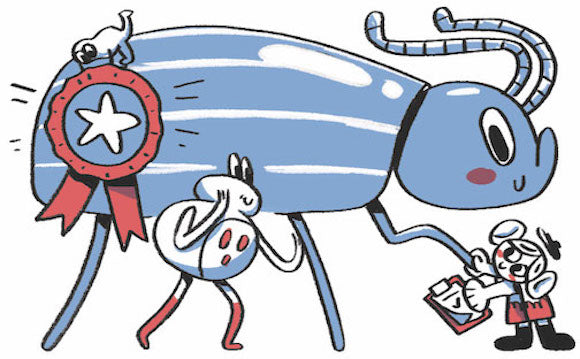
Once you have a shortlist of ideas it can be tempting to go with the one that appears most promising. If time is of the essence, and it’s low risk – it might be the right call to just try it out.
However, it’s vital to evaluate ideas for solutions that may be more costly or complicated. Kick the tyres, so to speak.
Evaluating ideas gives you the confidence that your promising idea truly is promising, and is worthy of taking forward to the next stage: prototyping and implementation.
Evaluation tactics for ideas:
- Idea Beetle – a set of questions that help you assess if your idea is robust before you progress with it
- Rose, Thorn, Bud – a way to review the good, the bad and the potential of an idea
- SWOT Analysis – articulate an idea’s strengths, weaknesses, opportunities or threats
If you still have a lot of ideas, you might want to prioritise the most promising ones to take forward with a decision tactic such as Priority Map or Blind Vote .

Now you should have one or two (or more!) evaluated, robust and promising ideas that you want to try out to solve the problem.
Whether you need to work out how to prototype and test the idea, or go ahead and implement the solution right away – you need a plan.
To work out a plan, use the Sticky Steps tactic , which mentally starts you off at having the solution implemented or prototype tested, then works backwards to today in order to see what steps you need to take.
Once you have a solid plan, create accountability by creating a list of tasks to do, and assigning them to people with a deadline. You can do this with the Who, What, When tactic .
2 thoughts on “How to run a problem-solving workshop”
Hi I’d love to know approx about how long it should take to run one of these workshops. If you could include that in your very helpful summaries – I think that would be very helpful to plan and market these types of servies.
Appreciate all you do! R
All activities are very helpful.
Appreciate you Nazia Psychologist
Leave a Comment Cancel reply
Let us know what thoughts or questions you have about this guide so we can improve it.
If you leave us your email, we'll let you know if we update this guide based on your feedback.
- Shop Card Decks
- Video Libary
Engineering , Leadership , User experience , User experience , Product management
Problem-Solving Workshop
A collaborative learning environment designed to help participants develop skills to identify and solve problems. product glossary problem-solving workshop also called: problem-solving session and problem-solving exercise see also: how might we , hypothesis statement , premortem , problem statement , six thinking hats , swot analysis , affinity diagram , circles method , design thinking , jobs-to-be-done framework (jtbd) relevant metrics: attendance and engagement, pre- and post-workshop assessments, goal achievement, participant satisfaction, knowledge retention, application of skills, networking and collaboration, and commitment to continuous improvement in this article what is a problem-solving workshop.
A Problem-Solving Workshop is a collaborative event in which a group of people come together to identify and solve a problem. It is a structured process that involves brainstorming, analyzing, and developing solutions to a problem. A problem-solving workshop is a rapid session that helps you:
- Unlocking the Core of the Issue . A problem-solving workshop serves as an accelerated session designed to delve into the underlying cause of a dilemma, enabling participants to better comprehend its complexities.
- Generate ideas . With a deeper understanding of the problem at hand, participants rapidly brainstorm potential solutions. They then carefully assess these ideas, ensuring their feasibility and effectiveness in addressing the issue.
- Evaluating ideas . Participants scrutinize their proposed ideas, determining their robustness and ability to withstand potential challenges to ensure that only the most viable and reliable solutions are considered for implementation, enhancing the likelihood of successfully resolving the problem.
- Make a plan to test or implement . Equipped with a well-rounded perspective and carefully evaluated solutions, the workshop empowers attendees to devise a strategic plan for testing or implementing their chosen resolution, ultimately guiding them toward the ideal solution to their problem.
The workshop typically begins with a discussion of the problem and its context. Participants then brainstorm potential solutions and evaluate them based on their feasibility and potential impact. After the brainstorming session, the group works together to develop a plan of action to address the problem. This plan may include changes to existing processes, new procedures, or other solutions.
The Problem-Solving Workshop is an effective way to identify and solve problems in the context of Product Management and User Experience. It allows for a collaborative approach to problem-solving, which can lead to more creative and effective solutions. It also allows for a structured approach to problem-solving, which can help ensure that the problem is addressed in a timely and efficient manner.
Where did Problem-Solving Workshops come from?
The idea of coming together to solve problems can be traced back to ancient human societies that held gatherings to discuss issues and find solutions. In modern times, problem-solving workshops have been shaped by developments in various fields like psychology, education, management, design, and innovation.
Some significant influences on problem-solving workshops include:
- Brainstorming . Alex Osborn, an advertising executive, introduced brainstorming in the 1940s as a group creativity technique to generate ideas and solve problems. This method encouraged people to share their ideas freely, no matter how wild, and suspend judgment during the idea-generation process. Brainstorming has since been incorporated into many problem-solving workshops.
- Quality circles . In the 1960s, Japanese companies introduced quality circles, which are small groups of employees who meet regularly to discuss and solve work-related problems. These circles aimed to improve the quality of products and processes by involving employees in problem-solving and decision-making. The concept of quality circles has inspired many problem-solving workshops in various industries.
- Design thinking . The design thinking methodology, pioneered by companies like IDEO and Stanford University’s d.school, has played a crucial role in shaping modern problem-solving workshops. Design thinking is a human-centered approach to problem-solving that encourages empathy, experimentation, and collaboration. It involves a series of steps, such as empathizing, defining, ideating, prototyping, and testing, which can be adapted to various problem-solving workshop formats.
- Lean and Agile methodologies . Lean and Agile methodologies, which originated in the manufacturing and software development sectors, respectively, have also influenced problem-solving workshops. These approaches emphasize collaboration, continuous improvement, and rapid iteration to achieve better results.
- Facilitation techniques . The growth of professional facilitation has also impacted problem-solving workshops. Skilled facilitators use various tools and techniques to guide groups through problem-solving processes, ensuring that the workshop’s objectives are met and that participants stay engaged and focused.
Why should I conduct a problem-solving workshop?
Conducting a problem-solving exercise can be beneficial in several ways. It can help individuals or teams to:
- Identify the root cause of a problem . By engaging in a structured problem-solving exercise, participants can gain a deeper understanding of the issue and identify the underlying causes.
- Generate new ideas and solutions . By brainstorming and evaluating various solutions, individuals or teams can develop creative and effective solutions that they may not have thought of otherwise.
- Encourage collaboration and teamwork . Collaborative problem-solving exercises can foster a sense of teamwork and create a shared sense of ownership and responsibility for the problem and the solution.
- Improve decision-making . By evaluating various options and considering different perspectives, participants can make informed and effective decisions that take into account a wide range of factors.
- Enhance learning and development . Problem-solving exercises can provide opportunities for individuals or teams to learn new skills, practice critical thinking, and develop problem-solving abilities that can be applied to future challenges.
How to run a problem-solving workshop
Step 1: assemble a well-rounded team.
Gather individuals with diverse backgrounds, skill sets, and perspectives who are relevant to the problem at hand. This may include team members, cross-functional collaborators, subject matter experts, or stakeholders. A diverse group will enhance the ideation process and facilitate a more comprehensive understanding of the issue.
Consider the following factors:
- Diversity . Assemble a team with a mix of expertise, backgrounds, perspectives, and roles relevant to the problem. Diversity encourages creative thinking and helps avoid groupthink or blind spots.
- Relevant stakeholders . Ensure that key stakeholders, including decision-makers, subject matter experts, and those directly affected by the problem, are included in the workshop. Their insights and buy-in are crucial for the success of the proposed solutions.
- Size of the group . Aim for a group size that allows for effective collaboration and communication. Ideally, the group should be large enough to generate a variety of ideas but small enough to facilitate productive discussions. Typically, a group of 6-10 participants is considered optimal for a problem-solving workshop.
- Team dynamics . Select participants who are open-minded, willing to collaborate, and capable of engaging in constructive discussions. The right balance of personalities is essential for fostering a positive atmosphere and effective teamwork.
- Establish clear roles . Assign roles and responsibilities to participants, such as a facilitator to guide the workshop, a timekeeper to monitor progress, and a note-taker to document key points and decisions. Clearly defined roles help ensure the smooth flow of the workshop.
- Preparation . Communicate the workshop’s purpose, goals, and expectations to participants beforehand. Encourage them to familiarize themselves with the problem and come prepared with any relevant data or insights. This will enable a more focused and productive discussion during the workshop.
Step 2: Establish the Objective and Scope
Clearly define the purpose and goals of the workshop. Ensure that all participants understand the problem to be addressed, its context, and any constraints or limitations. Set a time limit for the workshop to maintain focus and efficiency.
Consider the following:
- Preparation and research . A facilitator should be well-prepared with a thorough understanding of the problem, its context, and the workshop’s objectives. This may involve conducting research, reviewing relevant materials, and consulting with key stakeholders or subject matter experts beforehand.
- Active listening . Practice active listening during the workshop to ensure participants feel heard and understood. Encourage questions and clarifications to address any misunderstandings or ambiguities regarding the problem, scope, or objectives.
- Flexibility and adaptability . Be prepared to adjust the workshop’s objectives or scope if new information or insights emerge during the discussion. Maintain an open-minded approach and adapt to the needs of the group while ensuring that the workshop remains focused and productive.
- Time management . Monitor the workshop’s progress and allocate time appropriately for each stage. If necessary, intervene to refocus the discussion, maintain momentum, or transition to the next step in the problem-solving process.
Each of the following workshop exercises can contribute to the success of establishing a clear objective and scope by helping participants gain a deeper understanding of the problem, its context, and the needs of those affected, leading to a clearer definition of the objective and scope:
- Six Thinking Hats . This exercise, developed by Edward de Bono, encourages participants to approach the problem from six different perspectives, represented by metaphorical “hats.” These perspectives are: facts and information (white hat), emotions and feelings (red hat), cautious and critical thinking (black hat), optimistic and positive thinking (yellow hat), creative and alternative thinking (green hat), and process and organization (blue hat). This technique can help the group establish a more comprehensive understanding of the problem, its context, and potential constraints, leading to a clearer definition of the objective and scope.
- Stakeholder Mapping . In this exercise, participants identify and analyze the key stakeholders involved in or affected by the problem. This helps the group understand the different perspectives, priorities, and needs of these stakeholders, providing valuable context for the problem-solving process. By considering stakeholder needs and concerns, the workshop can better define the objective and scope while ensuring that potential solutions address relevant issues.
- Empathy Mapping . This exercise helps participants gain insight into the needs, motivations, and challenges of the individuals affected by the problem, such as customers, users, or team members. By creating an empathy map, the group can better understand the problem from the perspective of those who are directly impacted. This understanding can help the group establish a clearer and more focused objective and scope for the workshop, ensuring that potential solutions address the most critical concerns of the affected individuals.
Step 3: Identify the Right Problem and Root Cause
Begin the workshop by collectively discussing the problem to gain a deeper understanding of its nuances. Use techniques like the 5 Whys or Fishbone Diagram to identify the root cause of the problem, ensuring that the team’s efforts are directed towards solving the underlying issue rather than merely addressing symptoms.
Approach this step with a well-defined strategy that guides participants through the process of understanding the problem and its underlying factors. The facilitator plays a pivotal role in creating an environment that encourages open and honest dialogue, allowing participants to share their insights and collectively work towards identifying the root cause.
Strike a balance between allowing sufficient time for discussions and ensuring that the workshop maintains momentum and stays on track. The facilitator may need to intervene occasionally to refocus the conversation or steer the group towards the desired outcome.
Be prepared to adapt to the evolving dynamics of the workshop. They must be flexible and responsive to new insights or challenges that emerge during the discussions. If necessary, the facilitator may need to adjust the workshop’s objectives, scope, or methodology to ensure that the group remains focused on addressing the problem’s root cause.
Consider using one of these workshop exercises to identify the right problem:
- Five Whys . This technique involves asking “Why?” repeatedly to dig deeper into the problem and uncover the root cause. By using this approach in the workshop, participants can move beyond surface-level symptoms to identify the true source of the issue. The facilitator can guide the group through the Five Whys exercise, ensuring that the discussion stays focused and productive.
- Fishbone Diagram . Also known as the Ishikawa or cause-and-effect diagram, this tool visually represents the relationship between a problem and its potential causes. Participants brainstorm and categorize potential causes into distinct branches, which can help the group identify the root cause. The facilitator can lead the group through the Fishbone Diagram exercise, encouraging them to consider various aspects of the problem and promoting a comprehensive understanding.
- Round Robin . This brainstorming technique involves giving each participant a chance to contribute an idea or perspective on the problem in a structured and organized manner. This ensures equal participation and helps to gather diverse insights. Using the Round Robin method, the facilitator can facilitate discussions on the problem’s root cause by encouraging participants to share their thoughts and perspectives without interruption.
- Force Field Analysis . This exercise helps participants identify the driving and restraining forces that influence a problem. By analyzing these forces, the group can gain a deeper understanding of the underlying factors contributing to the issue. The facilitator can guide participants through the Force Field Analysis, helping them to identify and assess the various forces at play and facilitating discussions on how these forces might relate to the root cause of the problem.
Step 4: Generate Ideas to Solve the Problem
Encourage participants to brainstorm solutions, emphasizing the importance of open-mindedness and creativity. Utilize techniques like mind mapping, round-robin, or the six thinking hats to foster an environment conducive to idea generation. Ensure that all participants have an opportunity to share their thoughts, and discourage judgment or criticism during this stage.
Make sure that all participants feel comfortable sharing their ideas, no matter how unconventional they may seem. This requires the facilitator to create a non-judgmental and supportive atmosphere that promotes inclusivity and equal participation.
One critical aspect for the facilitator is the use of various brainstorming techniques and ideation exercises that can stimulate creative thinking and encourage diverse perspectives. By employing a mix of individual and group activities, the facilitator can cater to different thinking styles and preferences, ensuring that everyone contributes to the ideation process.
These workshop exercises are great for generating ideas to solve the problem you identified:
- Mind Mapping . This technique helps to visually organize information around a central concept, allowing participants to generate ideas in a structured manner. It encourages them to think about the problem from different perspectives and make connections between seemingly unrelated ideas, which can lead to creative solutions.
- Crazy Eights . In this exercise, participants are given eight minutes to sketch out eight different ideas on a piece of paper. The time constraint forces them to think quickly and encourages them to generate a wide variety of ideas. By sharing and discussing their sketches afterward, the group can build upon each other’s ideas and develop more innovative solutions.
- Reverse Brainstorming . This technique prompts participants to think about the problem from an opposite perspective, by asking them to come up with ways to make the situation worse. By challenging conventional thinking, reverse brainstorming helps uncover new insights and approaches that may not have been considered otherwise.
- How Might We . This exercise frames the problem as an open-ended question, starting with the phrase “How might we…?”. This positive and optimistic framing encourages participants to think creatively and generate ideas without constraints. The open-ended nature of the question also promotes collaboration, as participants can build on each other’s ideas to find innovative solutions.
- Forced Analogy . In this exercise, participants are asked to draw analogies between the problem at hand and unrelated objects or scenarios. This encourages them to think about the problem from a new perspective and come up with creative ideas that they may not have considered otherwise. The forced analogy technique can reveal hidden connections and inspire innovative solutions.
- SCAMPER . This is an acronym for Substitute, Combine, Adapt, Modify, Put to another use, Eliminate, and Reverse. Participants are prompted to think about the problem and generate ideas using each of these seven approaches. The SCAMPER technique encourages participants to look at the problem from different angles and find unique solutions.
Step 5: Evaluate and Refine Ideas
Once a range of potential solutions has been generated, evaluate their robustness and viability. Encourage participants to consider potential challenges, drawbacks, and risks associated with each idea. Use a decision matrix, SWOT analysis, or other evaluation tools to help compare and prioritize the proposed solutions.
Seek to create an environment where participants feel comfortable sharing their opinions and ideas while also being open to constructive feedback. The facilitator must balance encouragement and critical thinking, promoting an atmosphere where ideas are assessed objectively, and their merits and drawbacks are examined thoroughly.
Be aware of any biases, power imbalances, or dominant personalities that may influence the evaluation process. By skillfully navigating these dynamics, the facilitator can ensure that all voices are heard and that the evaluation process remains objective and fair.
These workshop exercises are great for evaluating and refining ideas.
- SWOT Analysis . This exercise requires participants to analyze the strengths, weaknesses, opportunities, and threats associated with each proposed solution. By conducting a SWOT Analysis, the group can thoroughly evaluate the viability and potential impact of each idea, identifying potential challenges and opportunities.
- Pros and Cons . In this exercise, participants list the advantages and disadvantages of each proposed solution. This method encourages participants to think critically about the potential outcomes of each idea, enabling the group to make a more informed decision.
- Poster Session . In this exercise, each proposed solution is presented on a poster, and participants are given time to review and provide feedback on each idea. The Poster Session promotes thoughtful consideration of each solution and allows for open discussion and collaborative evaluation.
- Plus/Delta . This exercise involves participants identifying the positive and negative aspects of an idea or solution. It can help to refine ideas by focusing on the strengths and weaknesses of each one.
- Affinity Mapping . This exercise involves grouping similar ideas together and can help to identify common themes and patterns. It can help to refine ideas by clarifying the relationships between different solutions.
- Assumptions Collection . This exercise involves identifying assumptions that have been made about the problem or solution and testing them to see if they are valid. It can help to refine ideas by identifying any flawed assumptions and correcting them.
- Force Field Analysis . This exercise involves identifying the forces that are supporting and opposing a proposed solution. It can help to refine ideas by addressing the barriers and challenges that need to be overcome for the solution to be successful.
By incorporating these workshop exercises, participants can thoroughly evaluate the proposed ideas to ensure they are robust and viable. These
Step 6: Select the Best Solution
As a group, decide on the most promising solution(s) based on the evaluation process. Discuss the reasoning behind the selection and ensure that all participants are on board with the decision.
To promote objectivity, encourage the use of predefined criteria or frameworks for evaluating the proposed solutions. By providing a structured approach to decision-making, participants will be better equipped to weigh the pros and cons of each idea, ultimately leading to a more informed choice.
This will also help you maintain a neutral stance throughout the selection process, allowing the group to discuss and debate the merits of each solution without bias. As a facilitator, your goal is to ensure that the group focuses on the problem at hand and avoids getting sidetracked by personal preferences or interpersonal conflicts.
If you see that the group is struggling to reach a consensus, you might need to guide them toward a decision. By summarizing the key points of the discussion and highlighting the most promising solutions, the facilitator can help the group make a well-informed decision that best addresses the problem.
The following workshop exercises are great for facilitating the selection process:
- Dot Voting . This method helps participants prioritize solutions by giving them a limited number of dots or stickers that they can distribute among the proposed ideas. The solutions with the most votes are considered the most promising and can be further discussed or refined.
- Fist to Five . This technique allows the group to quickly gauge the level of support for each solution. Participants indicate their level of agreement by raising a certain number of fingers (1 to 5), with five fingers signifying strong support. The solutions with the highest average scores are deemed the most favorable.
- Stack Ranking . In this exercise, participants rank the proposed solutions in order of preference, assigning a unique position to each idea. The facilitator then tallies the rankings and determines the overall order of preference for the group. This helps identify the top solutions based on collective input.
- Trade-off Sliders . This method encourages participants to consider the pros and cons of each solution by using sliders to represent various criteria, such as cost, time, or quality. Participants adjust the sliders to visually represent the trade-offs they are willing to make, and the facilitator synthesizes the results to identify the most viable solutions.
- SWOT Analysis . By evaluating each solution’s strengths, weaknesses, opportunities, and threats, participants can gain a comprehensive understanding of the potential outcomes and risks associated with each idea. This structured analysis helps the group make a more informed decision about which solution is best suited to address the problem.
- Decision Matrix . The facilitator creates a matrix with the proposed solutions as rows and the evaluation criteria as columns. Participants then score each solution based on how well it meets the criteria. The solution with the highest total score is considered the best option. This method promotes objective decision-making and allows for a clear comparison of the proposed solutions.
- Priority Mapping . This technique involves visually mapping ideas based on their importance and urgency. By using Priority Mapping, the group can quickly identify the most critical and time-sensitive ideas, ensuring that the most pressing solutions are prioritized for implementation.
Step 7: Develop a Plan for Implementation or Testing
With the chosen solution(s) in hand, create a detailed plan outlining the steps required for implementation or testing. Assign responsibilities, establish deadlines, and set milestones to ensure accountability and progress. Consider creating a pilot project or running tests to validate the effectiveness of the solution before a full-scale implementation.
Seek to guide the group in setting realistic timelines and defining clear roles and responsibilities. This involves promoting open communication, ensuring that everyone’s input is valued, and addressing any concerns that may emerge.
You might also consider to spend time establishing key metrics for monitoring success and setting up checkpoints to evaluate the success of the implementation, enabling the team to learn from their experiences and iterate on the solution as necessary.
The following workshop exercises work great for exploring an creating an implementation plan.
- Project timeline . A project timeline is an effective way to help the team map out the key milestones, tasks, and deadlines involved in implementing the chosen solution. It allows the team to visualize the project’s overall progress and identify potential issues that may arise during the implementation process.
- Future-Back Planning . Future-Back Planning is a technique that helps the team envision what success will look like in the future and work backward to identify the necessary steps to achieve that success. This approach can help the team develop a clear vision and strategy for implementing the solution.
- RACI Matrix . A RACI Matrix is a tool that can be used to clarify roles and responsibilities during the implementation process. It helps ensure that each team member understands their role in the project and can help prevent confusion or misunderstandings.
- Dependency Map . A Dependency Map is a visual tool that helps the team identify the interdependencies between different tasks or components of the project. This can help the team develop a more realistic and feasible plan for implementing the solution.
- Sailboat . The Sailboat exercise can be used to help the team identify potential obstacles or challenges that may arise during the implementation process. It involves visualizing the solution as a sailboat and identifying the factors that may help or hinder its progress towards the desired destination. This exercise can help the team proactively address any potential roadblocks and develop a plan to overcome them.
Step 8: Follow Up and Iterate
After the workshop, monitor the progress of the solution’s implementation or testing. Gather feedback, evaluate results, and make any necessary adjustments or refinements. Encourage open communication among participants, and consider scheduling follow-up meetings to review progress and address any emerging challenges.
The solution that was chosen may need to be adjusted or refined based on feedback or unexpected challenges that arise. As a facilitator, you should encourage team members to share their thoughts and ideas and foster an environment where experimentation and iteration are encouraged.
Find ways celebrate successes and acknowledge the efforts of the team throughout the process. This can help maintain morale and motivation for continued improvement and innovation.
Typical pitfalls when running a Problem-Solving Workshop
- Finding the Right Facilitator . Finding a facilitator who is knowledgeable and experienced in problem-solving techniques can be a challenge. It is important to find someone who can effectively lead the workshop and ensure that all participants are engaged and productive.
- Establishing Clear Goals . Establishing clear goals for the workshop is essential for its success. Without a clear understanding of the objectives, it can be difficult to ensure that the workshop is productive and successful.
- Creating an Engaging Environment . Creating an engaging environment for the workshop is key to its success. Participants need to feel comfortable and be able to focus on the task at hand.
- Managing Time . Time management is essential for a successful workshop. It is important to ensure that the workshop is structured in a way that allows for productive discussion and problem-solving.
- Ensuring Participation . Ensuring that all participants are actively engaged in the workshop is essential. It is important to create an environment where everyone feels comfortable to contribute and share their ideas.
Google is known for its commitment to fostering a culture of innovation and continuous improvement. The company regularly conducts workshops, hackathons, and brainstorming sessions to encourage creative problem-solving among employees. Google’s “20% time” policy, which allowed employees to dedicate 20% of their time to side projects, has led to the development of successful products like Gmail and Google Maps.
IDEO, a global design consultancy, is renowned for its human-centered, collaborative approach to problem-solving called “design thinking.” The company conducts workshops, both internally and for clients, to tackle complex challenges and create innovative solutions. This approach has helped IDEO to develop breakthrough products, such as the Apple mouse and the Palm V PDA.
Procter & Gamble (P&G)
P&G is a consumer goods company that has leveraged problem-solving workshops and open innovation programs to drive growth. They have held workshops and innovation sessions, such as the “Clay Street Project,” where cross-functional teams come together to tackle complex challenges and create new products. The company’s innovation initiatives have resulted in successful products like Swiffer, Febreze, and Mr. Clean Magic Eraser.
LEGO, the toy company known for its iconic plastic bricks, has used problem-solving workshops to foster innovation and drive business growth. The company has employed design thinking workshops to explore new product ideas and refine existing ones. LEGO’s commitment to problem-solving and innovation has led to the creation of successful product lines such as LEGO Mindstorms, LEGO Architecture, and LEGO Ideas.
- What is the purpose of the workshop?
- What are the objectives of the workshop?
- Who will be attending the workshop?
- What topics will be covered in the workshop?
- What methods will be used to facilitate problem-solving?
- What is the expected outcome of the workshop?
- How will the success of the workshop be measured?
- What is the timeline for the workshop?
- What is the budget for the workshop?
You might also be interested in reading up on:
- How Might We
- Hypothesis Statement
- Problem Statement
- Six Thinking Hats
- SWOT Analysis
- Affinity Diagram
- CIRCLES Method
- Design Thinking
- Jobs-To-Be-Done Framework (JTBD)
- Tim Brown @tceb62
- Tom Kelley @TomKelley74
- Jeanne Liedtka @jeanneliedtka
- Tendayi Viki @tendayiviki
- Dave Gray @davegray
- Lateral Thinking : Creativity Step by Step by Edward de Bono (1970)
- Thinkertoys : A Handbook of CreativeThinking Techniques by Michael Michalko (1991)
- Problem Solving and Decision Making : A Guide for Managers by Barry K. Baines (2000)
- The 5 Elements of Effective Thinking by Edward B. Burger and Michael Starbird (2012)
- Six Thinking Hats by Edward de Bono (1985)
- Innovation Games : Creating Breakthrough Products Through Collaborative Play by Luke Hohmann (2006)
- Gamestorming by Dave Gray (2010)
Want to learn more?
Receive a hand picked list of the best reads on building products that matter every week. Curated by Anders Toxboe. Published every Tuesday.
No spam! Unsubscribe with a single click at any time.
Community events Product Loop
Product Loop provides an opportunity for Product professionals and their peers to exchange ideas and experiences about Product Design, Development and Management, Business Modelling, Metrics, User Experience and all the other things that get us excited.
- Become a mentee
- Become a mentor
- Product Management glossary
- User Experience glossary
- Product playbooks
- Product & UX video library
- Privacy Policy
- Terms and Conditions
- Code of Ethics
Made with in Copenhagen, Denmark
Want to learn more about about good product development, then browse our product playbooks .
How to Facilitate Creative Problem Solving Workshops

Posted in Blog , Create , Facilitation , Innovation , Virtual Facilitation by Jo North
This article gives you a comprehensive guide to creative problem solving, what it is and a brief history. It also covers how creative problem solving works, with a step-by-step guide to show you how to solve challenging opportunities and problems in your own organization through fresh approaches, and how to facilitate a creative problem solving workshop.
Here are The Big Bang Partnership we are expert facilitators of creative problem solving workshops . Please do comment or email us if you would like any further tips or advice, or if you’d like to explore having us design and facilitate a workshop for you.
What is Creative Problem Solving?
Creative problem solving, sometimes abbreviated to CPS, is a step-by-step process designed to spark creative thinking and innovative solutions for purposeful change.
The creative problem solving process is at the root of other contemporary creativity and innovation processes, such as innovation sprints and design sprints or design thinking . These methods have adapted and repackaged the fundamental principles of creative problem solving.
Creative Problem Solving Definition
Here are definitions of each component of the term creative problem solving process:
- Creative – Production of new and useful ideas or options.
- Problem – A gap between what you have and what you want.
- Solving – Taking action.
- Process – Steps; a method of doing something.
Source: Creative Leadership: Skills that Drive Change Puccio, Murdock, Mance (2007)
The definition of creative problem solving (CPS) is that it’s a way of solving challenges or opportunities when the usual ways of thinking have not worked.
The creative problem solving process encourages people to find fresh perspectives and come up with novel solutions. This means that they can create a plan to overcome obstacles and reach their goals by combining problem solving and creative thinking skills in one process.
Using creative problem-solving removes the haphazard way in which most organizations approach challenges and increases the probability of a successful solution that all stakeholders support.
For an overview of the history of the creative problem solving process, have a read of my article here .
Creative Problems to Solve
Just a few examples of creative problems to solve using the creative problem solving process are:
- Shaping a strategy for your organization
- Developing or improving a new product or service
- Creating a new marketing campaign
- Bringing diverse stakeholders together to collaborate on a joint plan
- Formulating work-winning solutions for new business proposals, bids or tenders
- Working on a more sustainable business model
- Finding eco-innovation solutions
- Social or community innovation
- Co-creation leading to co-production
Messy, Wicked and Tame Problems
If your problem or challenge is ‘ messy ’ or ‘ wicked ’, using the creative problem solving process is an excellent method for getting key stakeholders together to work on it collaboratively. The creative problem solving process will help you to make progress towards improving elements of your challenge.

Messy Problems
In the field of innovation, a messy problem is made up of clusters of interrelated or interdependent problems, or systems of problems. For example, the problems of unemployment in a community, the culture in a workplace or how to reach new markets are likely to be caused by multiple factors.
It’s important to deconstruct messy problems and solve each key problem area. The creative problem solving process provides a valuable method of doing so.
Wicked Problems
Design theorists Horst Rittel and Melvin Webber introduced the term “ wicked problem ” in 1973 to describe the complexities of resolving planning and social policy problems.
Wicked problems are challenges that have unclear aims and solutions. They are often challenges that keep changing and evolving. Some examples of current wicked problems are tackling climate change, obesity, hunger, poverty and more.
Tame Problems
‘ Tame ’ problems are those which have a straightforward solution and can be solved through logic and existing know-how. There is little value in using the creative problem solving process to solve tame problems.
Creative Problem Solving Skills
Specific thinking skills are essential to various aspects of the creative problem solving process. They include both cognitive (or intellectual) skills and affective (or attitudinal, motivational) skills.
There are also three overarching affective skills that are needed throughout the entire creative problem solving Process. These creative problem solving skills are:
- Openness to new things, meaning the ability to entertain ideas that at first seem outlandish and risky
- Tolerance for ambiguity, which is the ability to deal with uncertainty without leaping to conclusions
- Tolerance for complexity, defined as being able to stay open and persevere without being overwhelmed by large amounts of information, interrelated and complex issues and competing perspectives
They show an individual’s readiness to participate in creative problem solving activities.
Creative Problem Solving and Critical Thinking
Critical thinking involves reflecting analytically and more objectively on your learning experiences and working processes. Based on your reflection, you can identify opportunities for improvement and make more effective decisions.
Critical thinking is an important skill when using the creative problem solving process because it will drive you to seek clarity, accuracy, relevance and evidence throughout.
Strategies for Creative Problem Solving
One of the most successful strategies for creative problem solving process is to get a multi-disciplinary team of internal, and sometimes external, stakeholders together for a creative problem solving workshop. Here is a process that you can use to facilitate your own creative problem solving workshop.
How to Facilitate a Creative Problem Solving Workshop
Challenge or problem statement.
The first, potentially most important, stage of the creative problem solving process is to create a challenge statement or problem statement. This means clearly defining the problem that you want to work on.
A challenge or problem statement is usually a sentence or two that explains the problem that you want to address through your creative problem solving workshop.
How might we…?
A good way of expressing your challenge is to use the starting phrase “How might we …?” to produce a question that will form the core of your creative problem solving mission. Framing your problem as a question in this way helps people to begin to think about possibilities and gives scope for experimentation and ideation.
Why it’s important to have a clear problem statement
Defining your problem or challenge statement matters because it will give you and your colleagues clarity from the outset and set out a specific mission for your collaborative working.
If you begin the creative problem solving process without a clear problem or challenge statement, you’ll likely experience misunderstanding and misalignment, and need to retrace your steps. Taking time to get your challenge or problem statement right is time well spent. You can download my free resources on how to create a challenge statement for innovation and growth here .
Creative Problem Solving Process
Once you have defined your creative problem to solve, and the strategies for creative problem solving that you want to use, the next steps are to work through each stage of the creative problem solving process. You can do this on your own, with your team, working cross-functionally with people from across your organization and with external stakeholders. For every step in the creative problem solving process there is a myriad of different techniques and activities that you can use. You could literally run scores of creative problem solving workshops and never have to repeat the same format or techniques! The creative problem solving techniques that I’m sharing here are just a few examples to get you started.
Creative Problem Solving Workshop Agenda
To make the creative problem solving process more accessible to more people, I’ve built on the work by Osborn, Parnes, Puccio and others, to create our Creative Problem Solving Workshop Journey Approach that you can use and adapt to work on literally any problem or challenge statement that you have. I’ve used it in sectors as diverse as nuclear engineering, digital and tech, utilities, local government, retail and e-ecommerce, transport, financial services, not-for-profit and many, many more.
Every single workshop we design for our clients is unique, and our starting point is always our ‘go-to’ outline agenda that we can use to save ourselves time and know that our sessions are well-designed and put together.
The timings are just my suggestion, so please do change them to suit the specific needs of your creative problem-solving workshop.
All the activities I suggest are presented for in-person workshops, and they can be adapted super-easily for virtual workshops, using and online whiteboard such as Miro .
Keep the activities for each agenda item long enough to allow people to get into it, but not too long. You want the sessions to feel appropriately pacey, active and engaging. Activities that are allowed to go on too long drag and sap creative energy.
Outline Agenda
Welcome and Warm-up 0900-0930
Where do we want to be, and why? 0930-1000
Where are we today? 1000-1030
Break 1030-1045
Why are we where we are today? 1045-1115
Moving forward – Idea generation 1115-1230
Lunch 1230-1315
Energiser 1315-1330
Moving forward – Idea development 1330-1415
Break 1415-1445
Action Planning 1445-1530
Review, feedback and close 1530-1600
Here is the agenda with more detail, and suggested activities for each item.
Detailed Creative Problem Solving Workshop Agenda
Welcome and warm-up.
The welcome and warm-up session is important because:
- For groups who don’t know each other, it’s essential that people introduce themselves and start to get to know who everyone is.
- This session also helps people to transition from their other work and activities to focusing on the purpose of the day.
- It sets the tone for the rest of the event.
Items to include in the welcome and warm-up are:
- Welcome to the event.
- Thank people for taking the time.
- The purpose and objectives of the event, and an overview of the agenda for the day. Introduce your problem or challenge statement.
- Ground rules in terms of phone usage, breaks, confidentiality.
It’s good to have the agenda and ground rules visible so that everyone can see them throughout the day, and don’t forget to inform people of any fire evacuation instructions that need to be shared, and information on refreshments, washrooms and so on.
Remember to introduce yourself and say a little bit about you as the workshop leader, keeping it brief.
Things to look out for are:
- How people are feeling – energy, interest, sociability, nervousness and so on.
- Cliques or groups of people who choose to sit together. Make a mental note to move the groups around for different activities so that people get to work with as many different people as possible to stimulate thinking and make new connections.
If you’d like some ideas for icebreakers and warmups, there are lots to choose from in these articles:
Icebreakers for online meetings
Creative warmups and energizers that you can do outside
Where do we want to be, and why?
The first session in your creative problem-solving workshop aims to start with thinking about what the group wants to achieve in the future. As well as setting the direction for your problem statement for the day, it allows delegates to stretch their thinking before they become too embedded in working through their current position, issues and concerns. It is positive and motivational to identify those aspirations that everyone shares, even if the reasons or details differ from person to person.
Suggested creative problem-solving techniques for Where do we want to be, and why ?
Horizon Scanning
Brief the delegates as follows:
- Use the resources / idea generators provided [e.g. magazines, newspapers, scissors, glue, stickers, glitter, any other craft items you like, flip chart paper) and your own thoughts.
- Identify a range of themes that are relevant to the challenge statement you are working on in this workshop. Feel free to use your imagination and be creative!
- For each theme, explain why it is important to the challenge statement.
This activity can be adapted for virtual workshops using online whiteboards such as Miro.
WIFI – Wouldn’t It Be Fantastic If…
This creative problem solving technique opens up delegates’ thinking and frames challenges as a positive and motivational possibility.
Ask delegates to spend just a few minutes completing the following statement as many times as they can with real items relating to their challenge for the workshop:
Wouldn’t it be fantastic if… (‘wifi’)
Delegates should then select the wibfi statements that would make the most material difference to their challenge.
They might have a couple or more of connected statements that they want to combine into a new one. If so, that’s completely fine.
Ask them to write their final statement on a flipchart.
Where are we today?
After establishing the vision for the future, it is important to gain a collective view on the starting point, and gain different, individual perspectives on the current position.
Suggested creative techniques for Where are we today?
Rich pictures
Rich pictures provide a useful way of capturing the elements of messy, unstructured situations and ambiguous and complex problems.
A rich picture is intended to portray the unstructured situation that the delegates are working with.
Brief the activity in as follows, noting that they can assist in the construction of a rich picture which should initially be rich in content, but the meaning of which may not be initially apparent.
- Ask delegates to consider the messy problem or situation that they are facing and dump all the elements of the scenario they are viewing in an unstructured manner using symbols and doodles.
- Ask them to look for elements of structure such as buildings and so on, and elements of process such as things in a state of change. They may see ways in which the structure and process interact as they use hard factual data and soft subjective information in the picture.
- If appropriate, ask the delegates to include themselves in the picture as participants or observers, or both, and to give the rich picture meaningful and descriptive title.
- Without explanation, one group’s rich picture is often a mystery to another observer, so ask small working groups to talk through the, to the wider group. It is not meant to be a work of art but a working tool to assist your delegates in understanding an unstructured problem or change scenario.
Out of the box
Representing a problem in any new medium can help bring greater understanding and provide a rich vehicle for discussion and idea generation.
Collect a range of (clean and safe!) junk materials, such as cardboard boxes, empty packets, old magazines and newspapers etc.
You will also need some string, glue and tape.
Ask delegates to use the items around them to create (a) 3D vision(s) of the solution(s) to their challenge.
This provides a different perspective, as well as getting everyone engaged, active and conversing.
Why are we here?
This stage of the away day focuses on helping the group to understand the critical success factors that have driven positive outcomes, as well as any constraints, perceived or real, that are getting in the way of future progress. It identifies items that can be explored further in the idea generation, selection and development stages.
Suggested creative techniques for Why are we here?
Ishikawa Fish Bone
The fishbone diagram was developed by Professor Ishikawa of the University of Tokyo. It can encourage development of a comprehensive and balanced picture, involving everyone, keeping everyone on track, discouraging partial or premature solutions, and showing the relative importance and interrelationships between different parts of the challenge.
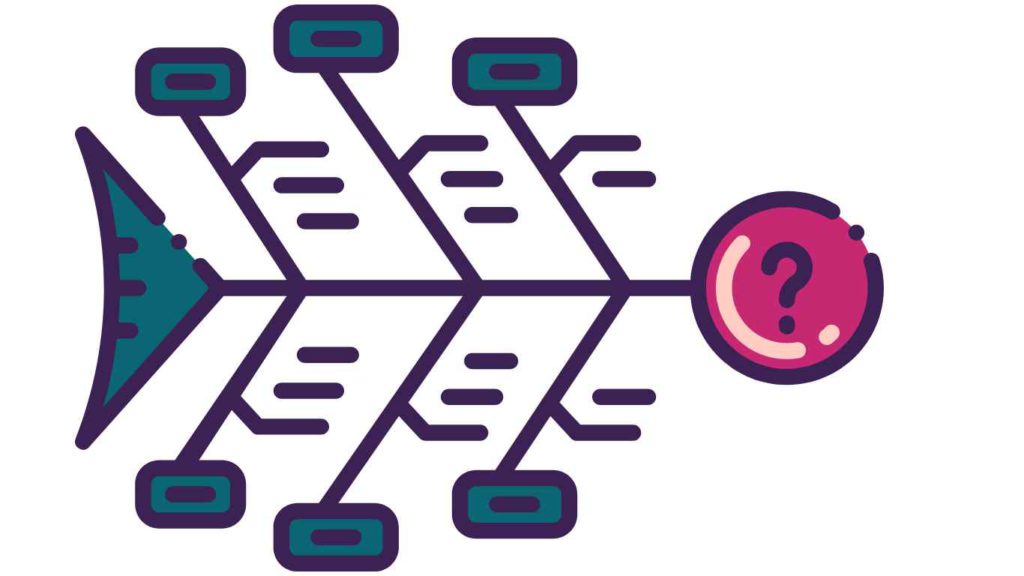
Ask the delegates to write their problem statement to the fish bone template, like the example shown here.
Then ask them to identify the major categories of causes of the problem. If they are stuck on this, suggest some generic categories to get them going, such as:
Delegates should then write the categories of causes as branches from the main arrow.
Next, they will identify all the possible causes of the problem, asking: “Why does this happen?”
As each idea is given, one of the delegates in each group writes it as a branch from the appropriate category. Causes can be written in several places if they relate to several categories.
Again, get the delegates to ask: “why does this happen?” about each cause, and write sub–causes branching off the causes.
If you have time, ask the delegates to carry on asking “Why?” and generating deeper levels of causes.
Mind mapping
The term mind mapping was devised by Tony Buzan for the representation of ideas, notes, information and so on in radial tree diagrams, sometimes also called spider diagrams.
These are now very widely used.
To brief in the mind map technique, the instructions below are usually best communicated via a quick demonstration by the facilitator, using an everyday, fun topic and asking delegates to shout out ideas for you to capture.
How to mind map:
- Ask delegates to turn their paper to landscape format and write a brief title for the overall topic in the middle of the page.
- For each major subtopic or cluster of materials ask them to start a new major branch from the central topic and label it.
- Continue in this way for ever finer sub-branches.
- Delegates may find that they want to put an item in more than one place. They could just copy it into each place or they could just draw a line to show the connections.
- Encourage delegates to use colour, doodles and to have fun with their mind map. This stimulates more right brain, creative thinking.

Moving forward – Idea generation
The next sessions are all about coming up with ideas, potential solutions to get from your starting position to the vision for the future that you all created earlier.
I recommend that you use at least two, or preferably all three of the idea generation techniques I have provided here because if you only use one, you are more likely to only get the most obvious, top of mind ideas from your team.
By looking at your challenge or opportunity from different perspectives using a range of techniques, you are more likely to create greater diversity of ideas.
This technique is really good for almost any subject, and especially…
…getting input from everyone. The noisy ones have much less opportunity to dominate!
…getting all the thoughts that people have out of their heads and onto paper.
…getting you started. This is a really accessible technique that is easy to run.
…getting people talking and engaged.
You will need plenty of sticky notes and pens.
Clustering with sticky notes – step-by-step guide
- Ask people to focus on the challenge that is the subject of the session.
- Each person is to work individually at first. They will take a pile of post-it notes and a pen, and get as many items down on the post-it notes as they can, writing only one item on each post-it note so that each person has a pile of written notes in front of them (12-15 each would be great).
- Say to the group that if they think they have finished, it probably is just a mental pause. The best thing for them to do is to look out of the window or move around briefly (but not look at their phones, laptop or disturb other people!) because they are likely to have a second burst of thinking. This is really important because it means you will get more thoughts down than just the obvious front-of-mind ones that come out early on. Allow 5-10 minutes for this step.
- Make sure that people don’t put more than one item on a post-it note.
- When everyone has got a pile of sticky notes and generally have run out of steam, ask them to “cluster” their notes as a group into similar themes on the flip chart paper, a bit like playing the card game “Snap”. Things that no-one else has should be included as a cluster of one item.
- Ask the groups to put a ring around each cluster and give it a name that summarises the content.
- Ask each group to feedback on the contents of their clusters, note similarities and differences and agree your next steps, writing them up on the flip chart for everyone to see.

Force-fitting with pictures
Force-fitting is about using dissimilar, or apparently unrelated, objects, elements, or ideas to obtain fresh new possibilities for a challenge or opportunity. You will need some magazines, photos or newspapers for this activity.
It is a very useful and fun-filled method of generating ideas. The idea is to compare the problem with something else that has little or nothing in common and gain new insights as a result.
You can force a relationship between almost anything, and get new insights – companies and whales, management systems and data networks, or your relationship and a hedgehog. Forcing relationships is one of the most powerful ways to develop ways to develop new insights and new solutions.
The following activity – Random Stimulus, a useful way of generating ideas through a selection of objects or cards with pictures – takes about 15 to 20 minutes to complete in total.
It is important to brief delegates to work intuitively through this process rather than over-thinking it. Just follow each of the simple steps outlined here in order.
Force-fitting with pictures step-by-step guide
Step 1 : Choose an image from the ones below at random. It really does not matter which one you choose, so just pick one that you think is interesting. This should take you no longer than a few seconds! Do this first before you move to the next steps.
Step 2: Now look at the image that you have selected. Feel free to pull it out so you can have it in front of you as you work. Write down as many interesting words as you can that come to mind when you look at the picture you have selected.
Step 3 : Now go back and “force fit” each of your interesting words into a potential solution for your challenge. If you have a negative word, turn it into a positive solution. Do this for every word on your list. You don’t have to work through the list in order – if you get stuck on a word, do another one and then come back to it when you’re ready. Don’t forget – premature evaluation stifles creativity. Just write stuff down without judging anything. You will have the opportunity to go back and select what you want / don’t want to use later.
Step 4 : Look at your outputs from this activity and highlight the things that resonate with you in terms of making progress with your challenge.
The SCAMPER technique is based very simply on the idea that anything new is actually a modification of existing old things around us.
SCAMPER was first introduced by Bob Eberle to address targeted questions that help solve problems or ignite creativity during creative meetings.
The name SCAMPER is acronym for seven thinking activities: ( S ) substitute, ( C ) combine, ( A ) adapt, ( M ) modify, ( P ) put to another use, ( E ) eliminate and ( R ) reverse. These keywords represent the necessary questions addressed during the creative thinking meeting. Ask you delegates to work through each one.
- S —Substitute (e.g., components, materials, people)
- C —Combine (e.g., mix, combine with other assemblies or services, integrate)
- A —Adapt (e.g., alter, change function, use part of another element)
- M —Magnify/Modify (e.g., increase or reduce in scale, change shape, modify attributes)
- P —Put to other uses
- E —Eliminate (e.g., remove elements, simplify, reduce to core functionality)
- R —Rearrange/Reverse (e.g., turn inside out or upside down)
Moving forward – Idea development
The objective of this session is to select the most useful or interesting ideas that you have come up with in the earlier idea generation activities, and shape them into a useful solution.
Suggested creative techniques for Moving forward – Idea development:
This is a useful exercise to help your delegates to quickly prioritise their ideas as a team.
- Ask delegates to use the grid shown here to plot their ideas, using sticky notes/
- They should then write a question for each of their ‘yes’ and perhaps some of your ‘maybe’ items that begins with the words ‘ How could we …? ’
- Then ask them to work on each of their questions, capturing their work a flipchart.
Sticky dot voting
Sticky dot voting is a quick, widely used voting method. Once all the ideas are on display give each group member a number of sticky dots (for example 5 each) to ‘vote’ for their favourite solution or preferred option. The number of sticky dots can vary according to what you think will work.
- Give everyone a few minutes of quiet planning time so that they can privately work out their distribution of votes.
- They may distribute their votes as they wish, for example: 2 or 3 on one idea, one each on a couple of others, all on one idea or one each on a whole series of ideas.
- To minimise the risk of people being influenced by one another’s votes, no votes are placed until everyone is ready. When everyone is finished deciding, they go up to the display and place their votes by sticking dots beside the items of their choice.
- As facilitator, lead a discussion on the vote pattern, and help the group to translate it into a shortlist for further development.
Once your delegates have selected their most promising ideas, choose from these creative problem solving techniques to help your group develop their thinking.
Assumption surfacing
Assumption surfacing is all about making underlying assumptions more visible.
- Ask the group to identify the key choices they have made, thinking about what assumptions have guided these choices and why they feel they are appropriate.
- Delegates should list the assumptions, and then add in a possible counter-assumption for each one.
- They should then work down the list and delete any assumption / counter assumption pairs that do not materially affect the outcome of the choice.
- Finally, ask delegates to reflect on the remaining assumptions, consider how these assumptions potentially impact their thinking and whether anything needs to be done as a result.
The words who, why, what, where, when, how are known as 5Ws and H, or Kipling’s list.
They provide a powerful checklist for imagination or enquiry that is simple enough to prompt thinking but not get in the way.
Ask delegates to:
- Create a list of key questions relating to their challenge, using 5Ws and H as prompts.
- Then ask them to answer of their questions as a way of info gathering and solution-finding for their challenge.
Force field analysis
Force field analysis represents the opposing driving and restraining forces in situation.
For example, it can help to map out the factors involved in a problematic situation at the problem exploration stage, or to understand factors likely to help or hinder the action planning and implementation stages.
The process is as follows:
- Delegates identify a list of the driving and restraining forces and discuss their perceptions of them.
- All the driving forces are arrows propelling the situation, and all the restraining forces are arrows that push back against the direction of the current situation.
- Delegates can use arrow thickness to indicate strength of the force, and arrow lengths to indicate either how difficult the force would be to modify, although these elements are optional.
- Delegates can then use the diagrams to generate ideas around possible ways to move in the desired direction by finding ways to remove the restraining forces and by increasing the driving forces.
Wizard of Oz prototyping
In the classic story of the Wizard of Oz, Dorothy and her friends go to see the Great and Powerful Wizard of Oz only to discover that he’s a fraud with no real magic.
Wizard of Oz Prototyping means creating a user experience that looks and feels very realistic, but is an illusion created to test an idea and generate a lot of really useful feedback very quickly and early on in your design process. The approach also means that you avoid incurring the cost of having to build the real solution.
In the workshop, ask delegates to consider how they could create a Wizard of Oz prototype through rough design sketches, lego or modelling clay.
Action Planning
I’m sure that many of us have been to meetings or events that have been interesting and maybe even fun at the time, but quickly forgotten due to lack of follow up or commitment to take action once the workshop is over.
The action planning phase is an essential part of mobilising the thinking from the workshop into meaningful, pragmatic activity and progress in the organisation. Getting commitment to deliver specific actions within agreed timescales from individuals at the workshop is as essential part of any event.
Suggested creative technique for Action Planning :
Blockbusters
You may remember the 80s quiz show called Blockbusters? Teenage contestants had to get from one side of the board to the other by answering questions.
This technique is based on a similar (sort of!) principle, and it is useful for action planning and helping delegates to visualise moving from where they are now to where they want to be.
- First ask delegates to write down the key aspects of where they are now on sticky notes (one item per sticky note) and put them down the left-hand side of a piece of flipchart paper, landscape.
- Then delegates are to do the same for the key aspects of where they would like to be, this time placing the sticky notes on the right-hand side of the paper, each one aligned to a relevant note on the left-hand side. For example, of they have a sticky note that says ‘struggling for sales’ on the left, they might have one that says ‘increase turnover by 35%’ on the right, both positioned level with each other.
- The final step is for delegates to fill in the space between with the 5 key actions for each item that will get them from where they are now to where they want to be. These can be different and separate actions, and don’t have to be in chronological order.
- You can ask delegates to add in target timescales and owners for each action as well.
Review, feedback and close
At the end of the day, it’s essential to bring everything together, review the progress and thank attendees.
It’s also a great opportunity to gain some feedback on the participants’ experience of the session.
Suggested creative technique for Review, feedback and close :
Goldfish Bowl
The general idea of this technique is that a small group (the core) is the focus of the wider group. The small group discusses while the rest of the participants sit around the outside and observe without interrupting. Facilitation is focused on the core group discussion.
A variation is to invite people from the outside group to ‘jump in’ and replace a member of the core group. It sounds a bit odd on paper, but it works very well and can be great fun.
Sometimes people in the core group are quite pleased to be ‘relieved’ of their duties!
In smaller events, it is also a good idea to make it a game. Make sure that everyone jumps into the core group at least once.
This can really help people focus on active listening, and on building on each other’s points.
Often the best way to brief this in is by demonstrating it with a willing volunteer.
For more facilitation tips, techniques and ideas, have a look at my articles here:
How to design a virtual innovation sprint
How to facilitate a virtual brainstorming session
How to facilitate a goal setting workshop
How to be a great facilitator
I’d love to hear from you, whether you’re facilitating your own creative problem solving workshops, or would like some help from us to design and facilitate them for you. I hope you’ve found this article helpful. If you’d like to join my free, private Facebook group, Idea Time for Workshop Facilitators , for even more ideas and resources, please do come and join us.
Leave a Reply Cancel reply
Your email address will not be published. Required fields are marked *
- Some of our clients
- Jo's PhD Research
- CONTENT STUDIO
- Idea Time Book
- Innovation Events
- Innovation Consulting
- Creative Facilitation Skills
- Executive Development

Privacy Policy © The Big Bang Partnership Limited 2023
Privacy Overview

How To Prepare For A Problem-solving Workshop

Imagine sitting in a room with a firm of doctors. Each specialist carefully analyses every facet of a patient’s case. Everyone with their knowledge at play is geared to provide viable solutions to address the challenges they face.
Although the software design world may seem like a far cry from the medical field, they share a fundamental similarity: both revolve around problem-solving. Designers apply multiple practices to validate and authenticate solutions with our partners.
To align everyone, we set up Problem-Solving Workshops (PSWs). At its core, PSWs are a space to solve problems. Our team will dissect every aspect of the problem, identify potential challenges, and find the best solutions. Finally, we validate the process through testing.
Neil Webb, Design Producer and problem-solving workshop facilitator at MOHARA, shed light on how this process works by answering a few of our probing questions.
What Are Problem-Solving Workshops?
A problem-solving workshop is a collaborative event or session where participants come together to identify, analyse, and develop solutions for a specific problem or set of problems.
It could be a show-stopper of a problem that has stopped work or a way to identify improvement backlog items for your next sprint. The main goal of this process is to foster creative thinking, encourage teamwork, and facilitate learning by sharing ideas, experiences, and perspectives.
A typical problem-solving workshop can take many forms but include the following steps:
➡️ Define the problem: Clearly define and understand the problem(s) to be addressed.
➡️ Brainstorming: Encourage open discussion and the sharing of ideas, allowing participants to think freely and creatively.
➡️ Analysis and evaluation: Analyse and evaluate the proposed ideas, considering their feasibility, effectiveness, and potential impact.
➡️ Solution development: While considering available resources and constraints, develop and refine the most promising ideas into actionable solutions.
➡️ Implementation planning: Create a detailed plan for implementing the chosen solution(s), including timelines, responsibilities, and resource allocation.
At MOHARA, our problem-solving workshops are our take on a Google design sprint . It is a time-constrained, rapid five-stage process to answer essential product questions. It speeds up the design process and lets you quickly test and iterate your ideas.
As a result, you can shortcut the endless debate cycle and compress months of thinking and iteration into a single idea. Therefore, you are reducing risk at a basic level and saving a founder time and money.
What Are the Fundamentals of Setting Up a Problem-Solving Workshop?
Running a successful problem-solving workshop needs the founder’s support. Given that it is their idea and they have already devoted considerable time and effort to research, their insights are extremely valuable. Communicate the workshop’s objectives and deliverables to get the founder’s buy-in.
Assemble a workshop team of five to seven people including a Facilitator, a Lead Designer, a Lead Engineer, and possibly an Engagement Lead. In the case of a large organisation, including more than one stakeholder from the company – ideally subject matter experts – enriches the collaboration and decision-making process.
How Do You Facilitate a Problem-Solving Workshop?
The process should begin with a week of research, onboarding, and setup. To start with, one has to understand the most significant root cause of any given problem.
To achieve this, we interview the client and other key stakeholders and ask them to fill out a pre-workshop questionnaire. This information helps the MOHARA team understand the founder’s vision and long-term goals.
A traditional in-person workshop happens over four to five days. The activities on the first day are all about aligning ourselves as a team to understand the users, their needs, and the different challenges they may face during the product development cycle.
Several problem-solving techniques can be used to brainstorm solutions and get the best outcome. The idea is to choose your product’s most suitable and effective strategy.
How Does Conducting Remote Problem-Solving Workshops Impact the Process?
The shift to remote work has altered our approach to conducting workshops. While we at MOHARA are accustomed to working remotely, the absence of in-person sessions does pose some challenges.
Usually, we can go through the different phases within a week. But, remotely, it’s slightly different: you can’t have someone in a workshop call all day long; the sessions are intense and require a lot of focus.
We must slow things down for the sake of everyone taking part because these sessions help us understand whether users will receive a feature or product well.
We split the PSWs into one or two workshops a week. We then build the prototype, providing daily feedback and ensuring the founder understands what we’re doing, and why.
Having the Right Setup Is Essential for a Remote PSW
For a problem-solving workshop to be successful, the right setup is critical. When we are conducting a session remotely, we do the following:
➡️ Prebuilt templates: Templates are designed in advance for different sessions. The templates help guide all participants through multiple activities and checkpoints and revisit relevant information at any point.
➡️ Set up whiteboard software: We also use interactive whiteboard products to create a space for collaboration and review. Timelines, key deliverables, and communication are other significant factors in ensuring the process is smooth, and that the client feels comfortable and understands where we are going.
What Are the Next Steps?
Participants envision the solution to an identified problem during an ideation session where they sketch out ideas and concepts. The aim is to look for as many ideas as possible and examine examples and relevant cases they have come across elsewhere.
The team will then consider how certain features could resolve a critical challenge. There may be many ideas on how to solve the challenge faced, so the next decision-making stage is very valuable. The team and stakeholders decide which solution and critical features they would like to test and then turn that solution into a high-fidelity prototype.
The last part of the problem-solving workshop focuses on qualitative testing. We want to gain valuable feedback from actual users, so selecting them carefully is imperative. We ask participants to perform tasks, usually using specific user interfaces. While the participant completes each task, we observe the participant’s behaviour and listen for feedback.
What Role Does Prototyping Have in a Workshop Process?
Much of this process is about speed. We do not want to start building anything in code at this stage. Instead, using Figma – our prototyping tool of choice – the designer will lay out various screens and connect them with the specific steps we want users to take.
Based on some of the critical questions defined in our sessions, we will share a link with the users and then give them particular tasks we want them to carry out. We can then test which, if any, of our assumptions were correct, and start to think about some of the primary user journeys, the user experience, and other core features.
What Are the Most Overlooked Aspects of a Problem-Solving Workshop?
There are three aspects of a problem-solving workshop that is often overlooked:
🔶 It’s not a design sprint
It’s important to understand that the entire process is not just about design. There needs to be some technical expertise as well. That is why we don’t call these Design Sprints but rather PSWs. It’s about using design and engineering to solve a problem.
🔶 It’s essential to keep the energy up
One of the significant challenges regarding remote workshops is how much energy is required. If you’re in a room full of people like we used to be, you could generate solutions, get everyone together and build up the excitement.
However, doing it over a screen is tricky. It’s challenging to keep things energised and to avoid reviewing the same points and using valuable time.
🔶 Inclusion is also essential
The idea, especially with remote PSWs, is to ensure everyone has a voice. Only some people will speak up in a session. Naturally, some people are more vocal than others, and these people will generally lead the conversation.
If someone else, however, is given the opportunity to share even the slightest valuable insight, it could change the whole direction of the team’s solutions. It only takes one comment, or perhaps a note. For this reason, everyone must have a voice.
Are There Any Pitfalls?
Several things can go wrong during the process. Someone might drop off a call or have connectivity issues interrupting the flow. We’ve also had situations where the hardware doesn’t work correctly.
From a facilitation point of view, having a plan for each product-solving workshop and a clear outline of what will take place, are essential. That means mapping out the different activities and ensuring people know how long each activity will take. This plan keeps everyone aligned, and the PSW will only be successful with it completed ahead of time.
Lastly, user testing has to be qualitative rather than quantitative because, at this point, you’re asking for detailed information and feedback on the tasks they’ve had to do, particularly to identify any problems. You would need more than quantitative research to get that kind of data.
Do You Have to Check In with Various Stakeholders After the Workshop?
Yes. Client feedback is always valuable. It’s essential to get an update on how they are getting on from a product perspective, as well as gather their insights and feedback on the PSWs process.
Suppose we agree with the client to do further design work post-prototyping or engineering (or both). We would already have discussed those later-stage design phases in more detail during some of the sessions. By the way, this is another reason why having an engineering representative there during these sessions is so valuable.
During the PSWs, we would then compile a list of challenges to write up as questions that we aim to answer with our solution by the end of the workshops. After the PSWs have concluded, we provide feedback in the form of reports with user testing results, including data, a breakdown, and evidence of all the conducted activities.
What Do You Enjoy Most About Setting Up Problem-Solving Workshops?
It’s creative problem-solving at its finest! I enjoy engaging with founders and experiencing their passion for their products. It’s also great to work with the engineers, watch how they engage in the sessions, and identify solutions; having those different viewpoints is essential.
Setting up the workshop is enjoyable, too, because it involves using design tools that are constantly evolving; I am a designer at heart, after all.
Effective planning is the way to foresee risks and aim for success. Now that you have the lowdown on Problem-Solving Workshops, we suggest calling the relevant troops to get started.
It takes a team of experts to navigate challenges and produce a product that makes one proud. So get your tools packed; with Neil’s guidance and tips, you’re certainly off to a good start!
If you find you need more help with problem-solving, why not get in touch with MOHARA?
Related Insights

Should You Build vs. Buy Generative AI? The Pros and Cons

The Toronto Tech Scene: How the City Became a Hub for New Technologies

From Idea to Market: The Comprehensive Guide to Healthcare Software Development
Pioneering together.
Laxmi Building 57 Bermondsey Street London SE1 3XJ
6th Floor, The Hudson 30 Hudson St De Waterkant Cape Town 8001
26th Floor, 246 Times Square Shopping Center Sukhumvit 12-14 Road Khlong Toei Thailand 10110
WeWork, 5th Ave, Manila, 1634 Metro Manila, Philippines
Guadalajara
Colabora Av Chapultepec Sur 480, 44140 Guadalajara, Jalisco, Mexico
WeWork, 240 Richmond Street W, Toronto, ON, M5V 1V6
Join our newsletter
We’ll bring you the latest updates from our ventures, share exciting news from MOHARA and offer insights from our latest blog posts.
Our Partners

© MOHARA 2024. All rights reserved.
Privacy Policy | Cookie Policy | Terms and Conditions
- Skip to content

Problem-solving workshop: Step-by-Step
A problem-solving workshop is held by the Agile Release Train and its purpose is to address systematic problems. The workshop that concentrates on identifying the problems, not just addressing the symptoms, is facilitated by the Release Train Engineer and time-boxed to maximum of two hours. What are the six steps of the workshop?
In SAFe® (Scaled Agile Framework for Enterprises®), problem-solving workshop is done during the Inspect & Adapt (I & A) event. I & A is held at the end of each Program Increment, and it forms the basis for relentless improvement, one of the four pillars of the SAFe House of Lean , and a dimension of the Continuous Learning Culture core competency.
During the three parts of I & A event (PI System Demo, Quantitative and Qualitative measurement, and Retrospective and problem-solving workshop), the ART demonstrates and evaluates the current state of the solution and teams reflect and identify improvement backlog items. In this article we are going to concentrate on the last part of the event, problem-solving workshop, during which teams systematically address the larger impediments that are limiting velocity.
Problem-solving workshop consists of 6 steps
Step 1: agree on the problem to solve.
Clearly stating the problem is key to problem identification and correction. It enables more focused investigation, time-saving, and avoids ‘ready, fire, aim’ approach. On the other hand, a problem that is not well defined, may result in failure to reach the proper countermeasure. To identify and agree on the problem to solve, the teams should spend a few minutes clearly stating the problem, highlighting the ‘what’, ‘where’, ‘when’, and ‘impact’ as succinctly as they can.
Step 2: Apply root-cause analysis and 5 whys
The Root-cause analysis and the ‘5 Whys’ technique is used to explore the cause-and-effect relationships underlying a particular problem. It helps to avoid assumptions and logic traps, trace the chain of causality in direct increments from the effect to a root cause.
The root cause analysis (fishbone or Ishikawa) diagram features 5 main ‘bones’ that represent typical sources of problems in development (tools, people, program, process, environment). Team members then brainstorm causes that they think contribute to the problem to be solved and group them into these categories. Once a cause is identified, its root cause is explored with the 5 Whys technique. By simply asking ‘why’ multiple times, the cause of the previous cause is uncovered, and added to the diagram. The process stops once a suitable root cause has been identified and the same process is then applied to the next cause (© Scaled Agile, Inc.).
Step 3: Identify the biggest root-cause using Pareto analysis
Team uses Pareto analysis (or 80/20 rule) to narrow down the number of actions that produce the most significant overall effect. It is based on the principle that 20% of root causes can cause 80% of problems and it has proved useful where many possible sources and actions are competing. Once the team writes down all the causes-of-causes, they identify the biggest root-cause using dot-voting – every team member has five dots on its disposal, and he can allocate them to one or more items he thinks are most problematic. Then they summarize votes in Pareto chart that shows collective consensus on the most significant root-cause.
Step 4: Restate the new problem for the biggest root-cause
Team picks the most voted item from Pareto chart. They restate it clearly as a problem and add economic impact of the problem to the description.
Step 5: Brainstorm solutions
During the brainstorming activity that lasts about 15 – 30 minutes, team brainstorms as many possible corrective actions as possible. The goal of activity is to generate as many ideas as possible, without criticism or debate. Team members should let their imagination soar and explore and combine all the ideas that arise and in the end dot-vote to identify top contenders.
Step 6: Identify improvement backlog items (NRFs)
In the end of the problem-solving workshop, up to three most voted solutions are identified. Solutions are then rephrased as improvement stories and features to be fed directly into the PI Planning event that follows the I & A event. During that event, the RTE helps ensure that the relevant work needed to deliver the identified improvements is planned. This closes the loop, thus ensuring that action will be taken, and that people and resources are dedicated as necessary to improve the current state. In this way, problem-solving becomes routine and systematic, and team members and ART stakeholders can be assured that the train is solidly on its journey of relentless improvement (© Scaled Agile, Inc. ).
You may also like
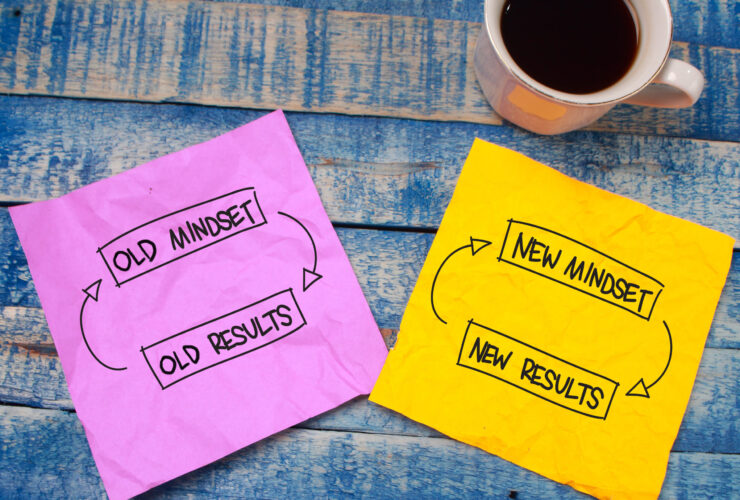
Lean-Agile Mindset: Transforming Leadership and Culture
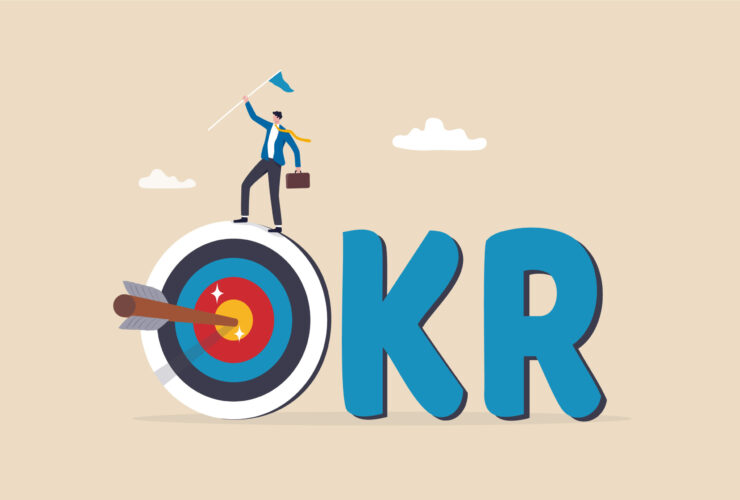
OKRs: All you need to know

10 Tips for Facilitating Your Problem-Solving Workshop
A problem-solving workshop is a structured approach to address a particular challenge or issue that a team or organization is facing. The workshop is designed to bring together a diverse group of individuals with different perspectives, skills, and knowledge to collaborate on identifying and solving the problem at hand.
The workshop typically involves a series of activities and exercises designed to help participants understand the problem, generate ideas for potential solutions, and evaluate and prioritise those solutions based on a set of criteria or metrics . Depending on the nature of the problem and the desired outcomes of the workshop, the exercises may include brainstorming sessions, group discussions, role-playing exercises, prototyping, or other activities.
The goal of a problem-solving workshop is to create a collaborative, creative, and open environment where participants feel empowered to share their ideas, challenge assumptions, and work together towards a common goal. By bringing together a diverse group of individuals with different perspectives and expertise, the workshop can tap into a wide range of knowledge and experience, which can lead to more innovative and effective solutions.
The workshop may be facilitated by an internal or external facilitator, who can help to guide the participants through the process and keep them focused on the problem at hand. Depending on the complexity of the problem and the size of the group, the workshop may take anywhere from a few hours to several days to complete.
Our top tips for facilitating a problem solving workshop are:
- Clearly define the problem: Before starting the workshop, make sure the problem is clearly defined and understood by all participants.
- Establish ground rule s: Set clear guidelines for how the workshop will be conducted, including rules for respectful communication and decision-making.
- Encourage diverse perspectives: Encourage participants to share their diverse perspectives and experiences, and consider using techniques such as brainstorming to generate a wide range of ideas.
- Use a structured process: Utilize a structured problem-solving process, such as the six-step process outlined by the International Association of Facilitators, to guide the workshop.
- Promote active listening : Encourage participants to actively listen to each other and seek to understand different viewpoints.
- Encourage collaboration : Foster a collaborative atmosphere by encouraging teamwork and shared ownership of the problem-solving process.
- Facilitate decision making : Help participants make informed decisions by providing them with the necessary information and resources.
- Encourage creativity : Encourage participants to think creatively and outside the box to generate new ideas and solutions.
- Monitor and manage group dynamics : Pay attention to group dynamics and intervene as needed to keep the workshop on track and prevent conflicts.
- Follow up and review: Follow up on the outcomes of the workshop and review the results to continually improve the problem-solving process.
Here are some exercises that may be more fun and engaging for a problem-solving workshop:
- Escape room : Create an escape room-style challenge that requires participants to solve a series of problems to escape the room.
- Treasure hunt: Create a treasure hunt that requires participants to solve clues and riddles to find hidden objects or reach a goal.
- Charades: Have participants act out different scenarios related to the problem and have the rest of the group guess what they are trying to communicate.
- Jigsaw puzzles : Use jigsaw puzzles as a metaphor for solving problems and have participants work together to piece the puzzle together.
- Improv games: Use improv games, such as “Yes, And,” to encourage creativity and build teamwork skills.
- Scavenger hunt : Create a scavenger hunt that requires participants to solve clues and challenges to find hidden objects or complete tasks.
- Board games : Use board games that require problem-solving skills, such as escape room-style games or strategy games, to make problem-solving more interactive and fun.
- Puzzle-based challenges: Create puzzle-based challenges that require participants to solve a series of interconnected problems to reach a goal.
- Role-playing games : Use role-playing games, such as Dungeons and Dragons, to encourage creative problem solving and teamwork.
- Creativity challenges : Use creativity challenges, such as “the Marshmallow Challenge,” to encourage out-of-the-box thinking and teamwork.
In conclusion, a problem-solving workshop can be a powerful tool for teams and organisations looking to tackle complex challenges and drive innovation. By bringing together a diverse group of individuals with different perspectives and expertise, the workshop can create a collaborative, creative, and open environment where participants feel empowered to share their ideas, challenge assumptions, and work towards a common goal.
While the success of a problem-solving workshop depends on many factors, such as the facilitation, the quality of the problem statement, and the engagement of the participants, the potential benefits are significant. By tapping into the collective intelligence of the group, the workshop can generate new ideas, identify blind spots, and build consensus around potential solutions. Moreover, the workshop can help to foster a culture of collaboration, learning, and innovation that can have a lasting impact on the team or organization.
Related Posts

The 16th Annual State of Agile Report

How Do Web3 and Agile Combine To Enhance Development

Difference Between Agile and Explain Organic Agile

Why Spillover Happens and Why You Shouldn’t Worry

The Johari Window and Agile Methodologies – An Explosive Combo

“Dual Track” Agile

Main Differences Between Three Concepts – Agile, Scrum, And Kanban

Why Teams Outcome Is More Important Than Its Velocity or Even Output
Leave a Comment Cancel reply
Your email address will not be published. Required fields are marked *
Save my name, email, and website in this browser for the next time I comment.
Copyright © 2023 Agile Heuristics. All rights reserved. Agile Heuristics Ltd is a private limited company, registered in the United Kingdom, with company number 14699131
We are back in Europe and hope you join us!

Prague, Czech Republic, 15 – 17, May 2023

Evolving the Scaled Agile Framework:
Update to SAFe 5
Guidance for organizing around value, DevSecOps, and agility for business teams

- SAFe Contributors
- Extended SAFe Guidance
- Community Contributions
- SAFe Beyond IT
- Books on SAFe
- Download SAFe Posters & Graphics
- Presentations & Videos
- FAQs on how to use SAFe content and trademarks
- What’s new in the SAFe 5.1 Big Picture
- Recommended Reading
- Learn about the Community
- Member Login
- SAFe Implementation Roadmap
- Find a Transformation Partner
- Find a Platform Partner
- Customer Stories
- SAFe Training
Kaizen is about changing the way things are. If you assume that things are all right the way they are, you can’t do kaizen. So change something! —Taiichi Ohno
Inspect and Adapt
Inspect & adapt: overview.

The Agile Manifesto emphasizes the importance of continuous improvement through the following principle: “At regular intervals, the team reflects on how to become more effective, then tunes and adjusts its behavior accordingly.”
In addition, SAFe includes ‘relentless improvement’ as one of the four pillars of the SAFe House of Lean as well as a dimension of the Continuous Learning Culture core competency. While opportunities to improve can and should occur continuously throughout the Program Increment (PI) (e.g., Iteration Retrospectives ), applying some structure, cadence, and synchronization helps ensure that there is also time set aside to identify improvements across multiple teams and Agile Release Trains.
All ART stakeholders participate along with the Agile Teams in the I&A event. The result is a set of improvement backlog items that go into the Program Backlog for the next PI Planning event. In this way, every Agile Release Train (ART) improves every PI. For large solutions , a similar I&A event is held by the Solution Train .
The I&A event consists of three parts:
PI System Demo
- Quantitative and qualitative measurement
- Retrospective and problem-solving workshop
Participants in the I&A should be, wherever possible, all the people involved in building the solution. These include for an ART:
- The Agile teams
- Release Train Engineer (RTE)
- System and Solution Architects/Engineering
- Product Management , Business Owners , and others on the train
Additionally, Solution Train stakeholders may attend this event.
The PI System Demo is the first part of the I&A, and it’s a little different from the regular system demos that happen after every iteration, in that it is intended to show all the Features that the ART has developed over the course of the PI. Typically the audience is broader, for example, customers or Portfolio representatives are more likely to attend this demo. Therefore, the PI system demo tends to be a little more formal, and some extra preparation and staging are usually required. But like any other system demo, it should be timeboxed to an hour or less, with the level of abstraction high enough to keep stakeholders actively engaged and providing feedback.
Prior to, or as part of the PI system demo, Business Owners collaborate with each Agile team to score the actual business value achieved for each of their Team PI Objectives .
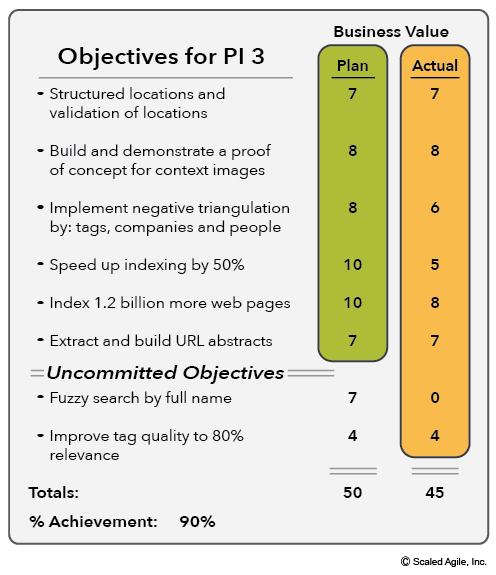
Quantitative and Qualitative Measurement
In the second part of the I&A event, teams collectively review any quantitative and qualitative metrics they have agreed to collect, then discuss the data and trends. In preparation for this, the RTE and the Solution Train Engineer are often responsible for gathering the information, analyzing it to identify potential issues, and facilitating the presentation of the findings to the ART.
One primary metric is the program predictability measure. Each team’s planned vs. actual business value is rolled up to create the program predictability measure, as shown in Figure 2.
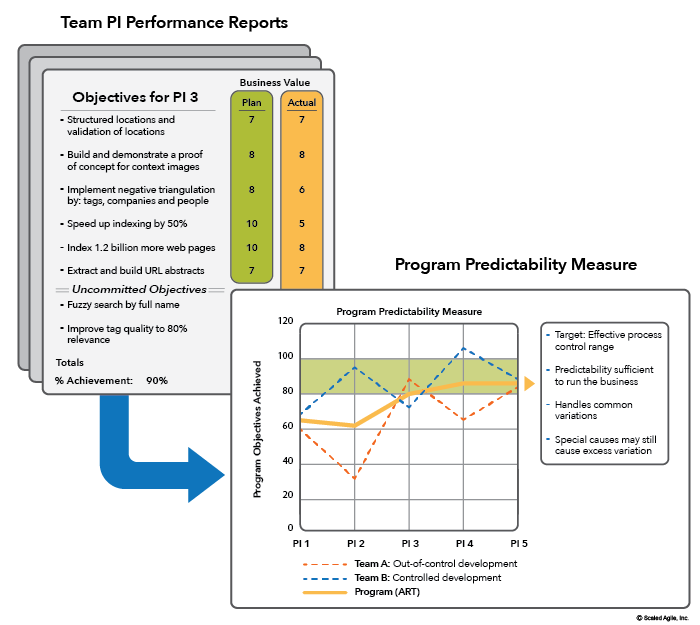
Reliable trains should operate in the 80–100 percent range; this allows the business and its external stakeholders to plan effectively. (Note: Uncommitted objectives don’t count toward the commitment but do count toward the actual business value achievement, as can also be seen in Figure 1.)
Retrospective
The teams then run a brief (30 minutes or less) retrospective, the goal of which is to identify a few significant issues they would like to address during the problem-solving workshop . There is no one way to do this; several different Agile retrospective formats can be used [3].
Based on the retrospective, and the nature of the problems identified, the facilitator helps the group decide which issues they want to tackle. Each team may work on a problem, or, more typically, new groups are formed from individuals across different teams who wish to work on the same issue. This self-selection helps provide cross-functional and differing views of the problem, and it brings together those who are impacted and those who are best motivated to address the issue.
Key ART stakeholders—including Business Owners, customers, and management—join the teams in the retrospective and problem-solving workshop. Often it is the Business Owners alone who can unblock the impediments that exist outside the team’s control.

Problem-Solving Workshop
For addressing systemic problems, a structured, root-cause problem-solving workshop is held by the ART. Root cause analysis provides a set of problem-solving tools used to identify the actual causes of a problem, rather than just addressing the symptoms. The session is typically facilitated by the RTE, in a timebox of two hours or less.
Figure 3 illustrates the steps in the problem-solving workshop.
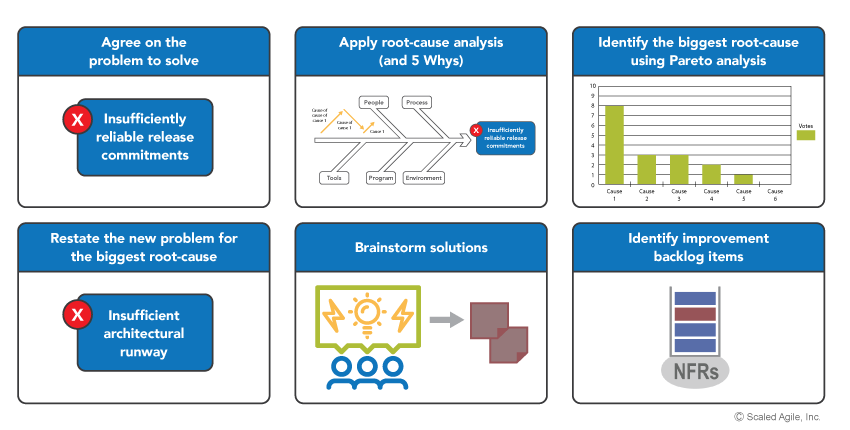
The following sections describe each step of the process.
Agree on the Problem(s) to Solve
American inventor Charles Kettering is credited with the statement that “a problem well stated is a problem half solved.” At this point, the teams have self-selected the problem they want to address. But, do they agree on the details of the problem, or is it more likely that they have differing perspectives? To this end, the teams should spend a few minutes clearly stating the problem, highlighting the ‘what’, ‘where’, ‘when’, and ‘impact’ as succinctly as they can. Figure 4 illustrates a well-written problem statement.
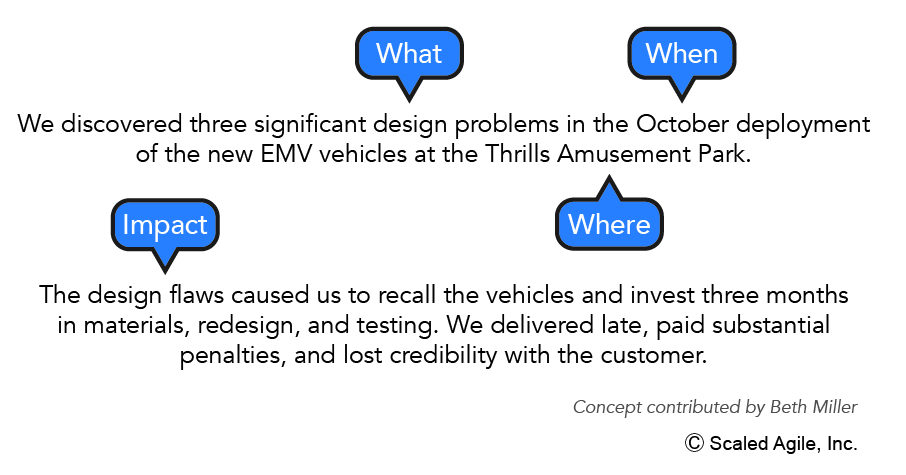
Perform Root Cause Analysis
Effective problem-solving tools include the fishbone diagram and the ‘5 Whys.’ Also known as an Ishikawa Diagram , a fishbone diagram is a visual tool used to explore the causes of specific events or sources of variation in a process. Figure 5 illustrates the fishbone diagram with a summary of the previous problem statement written at the head of the ‘fish.’
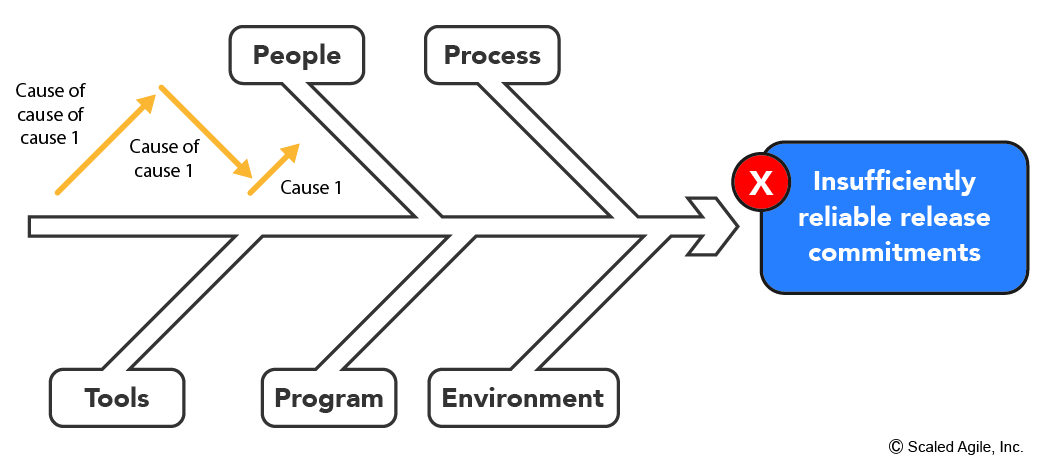
For our problem-solving workshop, we preload the main bones with the categories people, process, tools, program, and environment. However, these may be adapted as appropriate.
Team members then brainstorm causes that they think contribute to the problem to be solved and group them into these categories. Once a cause is identified, its root cause is explored with the 5 Whys technique. By simply asking ‘why’ multiple times, the cause of the previous cause is uncovered, and added to the diagram. The process stops once a suitable root cause has been identified and the same process is then applied to the next cause.
Identify the Biggest Root Cause
Pareto Analysis , also known as the 80/20 rule, is a technique used to narrow down the number of actions that produce the most significant overall effect. It uses the principle that 20 percent of the causes are responsible for 80 percent of the problem. It’s especially useful when many possible courses of action are competing for attention, which is almost always the case with complex, systemic issues.
Once all the possible causes-of-causes have been identified, team members then cumulatively vote on the item they think is the most significant factor contributing to the original problem. They can do this by dot voting (five votes are allocated to each person, which can be spread among one or more items as they see fit) on the causes they think are most problematic. The team then summarizes the votes in a Pareto chart, such as the example in Figure 6, which illustrates their collective consensus on the most significant root cause.
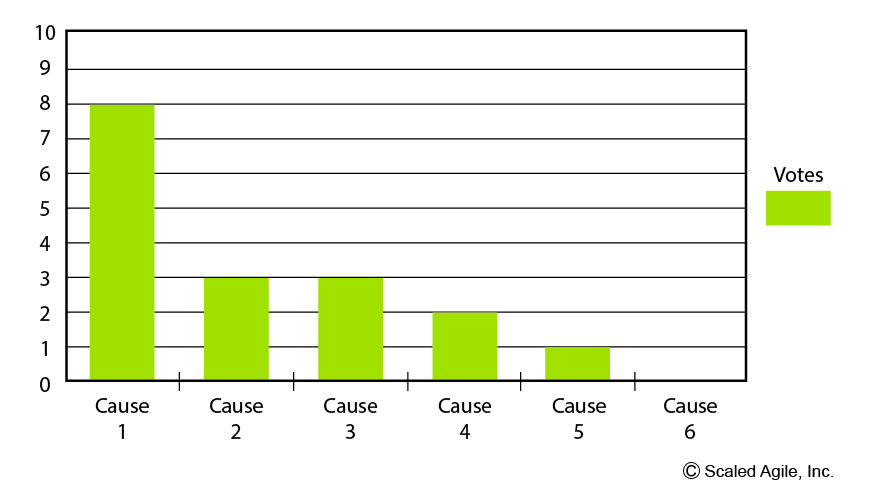
Restate the New Problem
The next step is to pick the cause with the most votes and restate it clearly as a problem. This should take only a few minutes or so, as the teams have a good understanding of this root cause by now.
Brainstorm Solutions
At this point, the restated problem will start to imply some potential solutions. The team brainstorms as many possible corrective actions as they can think of within a fixed timebox (about 15–30 minutes). The rules of brainstorming apply here:
- Generate as many ideas as possible
- Do not allow criticism or debate
- Let the imagination soar
- Explore and combine ideas
Create Improvement Backlog Items
The team then cumulatively votes on up to three most likely solutions. These are rephrased as improvement stories and features to be fed directly into the PI Planning event that follows. During that event, the RTE helps ensure that the relevant work needed to deliver the identified improvements is planned. This closes the loop, thus ensuring that action will be taken and that people and resources are dedicated as necessary to improve the current state.
In this way, problem-solving becomes routine and systematic, and team members and ART stakeholders can be assured that the train is solidly on its journey of relentless improvement.
Inspect and Adapt at the Large Solution Level
The above describes a rigorous approach to problem-solving in the context of a single ART. If the ART is part of a Solution Train the I&A event will often include key stakeholders from the Large Solution level. In larger value streams, however, an additional large solution level I&A event may be required, following the same format.
Due to the number of people in a Solution Train, attendees at the large solution I&A event cannot include everyone, so stakeholders are selected that are best suited to address the problems faced. This includes the primary stakeholders of the Solution Train, as well as representatives from the various ARTs and Suppliers .
Last update: 10 February 2021
Privacy Overview
Functional cookies help to perform certain functionalities like sharing the content of the website on social media platforms, collect feedbacks, and other third-party features.
Performance cookies are used to understand and analyze the key performance indexes of the website which helps in delivering a better user experience for the visitors.
Analytical cookies are used to understand how visitors interact with the website. These cookies help provide information on metrics the number of visitors, bounce rate, traffic source, etc.
Advertisement cookies are used to provide visitors with relevant ads and marketing campaigns. These cookies track visitors across websites and collect information to provide customized ads.
Other uncategorized cookies are those that are being analyzed and have not been classified into a category as yet.

My Workshop Structure for Creative Problem Solving
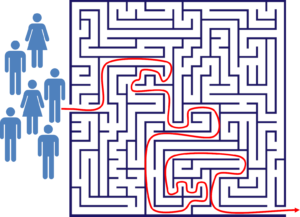
Type of Problems
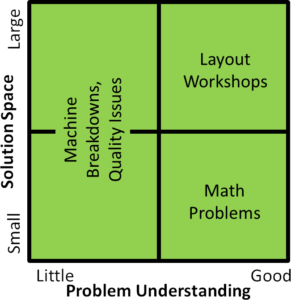
- Good Understanding, Few Solutions : This is for problems where the path is pretty clear and it just has to be done. An example is solving a mathematical equation.
- Good Understanding, Many Solutions : You have a reasonable understanding of the problem and can estimate the impact of your changes onto the system, but there are many different possible solutions that have to be explored.
- Little Understanding, Many Solutions : These are problems where you don’t even know what the problem is exactly. Examples are machine breakdowns or quality problems. You known the problem, but you don’t really know the root cause. In this case, you need to put the majority of your time into root-cause analysis.
- Little Understanding, Few Solutions : You don’t really know what is going on, although there are only a few solutions. Since you don’t understand the problem well, you don’t know the number of possible solutions. Hence this is overlapping with the “ little understanding, many solutions. ” It may be that the quality problem or machine breakdown has only one cause and you have to find it. You probably also would need to invest time into the understanding of the problem.
In any case, the following workshop structure is designed for problems where the group understands the problem reasonably well and can estimate how changes to the system influence the system, although there are still solutions hidden that they cannot (yet) imagine. Yet the many different possible solutions present a challenge.
A common example is a layout workshop to create a new layout for a production system. There are almost unlimited different ways for how to place the machines and materials on the shop floor. The workshop group knows at least somewhat how the placement affects the performance, but has trouble choosing one out of the many different ways to do it. This is where this workshop structure can help.

The Workshop Sequence
Introduction.

First Round of Solutions

Also, if possible, put the sub-teams in separate areas or even separate nearby rooms so they can work independently. Provide them with the necessary materials to work the problem, ideally based on paper. For example, for a layout workshop, give them a large printout of the shop floor map, plenty of paper in different colors, scissors, tape, glue, and so on. Let them work on the problem without giving much instruction on the problem-solving method. This first round usually serves more as a learning curve for the team and rarely generates the final solution. Another important point is that even though you as the moderator may be eager to step in and contribute, restrain yourself. Observe the teams, observe their ideas, and, most importantly, observe with which aspects of the problem they struggle.
After the thirty minutes are over, bring the teams back into the main room, have them present each other their solutions, and allow for some discussion. The entire group should list a few benefits and problems with each of these solution. This may take another fifteen to thirty minutes. Hang the solutions including their pro/cons on the wall, as they will be relevant later.
Second Round of Solutions

The team may grumble a bit, but have them again separately do another solution within thirty minutes. This second round is not a refinement of the first solution, but instead a completely new solution. Optionally, you can shuffle the teams around a bit and move, for example, one team member in each group to another group. After thirty minutes get them together again and have them present to each other and list the pros and cons of the different ideas. Hang the results on the wall again.
If the problem needs more ideas and if you have the time, you can repeat this in a third round, with or without a creative provocation.

In preparation for the last round, the team again looks at all previous solutions (which should be hanging on the wall), and as a group discusses the benefits and disadvantages of each solution. Steer the discussion toward a solution that includes all of the benefits but none of the disadvantages. Eventually ask the team if they want to generate another solution based on what they have learned. Almost always they say yes (if not, one solution is probably good enough already).
Hence they work out another solution. However, this time the team works as one group, creating only one solution. Also, do not give any restrictions on the solution space. If necessary, allow for more time, maybe up to sixty minutes. Afterward, there is no need to present, since everybody knows the solution already, but you still should list pros and cons.
For selecting the solution to be implemented, ask the team which one of these (now five to ten solutions) they like best and want to apply to the problem. Almost always, it is the solution from the last round. In some cases the team may indicate the desire for another round. In this case – time permitting – repeat the last round once more. But at the end you should have one solution with which the team is happy and which can then be finalized for implementation.

So there you have it. This is the basic structure for my workshops for problems that have many possible solutions. I have had quite some positive experiences with these in the past. Keys for success are many different solutions, some creative provocation, and a multifunctional team. Hopefully this will also help you to solve similar problems in your location. Now go out, gather your team, create solutions, and organize your industry!
1 thought on “My Workshop Structure for Creative Problem Solving”
Impressive improvement guide, example is apt prior to tackling a FMCC enterprise. As a QC Facilitator I successfully used this approach in the 70 and 80s, known as “Quality Circles’ to improve productivity and save £Ms for Car Industry and supplier network
Leave a Comment
Notify me of new posts by email.
Lean Events and Training / Forms and Templates
Forms and Templates
Downloads for A3 problem solving, standard work , project management, and value stream mapping .
Problem Solving Templates
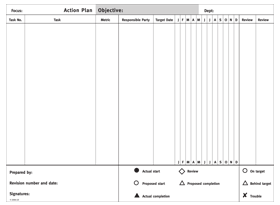
A3 Action Plan Form (from Getting the Right Things Done)
- The action plan template helps define the who, what, when, where, and how of a plan on one page.
- Helps track progress and highlight problems so action can be taken.
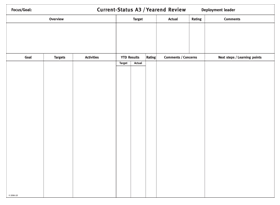
A3 Status Review Form (from Getting the Right Things Done)
- Top box provides an overview with respect to our critical end-of-pipe metrics.
- Second box provides an overview of activities, and usually reflects what’s been prescribed on the action plan of the right side of the strategy A3.
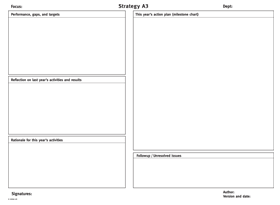
A3 Strategy Form (from Getting the Right Things Done)
- A strategy A3 is a one-page storyboard on 11-inch by 17-inch paper that helps tell the strategy “story.”
- Logic flows from top left to bottom right, and each box leads to the next one.
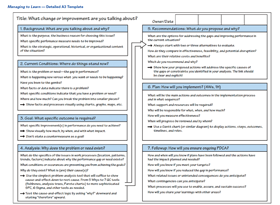
Detailed A3 Template (from Managing to Learn)
- Print this A3 template out to remind you of each section of the problem-solving A3 as you are creating your own.
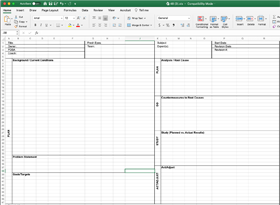
PDSA A3 Template (from On the Mend)
- A3 Template, in Excel, following the PDSA cycle.
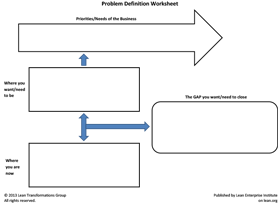
Problem Definition Worksheet
- This worksheet can help you breakdown the problem into a clearly defined gap as well as see how the problem aligns to the needs of the business or your True North purpose.
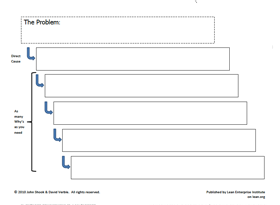
Root Cause Template
- This template gives you space to record the problem as well as the direct causes and underlying causes.
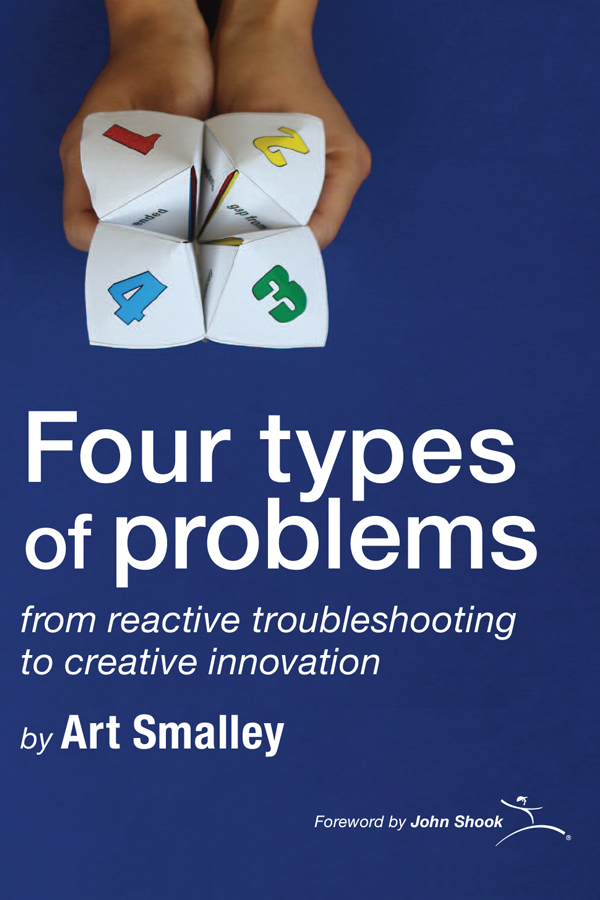
Four Types of Problems
Art Smalley
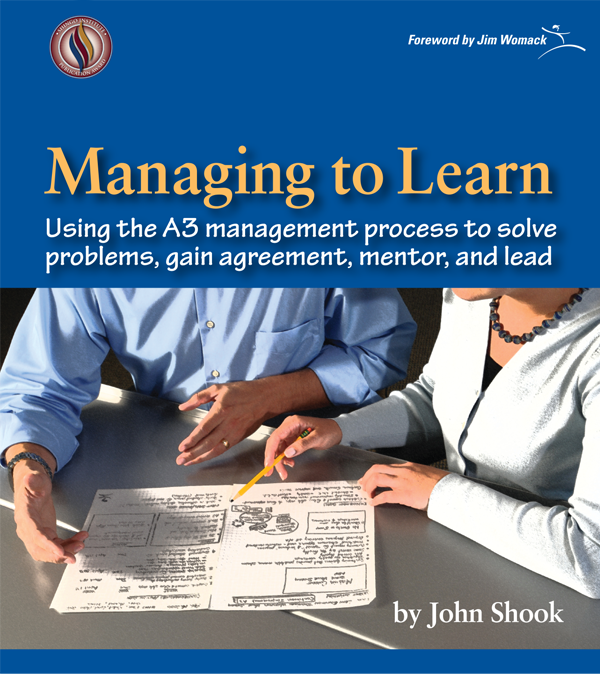
Managing to Learn: Using the A3 management process
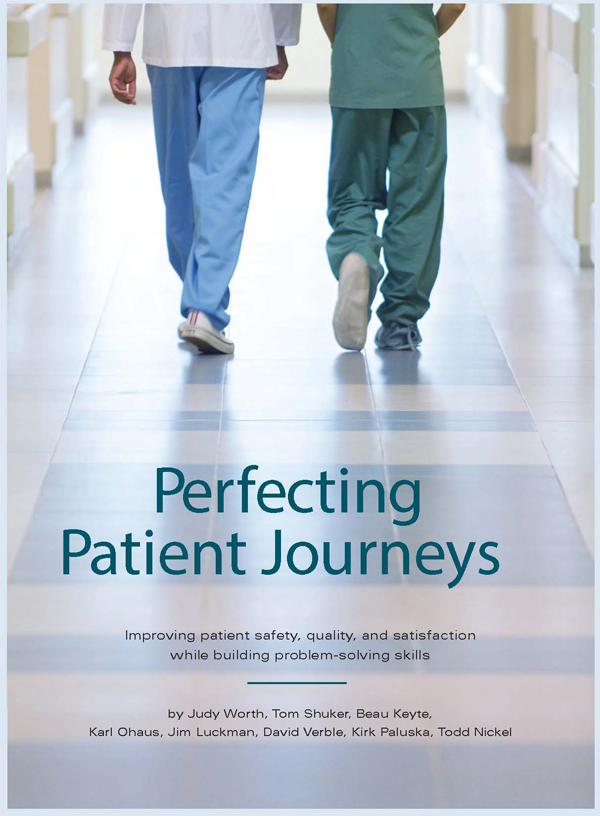
Perfecting Patient Journeys
Beau Keyte , Tom Shuker and Judy Worth
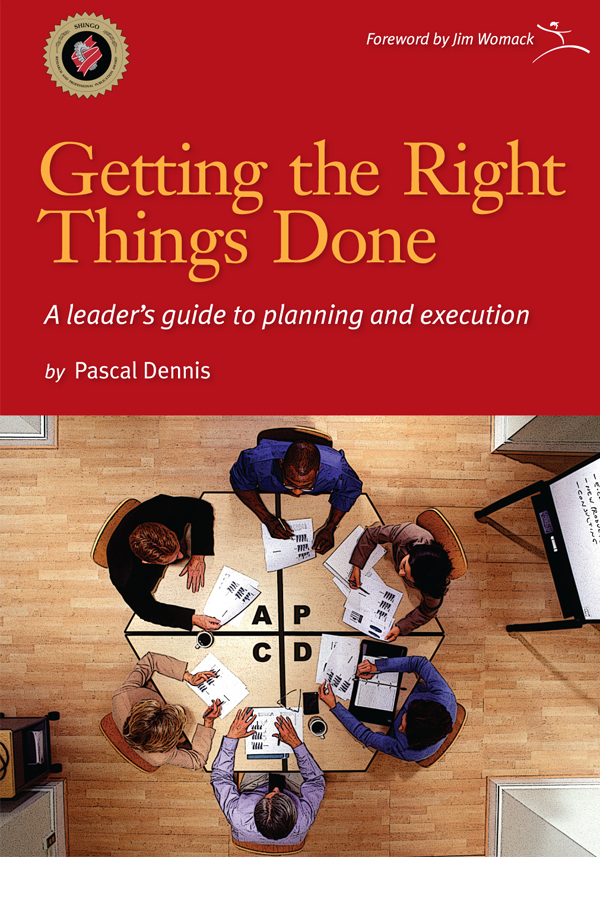
Getting the Right Things Done
Pascal Dennis
Standard Work Templates
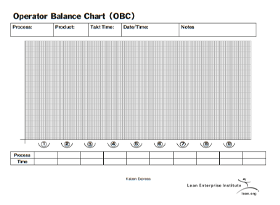
Standard Work Operator Balance Chart (OBC)
- The operator balance chart helps create continuous flow in a multi-step, multi-operator process by distributing operator work elements in relation to takt time.
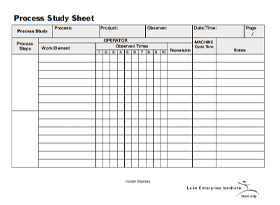
Standard Work Process Study Sheet
- The Process Study Sheet is used to define and record the time for work elements in a process.
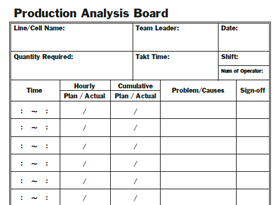
Standard Work Production Analysis Board
- A Production Analysis Board is a display that must be located at the exit of the cell (or the line) to show actual performance compared with planned performance on an hourly basis.
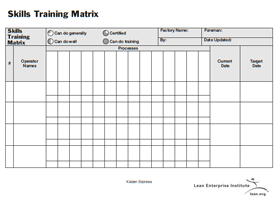
Standard Work Skills Training Matrix
- The Skills Training Matrix shows the required and attained skills of every operator.
- The training schedule also should be shown.
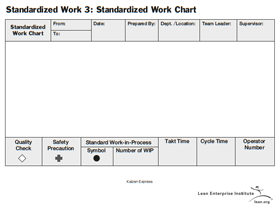
Standardized Work Chart
- The standardized work chart shows operator movement and material location in relation to the machine and overall process layout.
- It should show takt time, work sequence, and standard WIP.
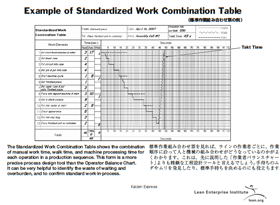
Standardized Work Combination Table
- The standardized work combination table shows the combination of manual work time, walk time, and machine processing time for each operation in a production sequence.
- This form is a more precise process design tool than the Operator Balance Chart.
- It can be very helpful to identify the waste of waiting and overburden, and to confirm standard.
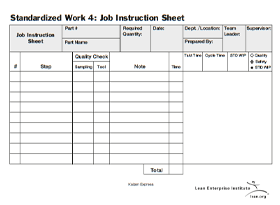
Standardized Work Job Instruction Sheet
- The job instruction sheet is used to train new operations.
- It lists the steps of the job, detailing any special knack that may be required to perform the job safely with utmost quality and efficiency.
- It can also be useful for experienced operators to reconfirm the right operations.
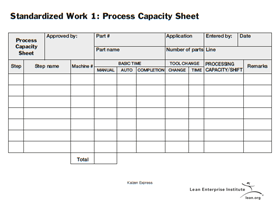
Standardized Work Process Capacity Sheet
- The Process Capacity Chart is used to calculate the capacity of each machine to confirm true capacity and to identify and eliminate bottlenecks.
- Processing capacity per shift will be calculated from the available production time, completion time, and tool-change time (and other factors as necessary) for each work piece.
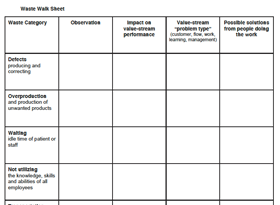
Waste Walk Template (from Perfecting Patient Journeys)
- Taking a “waste walk” is one way to make the waste visible again.
- A waste walk is simply a planned visit to where work is being performed to observe what’s happening and to note the waste. It differs from go-see activities in that you are specifically looking for waste.
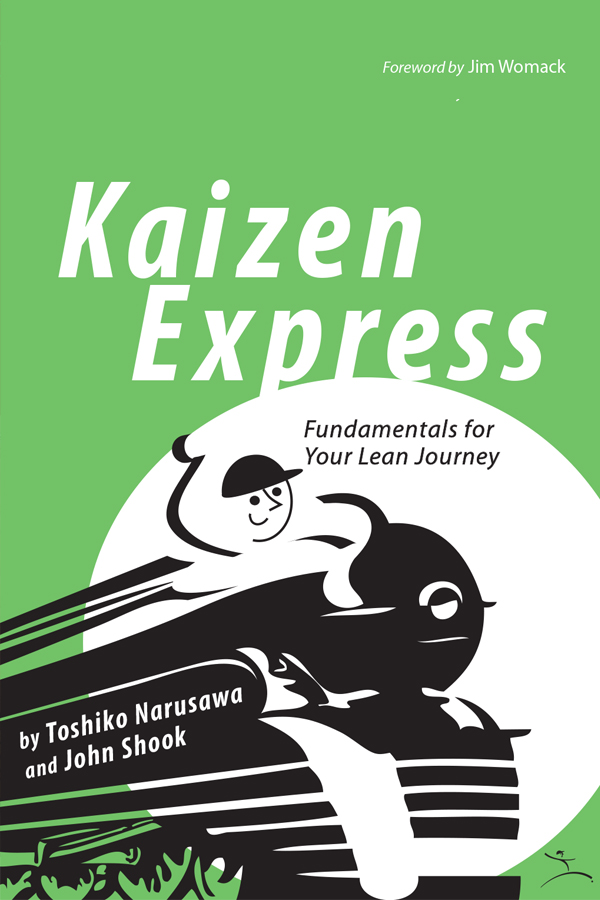
Kaizen Express
Toshiko Narusawa and John Shook
Lean Lexicon 5th Edition
Lean Enterprise Institute
Training Within Industry (TWI) Templates and Downloads
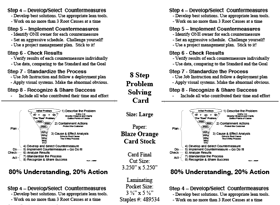
8-step TWI problem solving card - as presented by IBM
- 8-steps to problem solving handy pocket card printable.
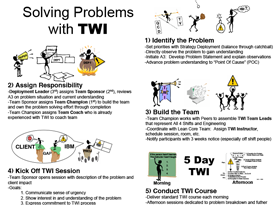
Solving Problems with TWI
- Solving problems with TWI deployment graphic.
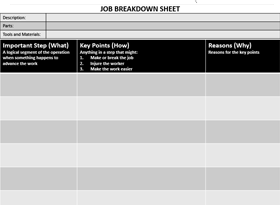
Template of Job Breakdown Sheet
- Job breakdown sheets are created to list the steps and highlight the main factors or key points that go into completing a job.
- It also provides reasons for these key points.
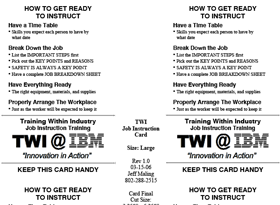
TWI Job Instruction Card
- TWI Job Instruction card in a handy pocket printable.
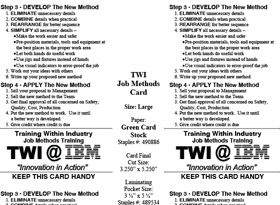
TWI Job Methods Card
- TWI Job Methods Card in a handy pocket printable.
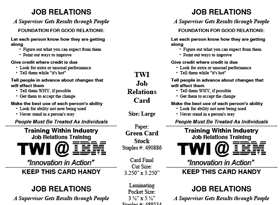
TWI Job Relations Card
- TWI Job Relations Card in a handy pocket printable.
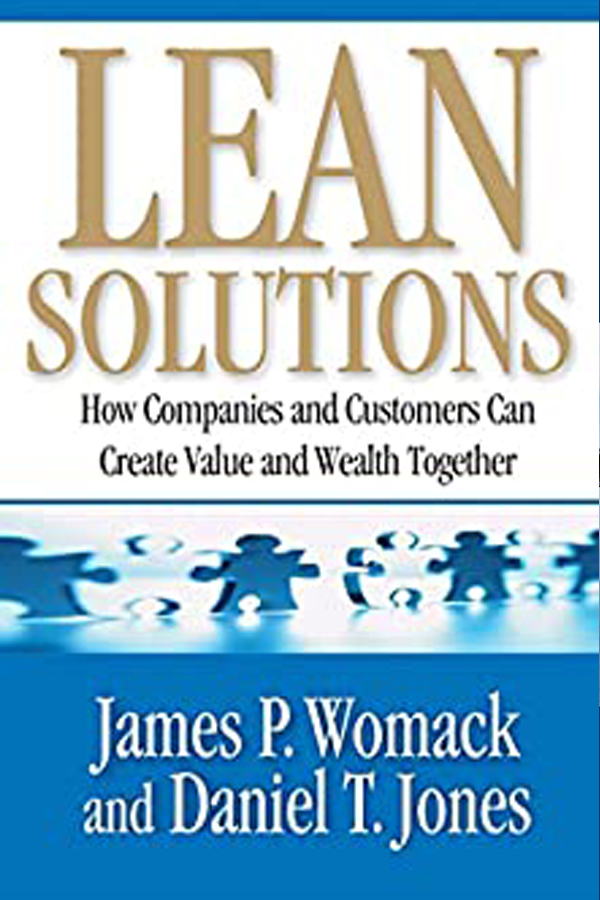
Lean Solutions
James (Jim) Womack, PhD and Dan Jones
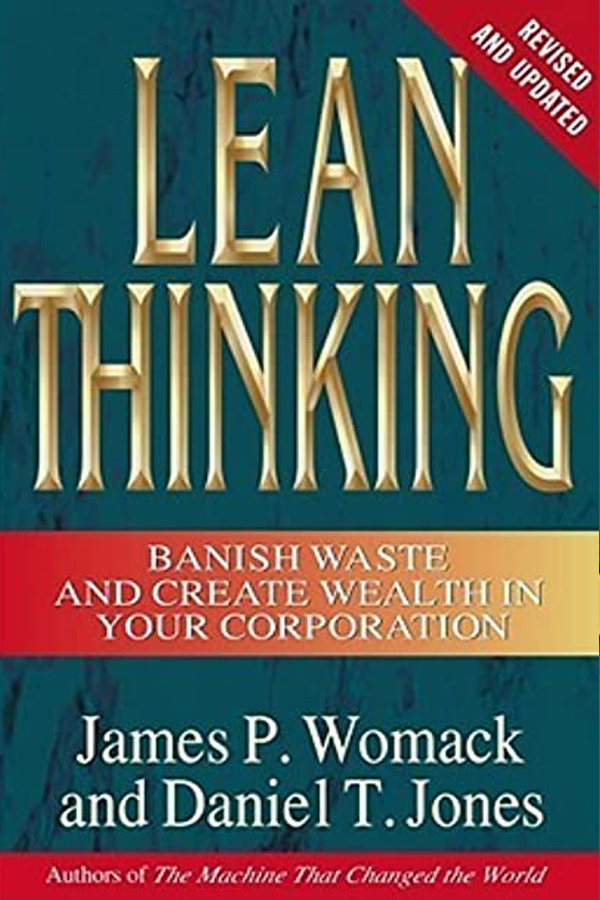
Lean Thinking, 2nd Edition
Project Management Templates
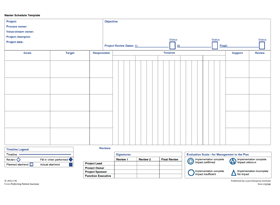
Master Schedule and Action Plan Template for One Goal (from Perfecting Patient Journeys)
- Use this template in your project tracking center so you can track both goals and action items on the same form.
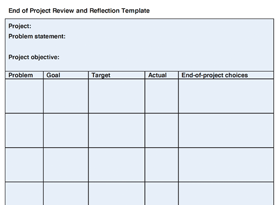
End of Project Review Template (from Perfecting Patient Journeys)
- The following template will help you capture your end-of-project reflections and make decisions about what to do next.
Master Schedule Template (from Perfecting Patient Journeys)
- This template will help you answer this question by letting you include the project goals with space to indicate whether each goal is on track as originally planned and whether the scheduled progress review has taken place.
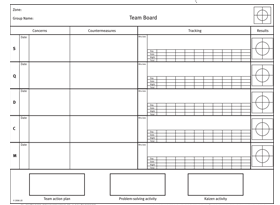
Team Board Form (from Getting the Right Things Done)
- A team board is a window on both routine and improvement work.
- The board on this template addresses both daily production and strategic issues, and is organized according to SQDCM—safety, quality, delivery, cost, and morale.
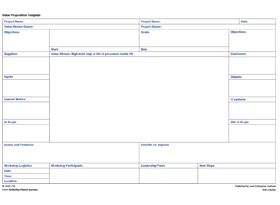
Value Proposition Template (from Perfecting Patient Journeys)
- Align the stakeholders around what will be included in addressing the problem,
- Identify the stakeholders who will be added to the project team and actively engaged in creating the current- and future-state value-stream maps,
- Identify additional stakeholders necessary to drive the implementation of the future state,
- Serve as an agreement—a proof of consensus—on the specific problem to be solved, and with the problem statement serve as authorization for the entire project.
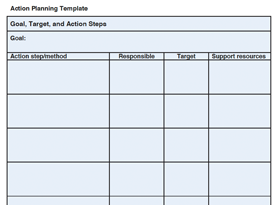
Action Planning Template (from Perfecting Patient Journeys)
- Identify the specific changes that need to be made and translate those changes into clearly stated goals and actions (i.e., the means) to achieve those goals.
- Identify the specific methods and action steps you think will help you achieve the goals. These action steps and targets constitute the action plan to achieve a specific goal.
Value-Stream Mapping Templates
Value-stream Mapping Icons for Excel
- At the request of some of our readers we have posted the most commonly used mapping icons so that they can be downloaded for Excel spreadsheets.
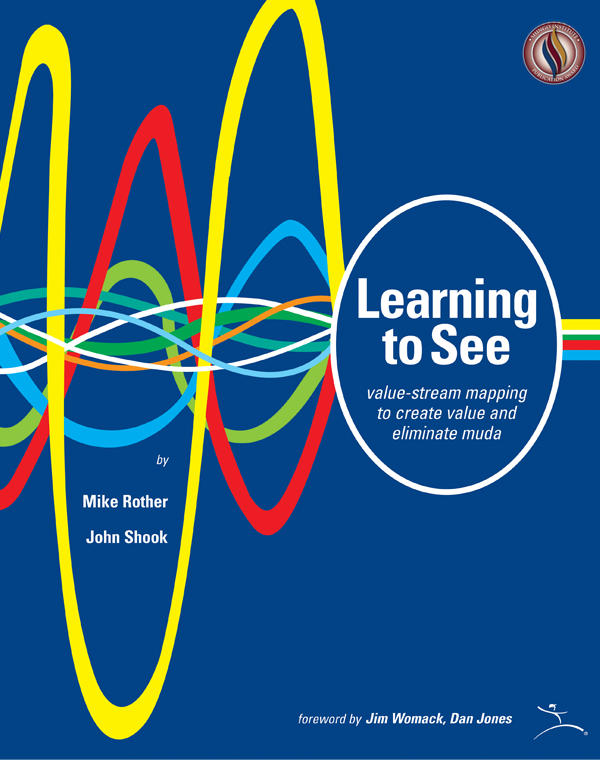
Learning to See
Mike Rother and John Shook
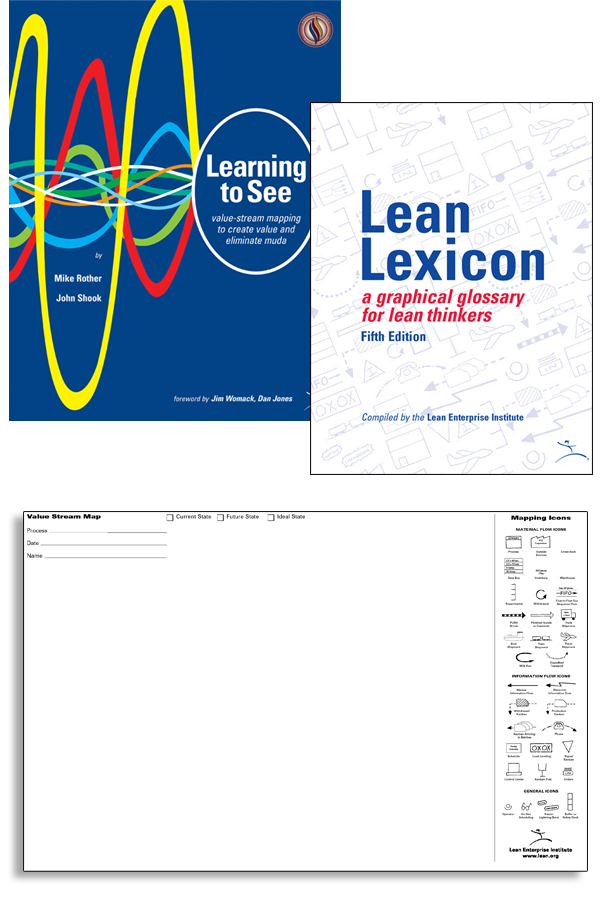
VSM Getting Started Set
Lean Enterprise Institute , Mike Rother and John Shook
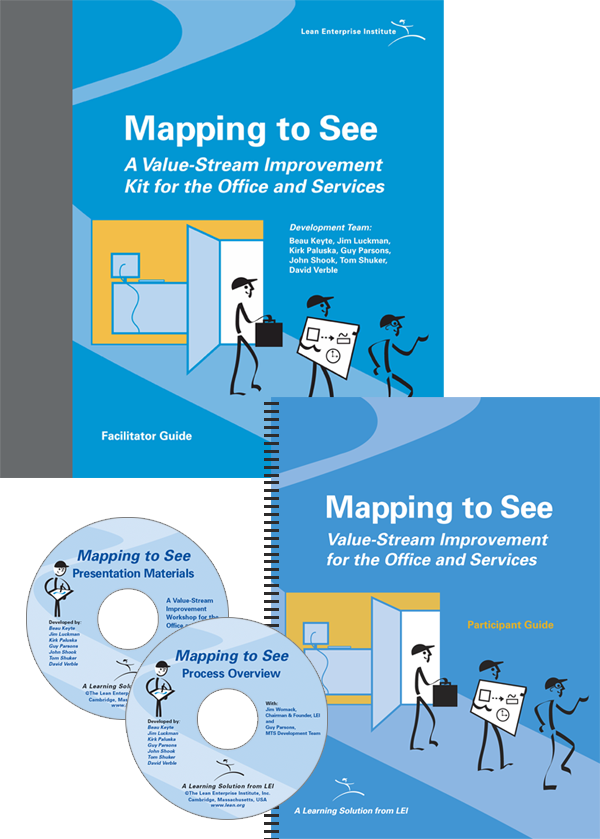
Mapping to See: Value-Stream Improvement Workshop
Beau Keyte , Jim Luckman , Kirk Paluska , Guy Parsons , John Shook , Tom Shuker and David Verble
Improvement Kata / Coaching Kata
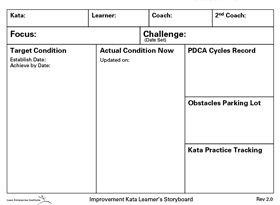
Improvement Kata Learner's Storyboard
Subscribe to get the very best of lean thinking delivered right to your inbox
Privacy overview.
How to master the seven-step problem-solving process
In this episode of the McKinsey Podcast , Simon London speaks with Charles Conn, CEO of venture-capital firm Oxford Sciences Innovation, and McKinsey senior partner Hugo Sarrazin about the complexities of different problem-solving strategies.
Podcast transcript
Simon London: Hello, and welcome to this episode of the McKinsey Podcast , with me, Simon London. What’s the number-one skill you need to succeed professionally? Salesmanship, perhaps? Or a facility with statistics? Or maybe the ability to communicate crisply and clearly? Many would argue that at the very top of the list comes problem solving: that is, the ability to think through and come up with an optimal course of action to address any complex challenge—in business, in public policy, or indeed in life.
Looked at this way, it’s no surprise that McKinsey takes problem solving very seriously, testing for it during the recruiting process and then honing it, in McKinsey consultants, through immersion in a structured seven-step method. To discuss the art of problem solving, I sat down in California with McKinsey senior partner Hugo Sarrazin and also with Charles Conn. Charles is a former McKinsey partner, entrepreneur, executive, and coauthor of the book Bulletproof Problem Solving: The One Skill That Changes Everything [John Wiley & Sons, 2018].
Charles and Hugo, welcome to the podcast. Thank you for being here.
Hugo Sarrazin: Our pleasure.
Charles Conn: It’s terrific to be here.
Simon London: Problem solving is a really interesting piece of terminology. It could mean so many different things. I have a son who’s a teenage climber. They talk about solving problems. Climbing is problem solving. Charles, when you talk about problem solving, what are you talking about?
Charles Conn: For me, problem solving is the answer to the question “What should I do?” It’s interesting when there’s uncertainty and complexity, and when it’s meaningful because there are consequences. Your son’s climbing is a perfect example. There are consequences, and it’s complicated, and there’s uncertainty—can he make that grab? I think we can apply that same frame almost at any level. You can think about questions like “What town would I like to live in?” or “Should I put solar panels on my roof?”
You might think that’s a funny thing to apply problem solving to, but in my mind it’s not fundamentally different from business problem solving, which answers the question “What should my strategy be?” Or problem solving at the policy level: “How do we combat climate change?” “Should I support the local school bond?” I think these are all part and parcel of the same type of question, “What should I do?”
I’m a big fan of structured problem solving. By following steps, we can more clearly understand what problem it is we’re solving, what are the components of the problem that we’re solving, which components are the most important ones for us to pay attention to, which analytic techniques we should apply to those, and how we can synthesize what we’ve learned back into a compelling story. That’s all it is, at its heart.
I think sometimes when people think about seven steps, they assume that there’s a rigidity to this. That’s not it at all. It’s actually to give you the scope for creativity, which often doesn’t exist when your problem solving is muddled.
Simon London: You were just talking about the seven-step process. That’s what’s written down in the book, but it’s a very McKinsey process as well. Without getting too deep into the weeds, let’s go through the steps, one by one. You were just talking about problem definition as being a particularly important thing to get right first. That’s the first step. Hugo, tell us about that.
Hugo Sarrazin: It is surprising how often people jump past this step and make a bunch of assumptions. The most powerful thing is to step back and ask the basic questions—“What are we trying to solve? What are the constraints that exist? What are the dependencies?” Let’s make those explicit and really push the thinking and defining. At McKinsey, we spend an enormous amount of time in writing that little statement, and the statement, if you’re a logic purist, is great. You debate. “Is it an ‘or’? Is it an ‘and’? What’s the action verb?” Because all these specific words help you get to the heart of what matters.
Want to subscribe to The McKinsey Podcast ?
Simon London: So this is a concise problem statement.
Hugo Sarrazin: Yeah. It’s not like “Can we grow in Japan?” That’s interesting, but it is “What, specifically, are we trying to uncover in the growth of a product in Japan? Or a segment in Japan? Or a channel in Japan?” When you spend an enormous amount of time, in the first meeting of the different stakeholders, debating this and having different people put forward what they think the problem definition is, you realize that people have completely different views of why they’re here. That, to me, is the most important step.
Charles Conn: I would agree with that. For me, the problem context is critical. When we understand “What are the forces acting upon your decision maker? How quickly is the answer needed? With what precision is the answer needed? Are there areas that are off limits or areas where we would particularly like to find our solution? Is the decision maker open to exploring other areas?” then you not only become more efficient, and move toward what we call the critical path in problem solving, but you also make it so much more likely that you’re not going to waste your time or your decision maker’s time.
How often do especially bright young people run off with half of the idea about what the problem is and start collecting data and start building models—only to discover that they’ve really gone off half-cocked.
Hugo Sarrazin: Yeah.
Charles Conn: And in the wrong direction.
Simon London: OK. So step one—and there is a real art and a structure to it—is define the problem. Step two, Charles?
Charles Conn: My favorite step is step two, which is to use logic trees to disaggregate the problem. Every problem we’re solving has some complexity and some uncertainty in it. The only way that we can really get our team working on the problem is to take the problem apart into logical pieces.
What we find, of course, is that the way to disaggregate the problem often gives you an insight into the answer to the problem quite quickly. I love to do two or three different cuts at it, each one giving a bit of a different insight into what might be going wrong. By doing sensible disaggregations, using logic trees, we can figure out which parts of the problem we should be looking at, and we can assign those different parts to team members.
Simon London: What’s a good example of a logic tree on a sort of ratable problem?
Charles Conn: Maybe the easiest one is the classic profit tree. Almost in every business that I would take a look at, I would start with a profit or return-on-assets tree. In its simplest form, you have the components of revenue, which are price and quantity, and the components of cost, which are cost and quantity. Each of those can be broken out. Cost can be broken into variable cost and fixed cost. The components of price can be broken into what your pricing scheme is. That simple tree often provides insight into what’s going on in a business or what the difference is between that business and the competitors.
If we add the leg, which is “What’s the asset base or investment element?”—so profit divided by assets—then we can ask the question “Is the business using its investments sensibly?” whether that’s in stores or in manufacturing or in transportation assets. I hope we can see just how simple this is, even though we’re describing it in words.
When I went to work with Gordon Moore at the Moore Foundation, the problem that he asked us to look at was “How can we save Pacific salmon?” Now, that sounds like an impossible question, but it was amenable to precisely the same type of disaggregation and allowed us to organize what became a 15-year effort to improve the likelihood of good outcomes for Pacific salmon.
Simon London: Now, is there a danger that your logic tree can be impossibly large? This, I think, brings us onto the third step in the process, which is that you have to prioritize.
Charles Conn: Absolutely. The third step, which we also emphasize, along with good problem definition, is rigorous prioritization—we ask the questions “How important is this lever or this branch of the tree in the overall outcome that we seek to achieve? How much can I move that lever?” Obviously, we try and focus our efforts on ones that have a big impact on the problem and the ones that we have the ability to change. With salmon, ocean conditions turned out to be a big lever, but not one that we could adjust. We focused our attention on fish habitats and fish-harvesting practices, which were big levers that we could affect.
People spend a lot of time arguing about branches that are either not important or that none of us can change. We see it in the public square. When we deal with questions at the policy level—“Should you support the death penalty?” “How do we affect climate change?” “How can we uncover the causes and address homelessness?”—it’s even more important that we’re focusing on levers that are big and movable.
Would you like to learn more about our Strategy & Corporate Finance Practice ?
Simon London: Let’s move swiftly on to step four. You’ve defined your problem, you disaggregate it, you prioritize where you want to analyze—what you want to really look at hard. Then you got to the work plan. Now, what does that mean in practice?
Hugo Sarrazin: Depending on what you’ve prioritized, there are many things you could do. It could be breaking the work among the team members so that people have a clear piece of the work to do. It could be defining the specific analyses that need to get done and executed, and being clear on time lines. There’s always a level-one answer, there’s a level-two answer, there’s a level-three answer. Without being too flippant, I can solve any problem during a good dinner with wine. It won’t have a whole lot of backing.
Simon London: Not going to have a lot of depth to it.
Hugo Sarrazin: No, but it may be useful as a starting point. If the stakes are not that high, that could be OK. If it’s really high stakes, you may need level three and have the whole model validated in three different ways. You need to find a work plan that reflects the level of precision, the time frame you have, and the stakeholders you need to bring along in the exercise.
Charles Conn: I love the way you’ve described that, because, again, some people think of problem solving as a linear thing, but of course what’s critical is that it’s iterative. As you say, you can solve the problem in one day or even one hour.
Charles Conn: We encourage our teams everywhere to do that. We call it the one-day answer or the one-hour answer. In work planning, we’re always iterating. Every time you see a 50-page work plan that stretches out to three months, you know it’s wrong. It will be outmoded very quickly by that learning process that you described. Iterative problem solving is a critical part of this. Sometimes, people think work planning sounds dull, but it isn’t. It’s how we know what’s expected of us and when we need to deliver it and how we’re progressing toward the answer. It’s also the place where we can deal with biases. Bias is a feature of every human decision-making process. If we design our team interactions intelligently, we can avoid the worst sort of biases.
Simon London: Here we’re talking about cognitive biases primarily, right? It’s not that I’m biased against you because of your accent or something. These are the cognitive biases that behavioral sciences have shown we all carry around, things like anchoring, overoptimism—these kinds of things.
Both: Yeah.
Charles Conn: Availability bias is the one that I’m always alert to. You think you’ve seen the problem before, and therefore what’s available is your previous conception of it—and we have to be most careful about that. In any human setting, we also have to be careful about biases that are based on hierarchies, sometimes called sunflower bias. I’m sure, Hugo, with your teams, you make sure that the youngest team members speak first. Not the oldest team members, because it’s easy for people to look at who’s senior and alter their own creative approaches.
Hugo Sarrazin: It’s helpful, at that moment—if someone is asserting a point of view—to ask the question “This was true in what context?” You’re trying to apply something that worked in one context to a different one. That can be deadly if the context has changed, and that’s why organizations struggle to change. You promote all these people because they did something that worked well in the past, and then there’s a disruption in the industry, and they keep doing what got them promoted even though the context has changed.
Simon London: Right. Right.
Hugo Sarrazin: So it’s the same thing in problem solving.
Charles Conn: And it’s why diversity in our teams is so important. It’s one of the best things about the world that we’re in now. We’re likely to have people from different socioeconomic, ethnic, and national backgrounds, each of whom sees problems from a slightly different perspective. It is therefore much more likely that the team will uncover a truly creative and clever approach to problem solving.
Simon London: Let’s move on to step five. You’ve done your work plan. Now you’ve actually got to do the analysis. The thing that strikes me here is that the range of tools that we have at our disposal now, of course, is just huge, particularly with advances in computation, advanced analytics. There’s so many things that you can apply here. Just talk about the analysis stage. How do you pick the right tools?
Charles Conn: For me, the most important thing is that we start with simple heuristics and explanatory statistics before we go off and use the big-gun tools. We need to understand the shape and scope of our problem before we start applying these massive and complex analytical approaches.
Simon London: Would you agree with that?
Hugo Sarrazin: I agree. I think there are so many wonderful heuristics. You need to start there before you go deep into the modeling exercise. There’s an interesting dynamic that’s happening, though. In some cases, for some types of problems, it is even better to set yourself up to maximize your learning. Your problem-solving methodology is test and learn, test and learn, test and learn, and iterate. That is a heuristic in itself, the A/B testing that is used in many parts of the world. So that’s a problem-solving methodology. It’s nothing different. It just uses technology and feedback loops in a fast way. The other one is exploratory data analysis. When you’re dealing with a large-scale problem, and there’s so much data, I can get to the heuristics that Charles was talking about through very clever visualization of data.
You test with your data. You need to set up an environment to do so, but don’t get caught up in neural-network modeling immediately. You’re testing, you’re checking—“Is the data right? Is it sound? Does it make sense?”—before you launch too far.
Simon London: You do hear these ideas—that if you have a big enough data set and enough algorithms, they’re going to find things that you just wouldn’t have spotted, find solutions that maybe you wouldn’t have thought of. Does machine learning sort of revolutionize the problem-solving process? Or are these actually just other tools in the toolbox for structured problem solving?
Charles Conn: It can be revolutionary. There are some areas in which the pattern recognition of large data sets and good algorithms can help us see things that we otherwise couldn’t see. But I do think it’s terribly important we don’t think that this particular technique is a substitute for superb problem solving, starting with good problem definition. Many people use machine learning without understanding algorithms that themselves can have biases built into them. Just as 20 years ago, when we were doing statistical analysis, we knew that we needed good model definition, we still need a good understanding of our algorithms and really good problem definition before we launch off into big data sets and unknown algorithms.
Simon London: Step six. You’ve done your analysis.
Charles Conn: I take six and seven together, and this is the place where young problem solvers often make a mistake. They’ve got their analysis, and they assume that’s the answer, and of course it isn’t the answer. The ability to synthesize the pieces that came out of the analysis and begin to weave those into a story that helps people answer the question “What should I do?” This is back to where we started. If we can’t synthesize, and we can’t tell a story, then our decision maker can’t find the answer to “What should I do?”
Simon London: But, again, these final steps are about motivating people to action, right?
Charles Conn: Yeah.
Simon London: I am slightly torn about the nomenclature of problem solving because it’s on paper, right? Until you motivate people to action, you actually haven’t solved anything.
Charles Conn: I love this question because I think decision-making theory, without a bias to action, is a waste of time. Everything in how I approach this is to help people take action that makes the world better.
Simon London: Hence, these are absolutely critical steps. If you don’t do this well, you’ve just got a bunch of analysis.
Charles Conn: We end up in exactly the same place where we started, which is people speaking across each other, past each other in the public square, rather than actually working together, shoulder to shoulder, to crack these important problems.
Simon London: In the real world, we have a lot of uncertainty—arguably, increasing uncertainty. How do good problem solvers deal with that?
Hugo Sarrazin: At every step of the process. In the problem definition, when you’re defining the context, you need to understand those sources of uncertainty and whether they’re important or not important. It becomes important in the definition of the tree.
You need to think carefully about the branches of the tree that are more certain and less certain as you define them. They don’t have equal weight just because they’ve got equal space on the page. Then, when you’re prioritizing, your prioritization approach may put more emphasis on things that have low probability but huge impact—or, vice versa, may put a lot of priority on things that are very likely and, hopefully, have a reasonable impact. You can introduce that along the way. When you come back to the synthesis, you just need to be nuanced about what you’re understanding, the likelihood.
Often, people lack humility in the way they make their recommendations: “This is the answer.” They’re very precise, and I think we would all be well-served to say, “This is a likely answer under the following sets of conditions” and then make the level of uncertainty clearer, if that is appropriate. It doesn’t mean you’re always in the gray zone; it doesn’t mean you don’t have a point of view. It just means that you can be explicit about the certainty of your answer when you make that recommendation.
Simon London: So it sounds like there is an underlying principle: “Acknowledge and embrace the uncertainty. Don’t pretend that it isn’t there. Be very clear about what the uncertainties are up front, and then build that into every step of the process.”
Hugo Sarrazin: Every step of the process.
Simon London: Yeah. We have just walked through a particular structured methodology for problem solving. But, of course, this is not the only structured methodology for problem solving. One that is also very well-known is design thinking, which comes at things very differently. So, Hugo, I know you have worked with a lot of designers. Just give us a very quick summary. Design thinking—what is it, and how does it relate?
Hugo Sarrazin: It starts with an incredible amount of empathy for the user and uses that to define the problem. It does pause and go out in the wild and spend an enormous amount of time seeing how people interact with objects, seeing the experience they’re getting, seeing the pain points or joy—and uses that to infer and define the problem.
Simon London: Problem definition, but out in the world.
Hugo Sarrazin: With an enormous amount of empathy. There’s a huge emphasis on empathy. Traditional, more classic problem solving is you define the problem based on an understanding of the situation. This one almost presupposes that we don’t know the problem until we go see it. The second thing is you need to come up with multiple scenarios or answers or ideas or concepts, and there’s a lot of divergent thinking initially. That’s slightly different, versus the prioritization, but not for long. Eventually, you need to kind of say, “OK, I’m going to converge again.” Then you go and you bring things back to the customer and get feedback and iterate. Then you rinse and repeat, rinse and repeat. There’s a lot of tactile building, along the way, of prototypes and things like that. It’s very iterative.
Simon London: So, Charles, are these complements or are these alternatives?
Charles Conn: I think they’re entirely complementary, and I think Hugo’s description is perfect. When we do problem definition well in classic problem solving, we are demonstrating the kind of empathy, at the very beginning of our problem, that design thinking asks us to approach. When we ideate—and that’s very similar to the disaggregation, prioritization, and work-planning steps—we do precisely the same thing, and often we use contrasting teams, so that we do have divergent thinking. The best teams allow divergent thinking to bump them off whatever their initial biases in problem solving are. For me, design thinking gives us a constant reminder of creativity, empathy, and the tactile nature of problem solving, but it’s absolutely complementary, not alternative.
Simon London: I think, in a world of cross-functional teams, an interesting question is do people with design-thinking backgrounds really work well together with classical problem solvers? How do you make that chemistry happen?
Hugo Sarrazin: Yeah, it is not easy when people have spent an enormous amount of time seeped in design thinking or user-centric design, whichever word you want to use. If the person who’s applying classic problem-solving methodology is very rigid and mechanical in the way they’re doing it, there could be an enormous amount of tension. If there’s not clarity in the role and not clarity in the process, I think having the two together can be, sometimes, problematic.
The second thing that happens often is that the artifacts the two methodologies try to gravitate toward can be different. Classic problem solving often gravitates toward a model; design thinking migrates toward a prototype. Rather than writing a big deck with all my supporting evidence, they’ll bring an example, a thing, and that feels different. Then you spend your time differently to achieve those two end products, so that’s another source of friction.
Now, I still think it can be an incredibly powerful thing to have the two—if there are the right people with the right mind-set, if there is a team that is explicit about the roles, if we’re clear about the kind of outcomes we are attempting to bring forward. There’s an enormous amount of collaborativeness and respect.
Simon London: But they have to respect each other’s methodology and be prepared to flex, maybe, a little bit, in how this process is going to work.
Hugo Sarrazin: Absolutely.
Simon London: The other area where, it strikes me, there could be a little bit of a different sort of friction is this whole concept of the day-one answer, which is what we were just talking about in classical problem solving. Now, you know that this is probably not going to be your final answer, but that’s how you begin to structure the problem. Whereas I would imagine your design thinkers—no, they’re going off to do their ethnographic research and get out into the field, potentially for a long time, before they come back with at least an initial hypothesis.

Want better strategies? Become a bulletproof problem solver
Hugo Sarrazin: That is a great callout, and that’s another difference. Designers typically will like to soak into the situation and avoid converging too quickly. There’s optionality and exploring different options. There’s a strong belief that keeps the solution space wide enough that you can come up with more radical ideas. If there’s a large design team or many designers on the team, and you come on Friday and say, “What’s our week-one answer?” they’re going to struggle. They’re not going to be comfortable, naturally, to give that answer. It doesn’t mean they don’t have an answer; it’s just not where they are in their thinking process.
Simon London: I think we are, sadly, out of time for today. But Charles and Hugo, thank you so much.
Charles Conn: It was a pleasure to be here, Simon.
Hugo Sarrazin: It was a pleasure. Thank you.
Simon London: And thanks, as always, to you, our listeners, for tuning into this episode of the McKinsey Podcast . If you want to learn more about problem solving, you can find the book, Bulletproof Problem Solving: The One Skill That Changes Everything , online or order it through your local bookstore. To learn more about McKinsey, you can of course find us at McKinsey.com.
Charles Conn is CEO of Oxford Sciences Innovation and an alumnus of McKinsey’s Sydney office. Hugo Sarrazin is a senior partner in the Silicon Valley office, where Simon London, a member of McKinsey Publishing, is also based.
Explore a career with us
Related articles.

Strategy to beat the odds

Five routes to more innovative problem solving
Workshop templates
Find inspiration for your next session with a high quality workshop template . speed up your workshop planning process and increase engagement among your workshop participants with a proven process..
Follow instructions from an expert facilitator or adjust the workshop template to your needs!
Workshop Planning Template
This template makes the process of planning a workshop easier by laying out clearly each step to be covered. It is divided into five meetings, each lasting an hour.
Sharing a vision
Defining the agenda
Refining the agenda
Briefing the team
Collecting learnings
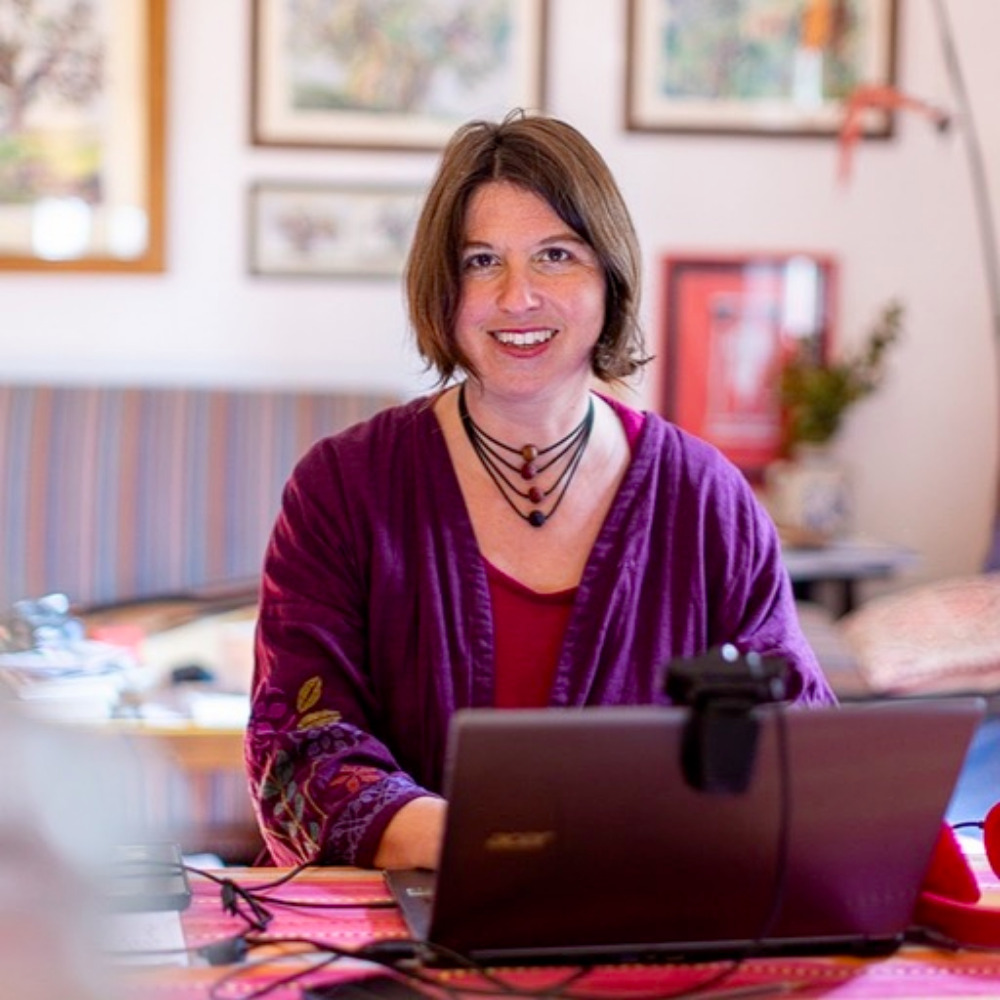
Leadership development workshop (ideal for new leaders)

Team Development Day for a New Team
- Understand what a real team is and why it is important
- Become clearer about their collective purpose and goals
- Experience working effectively as a team and help team members to feel more comfortable with one another
- Take part in a fun, memorable and engaging experience

The Art of Effective Feedback
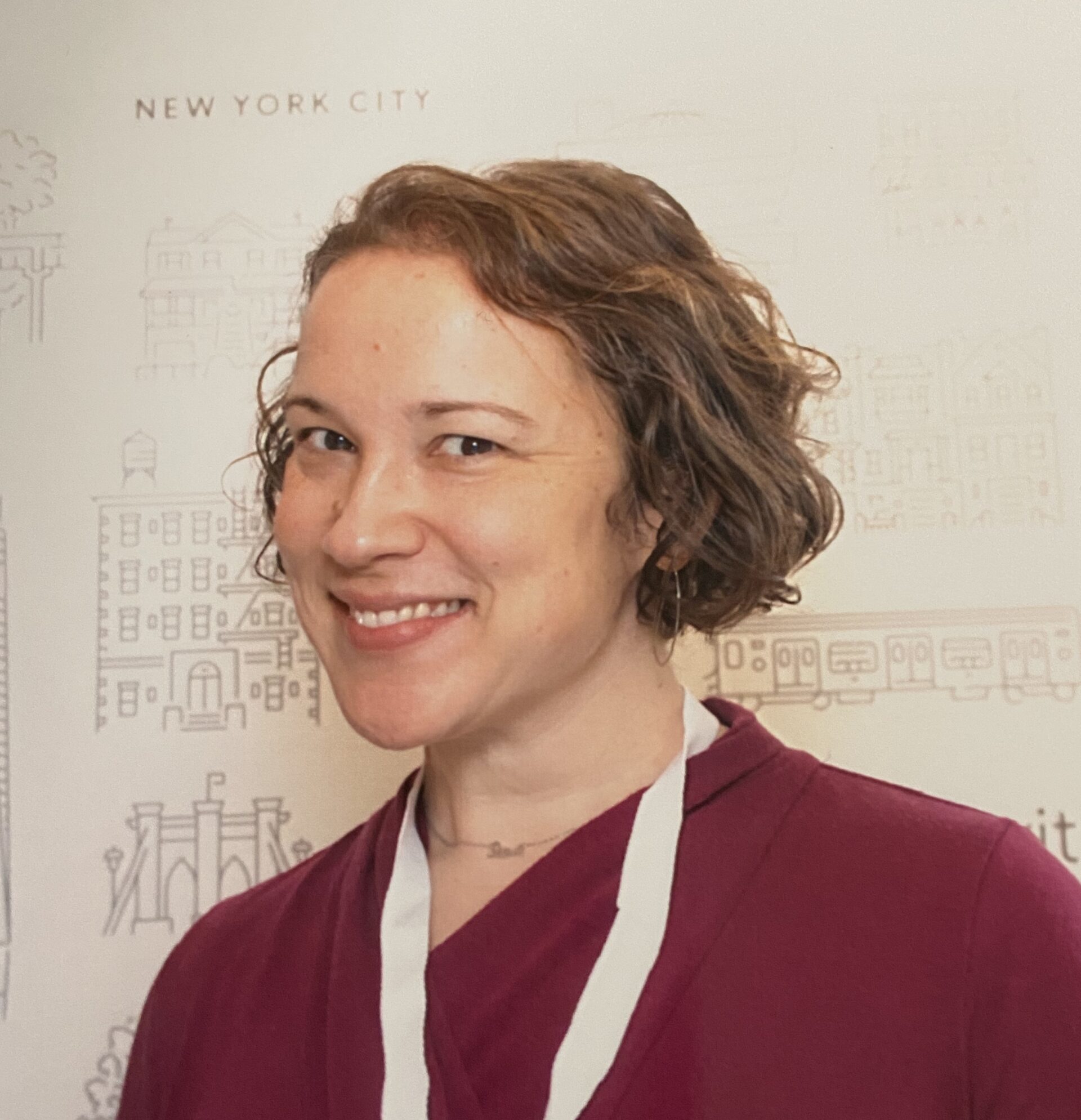
Ideation Workshop
- Facilitators : 1-2 experienced facilitators
- Participants : 12-30
- Difficulty level : medium
- Time : full day
- Goal : come up with a large number of innovative ideas and inspire participants with disruptive cases, future tech and trends and opposite thinking.
Credits to Board of Innovation for the workshop template. You will find the original version here.

Essential Training Session
Create training sessions tailored to your needs and your participants, starting with the essential building blocks of great learning experiences. In this template for experiential learning, based on Kolb's learning cycle, you will find space to prepare the group, practice skills, learn new content and reflect on how to apply it to real-world situations after the training. Simply click on Export, then Duplicate this session to tailor it to your needs, add your favorite activities and adapt the flow to your group!
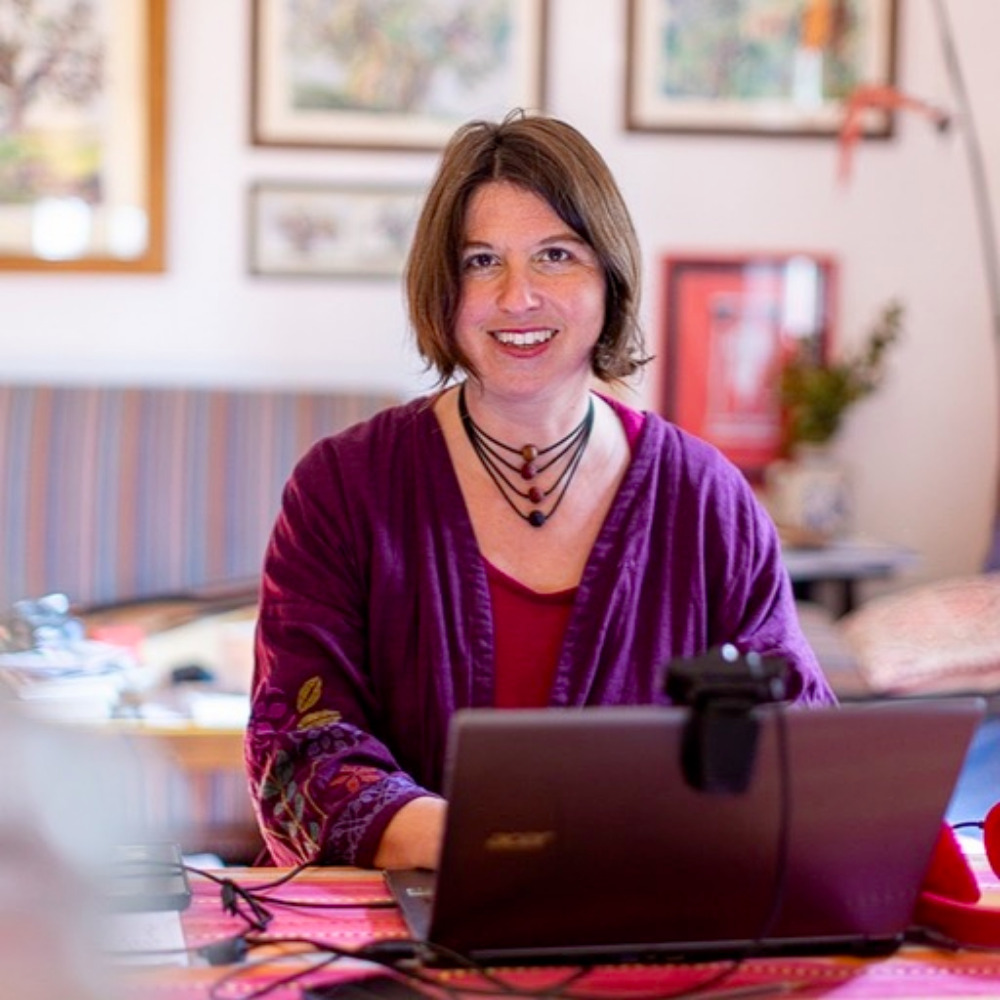
Team Health Check Retrospective
A simple yet powerful retrospective format that allows teams to self-assess their health and quickly identify and prioritize the right areas for improvement. Ideally used as a team health and happiness tracking tool at the end of each sprint (or once a month).
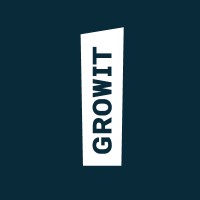
Lesson Plan Template
This lesson plan contains ideas drawn from facilitation practices that you can apply to the classroom straight away. Combine individual reflection, paired conversations and teamwork to the presentation of your content to support effective learning! Simply click on Export, then Duplicate this session to tailor it to your needs, move activities around and tailor it to your learners!
ADDIE model template
This template makes the process of preparing your online courses easier by laying out each step to be covered. It is based on the popular ADDIE model of Instructional Design.
The template is divided into five sections
Team dynamics workshop
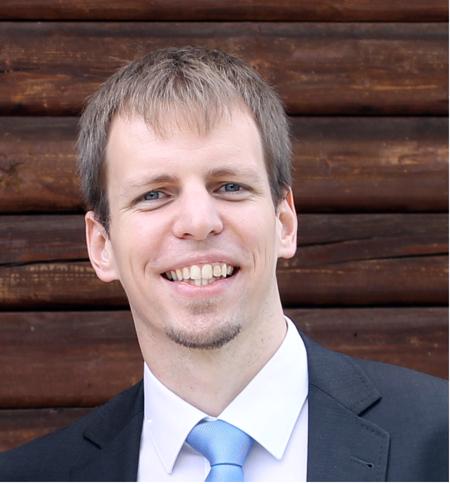
Instructional Design Storyboard
In this collection of 4 elearning storyboard templates, you'll find everything you need to quickly start creating an effective storyboard for your next instructional design project.
You'll find:
- a simple two-column elearning storyboard format with space for all common storyboarding elements
- an elearning storyboard format suitable for quizzes and branching scenario elearning projects
- an instructional design storyboard format based on Gagne's 9 events of instruction
- an instructional design storyboard format based on Merill's 5 principles of instruction
In these templates, you'll find color-coding based on Gagne's 9 events of instruction (my preferred instructional design framework) though feel free to alter the categorization to meet your needs.
Want to learn more about how to create a storyboard? Check out our complete guide to storyboarding .
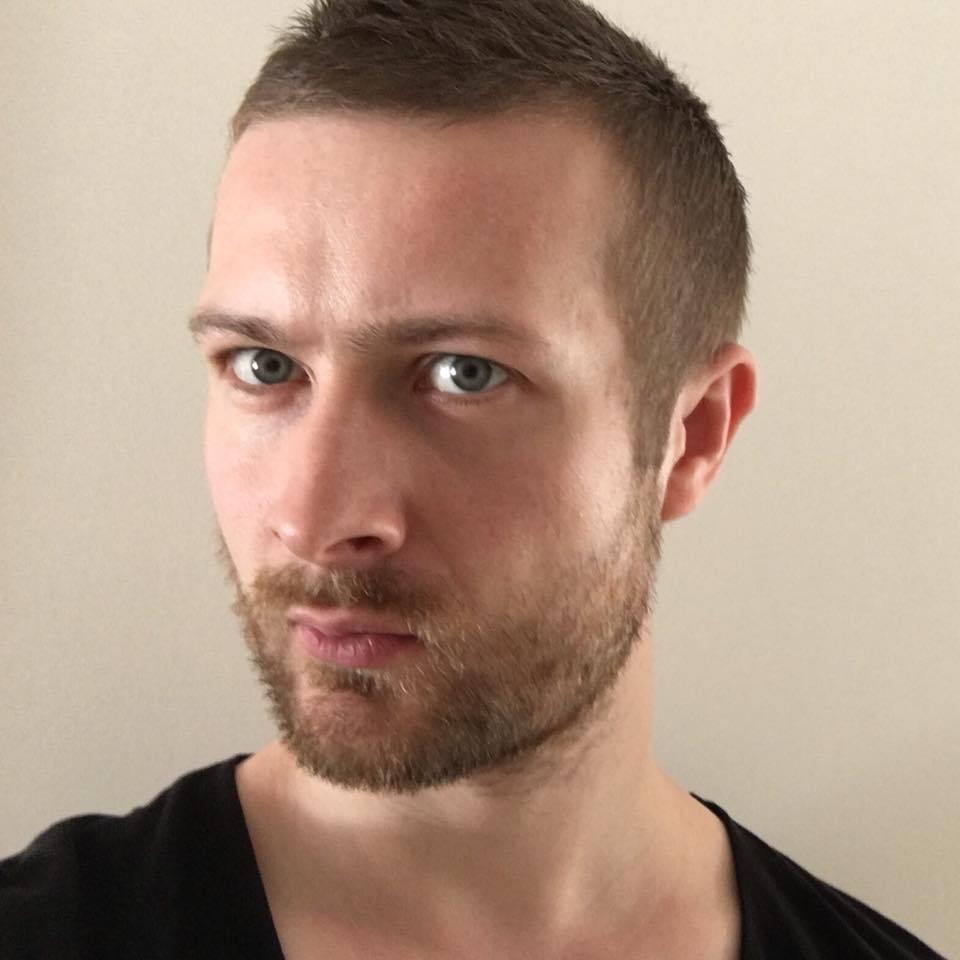
Business Model Canvas Workshop
The Business Model Canvas (BMC) is a simple, visual tool that maps out the nine key areas that are essential to any project, initiative, or business. By thinking through and completing the nine sections of a BMC, early stage change-makers, like entrepreneurs and intrepreneurs, not only design their business model but also answer the fundamental questions any business must solve.
The BMC enables people to temporarily separate themselves from their idea and adopt a bird’s eye view of how things will work, in practice.
While BMCs are extremely helpful to flesh out ideas at the earliest stages of development, they can also bring much value even when the project or business already exists.
By thinking through the nine essential areas of the BMC, aspiring entrepreneurs and intrapreneurs gain the traction to experiment and take progressive steps toward bringing their ideas to life.
Based upon Strategyzer's Business Model Canvas. Utilized under Creative Commons Attribution-ShareAlike 3.0
Download the Business Model Canvas here: https://www.strategyzer.com/canvas/business-model-canvas

Design Sprint 2.0
- It takes four days instead of five.
- You only need the full Sprint team for two days instead of five

Blended Learning Course Template
Are you preparing to launch a new learning experience? In a blended learning course, some parts are online and self-paced, while others get learners in the same room (remotely or in person) for workshop activities. This template showcases how to use different blocks in SessionLab to neatly organize all your training information. Simply copy-paste it and start making changes to adapt it to your learning course needs!
Facilitation for Beginners
A tried-and-tested half-day session to introduce newcomers to facilitation.
Have you been asked to share your facilitation knowledge with colleagues? Or perhaps you are planning to train youth for a future of excellent teamwork?
This 3-part workshop covers the basics, allowing participants to experience facilitation while building the skills to facilitate themselves.
PARTICIPANTS (recommended): 8 to 24
Lightning Decision Jam (LDJ)
Uncover and Solve Problems without Unstructured Discussion
- Unclear goals and miscommunication that cause busy work and overtime
- Unstructured meetings that leave attendants tired, confused and without clear outcomes
- Frustration builds up because internal challenges to productivity are not addressed
- Sudden changes in priorities lead to a loss of focus and momentum
- Muddled compromise takes the place of clear decision- making, leaving everybody to come up with their own interpretation.
This is why AJ&Smart created Lightning Decision Jam (LDJ). It’s a simple and short, but powerful group exercise that can be run either in-person, in the same room, or remotely with distributed teams.
2. We work together, alone Instead of working in an open forum where the loudest, most extroverted person can push their ideas on the group until they get exhausted and give in, we create an environment where every individual can contribute ideas, without any group discussion or debate. All participants work alone, but aligned on a common goal with the rest of the team.
If you describe an idea to your team, everybody will have a completely different interpretation of what you were trying to communicate. This leads to a lot of unnecessary confusion. Instead, when presenting our ideas, we make them as tangible as possible, whether through sketching them out, or showing comparable examples.
In addition to this workshop template, we also offer videos demonstrating how to use LDJs on our YouTube channel at: www.youtube.com/ajsmart .
Overview: www.youtu.be/33hBnZzoFAg
1-Hour Guided Workshop: https://youtu.be/w9MvYDaA1Bk
Remote LDJ: https://youtu.be/0iVQYHHCTf0
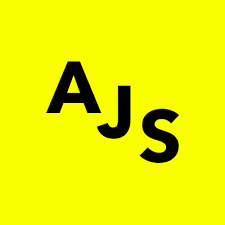
Essential workshop structure
Jump-start your design process with this basic structure for a generic workshop, and adapt it to your needs. In this template you'll find the building blocks of a facilitated workshop experience, with ideas and inspiration for an opening section and a closing, and possible timings for two main activities. Simply click on Export, then Duplicate this model to tailor this session to your group by adding your favorite exercises and the main activities you plan to run!
One-hour Brain Sprint
- Effectively generate ideas while avoiding the common pitfalls of regular brainstorming sessions.
- Be concise and timebox all of the exercises to ideate faster.
- The brain sprint aligns a group of creatives and avoids discussions.
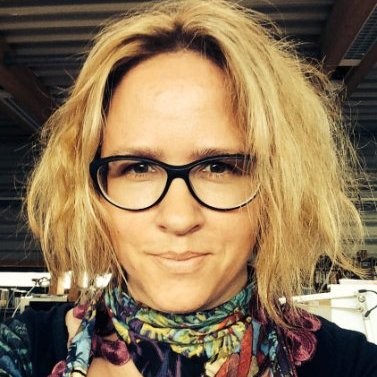
Quarterly planning & goal setting workshop
This is an effective goal setting and alignment process that helps teams to define the priorities for an upcoming period - typically to set key objectives (Rocks) for a quarter.
This template agenda will give you a step-by-step process to follow, and you can find more information and real-life examples in the following blog post:
https://www.sessionlab.com/blog/quarterly-planning-workshop
Effective Meeting Agenda
This is a basic, flexible template illustrating the building blocks of an effective meeting. Adapt the timing of the session to your own needs and get started in the journey to make your organization's meetings the best they can be! For more on facilitating a meeting, find some quick tips and tricks in this guide.
Morning meeting
A morning meeting is a familiar way of starting the day in many kindergartens and schools. The types of activities and style can change as the children grow up, but the general structure will work with all ages. In fact, it is not at all different from a morning check-in or stand up company meeting! A morning meeting generally lasts about 30 minutes and follows a general outline:
- Greeting - saying hello to students
- Sharing - asking an open question to invite students to share something about their lives or a reaction to a topic
- Group activity - a game, poem, song, or fun activity
- Morning message - a message from the teachers about the day, usually introducing a topic that will be covered in the next classes and the “why” behind it
Use this template for inspiration and to keep track of timing!
Paper Tiger Pre-Mortem Workshop
A pre-mortem is a technique where, before starting a project or decision, a team imagines it has failed and discusses reasons for that failure. This helps identify potential problems early on, allowing the team to address and prevent them proactively.

System Mapping Workshop
A 3-hour workshop designed to help your organization see the big picture. Literally. Gather team members and stakeholders together to visualize the various elements of a system and draw connections. With a map of the territory finally at hand, discuss findings, gain insights, and potentially even define points of intervention for innovation and change.
Some applications of system mapping workshops are:
Identifying points of intervention in a large organisation.
Facilitating circular economy projects.
Landscape and resource management and policy-making.
Preparing for multi-stakeholder participatory processes.
Helping NGOs and volunteer organizations select impactful projects.
..and more!
At this link you can find a slide deck explaining how the University of Edinburgh used this approach to map a whole production system , using causal loops and identifying points for intervention.
FACILITATION NOTES
You will need a flexible space with plenty of room for people to move around, small-group tables, and space on the walls to stick and organize notes. If you are working online or in hybrid mode, prepare a shared whiteboard everyone can work on.
HYBRID FACILITATION
People who share the same mode of participation will get the most from working with one another. You don't want people who are in the same room to spend all the 3 hours at their computer as if they were working remotely! With this in mind, design for discussions and sharing to happen among people who are in the same location (in other words, ask the people in the room to discuss with one another and those joining remotely to discuss among themselves). Then, make sure everyone puts their map in the same online whiteboard and facilitate comparisons. How can each map enrich the others?
Hybrid workshops notoriously need more attention to the tech setup. Make sure everyone can clearly see the shared map (e.g. with a good projector setup), and that you have great wi-fi in the room.
Ask Me Anything Workshop
Main objective: The workshop helps promote a culture of active listening where no question is too stupid, and where it is okay to say ‘I don’t know’ and to ask for help.
The workshop works well with:
- large groups
- large organizations and/or organizations that happen to get slowed down by bureaucracy, size, such as public services or universities, or that have undergone significant structural changes
- Organizations that have recently merged
- Organizations that have recently hired new employees
Number of participants : 8+ Ideally between 50 and 100 Mode : in-person
Set-up : Position the chairs in circles of four. Later on, put a container with questions at the centre of every group of chairs.
This template was the winner of the "Beginner Friendly" award in the April 2023 innovative workshop design contest.

Board Meeting Agenda
Location: [Insert Location or Virtual Meeting Link]
Chairperson: [Insert Chairperson's Name]
Secretary: [Insert Secretary's Name]
This classic board meeting agenda is a tried and tested way for boards and committees to align, share reports and discuss old and new business before setting action items and adjourning. You'll find each agenda item attached to a block so you can easily overview and adjust the agenda if you need.
Depending on the maturity of your board, you may make this session longer or shorter than is designated here. Adjust the timing of each block to effectively time-box each agenda item and make your session flow.
You may also find your own board meeting has additional items, such as a space to reiterate mission and vision statements, discuss chair nominations or other items. Simply add new blocks or drag and drop existing ones to make this session work for your needs.
We've set each agenda item to have a task checklist attached so when running the meeting, you can simply check the item off so you know it's done!
Daily Scrum Meeting
This 15-minute meeting agenda is based on the Daily Scrum ritual of an Agile team, though it suits just as well for any team doing a daily check-in!
After a brief introduction, teams go through a process of answering three questions:
What did you do yesterday?
What will you do today?
What's in your way?
By working through these three simple questions in just fifteen minutes, you and your team can quickly get aligned and start the day effectively! In this template, you'll find a two variations of the agenda ready to tailor to your needs. In the step-by-step version, you'll ask everyone in the group to give updates for what happened yesterday before moving onto the next section.
In the Round Robin variation, you'll ask each team member to give all their updates at once before moving onto the next team member. Each variation has its merits, though at SessionLab, we tend to prefer going step-by-step!
Essential Agile Kickoff Meeting
Effective communication skills are essential for all involved in a project using any Agile approach! A kickoff is a short session for the team responsible for developing a solution to understand the objectives, accept them as realistic, and feel empowered and inspired to deliver a solution. This template has been created considering the DSDM principle "Communicate continuously and clearly" which underpins many the Agile principle of " Individuals and interactions over processes and tools". DSDM is an Agile method that focuses on the full project lifecycle, from Kickoff to Close-Out or Retrospective.
A kickoff is vital for effective teamwork and to ensure transparency. A s the name suggests, it kicks off an allocated timebox and outlines the objectives. It is not a meeting to find the solutions, but rather to equip team members with clear objectives to empower them to find the solutions.
The agile approach favors face-to-face communication, and a kickoff can be done virtually or in person, depending on if the team is co-located or remote. The key objectives of a kickoff are to:
- Review objectives for the timebox and understand what is to be achieved
- Ensure that the deliverables are still feasible within the time box, and re-plan if this isn't possible
- Agree on the acceptance criteria for each deliverable
- Review the availability of all team members who will participate in this time box and decide on roles and take ownership of responsibilities.
- Highlight any known dependencies
The beauty of templates is that you can adjust them to fit your own team's needs. These are the starting blocks to your Agile kickoff and are yours to move around as you see fit!
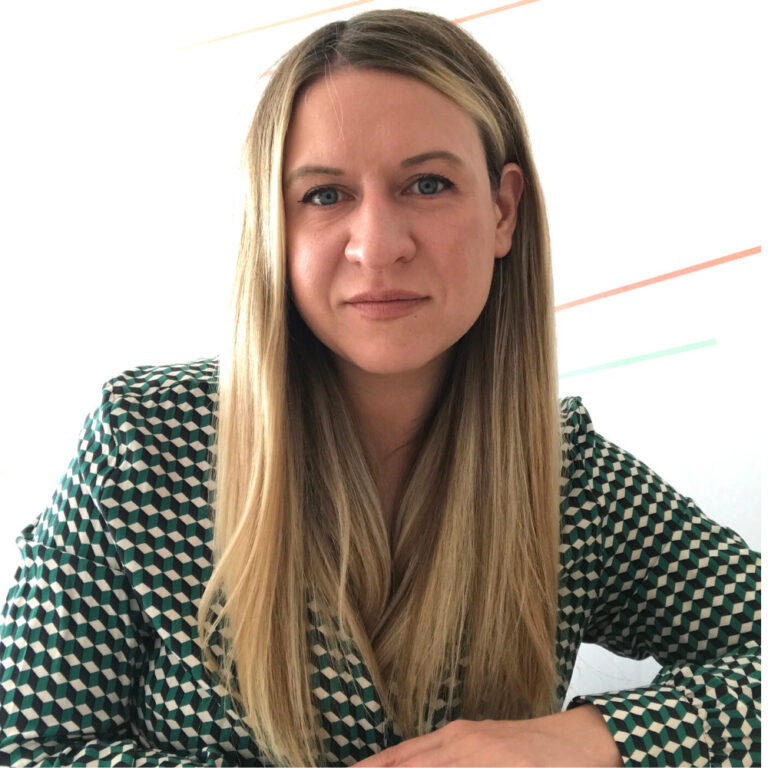
Essential Agile Retrospective
An Agile retrospective is a meeting held by a team at the end of a sprint to reflect on the recent work done and identify areas of improvement for the next sprint.
A retrospective focuses on the team's performance as a whole rather than individual contributions. Everyone gathers together to discuss both positive and negative aspects of the sprint and identifies what to do next.
Example Elearning Storyboard: How to Write Weird!
In this elearning storyboard template, you'll find an example of a storyboard I designed and used in a real-world client project for an online course.
I hope you find it a useful example of how you might structure an online course, format your learning content and add technical notes for your elearning developer to implement.
You'll find the complete storyboard for the first module of this course called How to Write Weird, which was designed for an audience of 13-17-year-olds interested in creative writing.
You can see some alternative methods of categorizing your elearning blocks in this collection of four standard instructional design templates or get some more inspiration in this guide on how to create a storyboard for elearning.
Want to learn more? Check out the complete guide to creating an elearning storyboard to see a step-by-step process for creating your oww storyboard.
Find your Climate Sweet Spot
Many people are motivated to work on climate issues but often don't know where to start or associate climate action with activism, protesting, or politics. What the world really needs is people working in all industries with many different skill sets working on climate issues. This workshop aims to help participants to help identify their sweet spot for working in the climate space.
The agenda design is for an online version of this workshop, but you can easily adapt the activities to different situations, for example by collecting ideas on sticky notes or a whiteboard instead of using an online chat setup.
Session Objectives
- Support attendees to identify their climate action sweet spot based on Ayana Elizabeth Johnson's Climate Action Venn Diagram.
- Allow attendees to connect with like-minded individuals/professionals who are also looking to make a positive impact
Desired outcomes from point of view of the attendee:
I felt inspired by all the ways I can contribute
I want to follow up with or connect with the people I met in my breakout room
I have concrete next steps for figuring out my personal climate action
Facilitator Tech support (managing breakouts + sharing messages in the chat)
Key resources
Find your climate your sweet spot workbook - check the attachments tab for the powerpoint presentation!
This template was the winner of the "Best use of SessionLab" award in the April 2023 innovative workshop design contest organized by SessionLab and NeverDoneBefore.

Impact on people and planet (with AI)
ESG reporting is coming. You might want to familiarise your workforce with the ESG concept (Environmental, Social, and Governance), so that the transition to a more sustainable business happens smoothly, while also touching on the potential and risks of using generative AI in daily tasks. The ESG framework helps you go beyond the conventional financial success metrics, by pushing you to consider not only the positive impacts that goods/ services and the operations to deliver them have on people and planet, but also the negative ones in order to minimise them.
Goal: Educate employees from different positions within a company about ESG framework (Environmental, Social, and Governance) and its importance, with the help of AI
Objective 1: Understand the ESG framework and its importance for product management
Objective 2: Identify key environmental and social principles associated with product management
Objective 3: Use an AI-generated text tool to answer questions and critically assess the results
Duration: 120 min
Type of activity: remote/ in-person
Participants: 15 to 30 employees
Materials: Laptops & access to internet
Tools: ChatGPT, video conferencing (Zoom/ Google Meet etc.), virtual space for collaboration (Google Sheets/ Miro) This template was the winner of the "Best Virtual Workshop" award in the April 2023 innovative workshop design contest organized by SessionLab and the NeverDoneBefore community.

Shared Book Insights Workshop
You know those times when you've read a fantastic book, and you wish everyone on your team would read it – and apply the learning to the business?
This session guide lays out a process to reduce the heavy task of reading a book alone to the lighter job of a shared effort. Information from the book and the ideas it inspires are applied to the company – all in just 120 minutes. The session design is based on a 10-participant team for a 300-page book. The total allocated time is 115 minutes with a 5-minute buffer.
For remote/online collaboration with the same sized team and book, the time allocation is 100 minutes, with a 20-minute buffer.
Due to the nature of the session, an icebreaker or warm-up is optional. Since participants arrive with pre-written Info & Ideas , they are excited to jump in and share them. However, if you do want to use up the 5-minute buffer for the icebreaker, you could ask them to share what snack they received in their package and how long it took them to eat it. 🙂
This template was the winner of the "Most innovative workshop design" award in the April 2023 innovative workshop design contest organized by SessionLab and NeverDoneBefore.

Team Self Management Workshop
This workshop from Switch to Eleven strategy & agile studio is designed to help teams improve self-management: improving autonomy, alignment, self-sufficiency, and trust among the group.
Participants begin by determining their current state of self-management using 8 areas:
Decision making
Regular feedback
Experimentation
Responsibility
Adaptability
Transparency
Next, the group considers where they would like to be and then ideate on ways to concretely improve self-management for the team. By the end of the session, the group has an action plan for making the desired change a reality!
You can use the attached Miro board when running this workshop online, though the workshop works great offline with post-its and flip charts!
Note that all timings are subject to change based on your group. Adjust to your needs!
Template created by Nina Pozderec at Switch to Eleven strategy & agile studio.

Decision-Making Meeting
The objective of this half-day session is for a team to reach a shared decision on how to solve a problem or challenge. The first part is a divergent process in which different ideas and proposals are collected. The second uses consent-based decision-making to refine a proposal and turn it into a decision.
Essential Online Event
Online events allow us to learn and meet from wherever we are. Quickly put together an agenda for your next virtual event based on these essential building blocks. Use breakout rooms and interactions in the chat and with polls to make presentations and lessons instantly more participatory and engaging for your attendees.
Simply click on Export, then Duplicate this model to tailor it to your needs and create the ideal session for your online event. For longer events, with multiple speakers, all you need to do is add a break and copy-paste the relevant parts of the structure.
Marketing Strategy Sprint
The Marketing Strategy Sprint is a step-by-step process for clarifying campaign creation or entire marketing strategies in a single working day. It works well in both remote and live settings and is especially useful for aligning marketing teams and decision-makers.
This is an ideal exercise for marketing teams. The optimal group size is 3–7 people. Someone from the business side and management board should be included. It can be the director/VP of the business area you are going to cover or in smaller companies the CEO, but it is crucial to have buy-in from the top. As a marketer, there is also the hidden agenda to give decision-makers a better understanding of the role of marketing. This is a perfect way to provide insight into what you do and are trying to achieve.
If the marketing & comms team isn’t big enough, just bring in bodies who are relevant to the topic/business. You need to understand your customer and business to get this to work so sales gals, customer success guys and other people working with the clients are your best bets.
You can do anything from campaign creation to overall marketing strategies. You just adjust your scope accordingly. I recommend starting with something specific like a campaign or a plan to target one audience. Then you can start combining the data into larger entities.
The whole canvas takes a workday to fill out. When you are working on campaigns or the same segment/product, it’ll take you two hours.
Obviously some problems are larger then others and you may need more time on solving them. That’s why you are the big marketing hotshot or the future unicorn CEO: you are able to use your own judgement on time allocation.
If you are starting your marketing, re-branding, doing a product launch, expanding to a new market etc., you’ll be spending a couple of days defining the cornerstones of your marketing.
People: a facilitator (You?), a marketing team, a decision-maker. Bodies are optional.
Other stuff: Whiteboard/wall space, tons of Post-it notes, Sharpies, sticky dots, a time timer, good coffee, a lot of water, some snacks, energy & enthusiasm.
The participants should be briefed to be on time and to have an open mind.
Everyone has one job to do before the workshop : use 15 minutes to list the competition and their main selling argument.
A voluntary, but preferred task is to watch Simon Sinek’s TEDx talk about understanding your WHY.
The idea of the workshop is to extract individual ideas. This is why for the majority of the workshop, work is done individually in a group. Unless stated otherwise, all of the exercises are done individually in silence.
Discuss only when the facilitator encourages it. This may seem odd in the beginning but trust the process. You will be surprised about the method outcomes.
After every stage the facilitator will photograph the results and add them to a slide deck and/or a physical canvas. A physical canvas is recommended, because this helps on maintaining focus of the end result and it is easy to revise the previous steps.
The voting process is the same throughout the workshop. Everyone is given a predetermined amount of dot stickers/vote. When the time to vote comes, everyone silently and simultaneously places their stickers on the note they want to vote for. You are allowed to vote on your own answers and you can spread your dots on different notes or put them all on one. This is up to you.
Tips for running this workshop online
Pick an online whiteboard tool that allows you to use a large, zoomable canvas.
If you’re not using an online whiteboard, we’d recommend using a collaboration tool such as Google Docs to collect the information for each step under a separate heading. Invite everyone into the document to share their ideas but be very clear in regards to editing rights.
When facilitating group discussion, we’d recommend that participants use non-verbal means to indicate they’d like to speak. You can use tools like Zoom’s nonverbal feedback tools, a reaction emoji, or just have people put their hands up. The facilitator can then invite that person to talk.
Use built-in dot voting tools or allocate dot shapes manually in your online whiteboard tool for the voting section. If using Google Docs or similar, have people comment as a vote.
Marketing Strategy Sprint from Karl Filtness at MEOM .
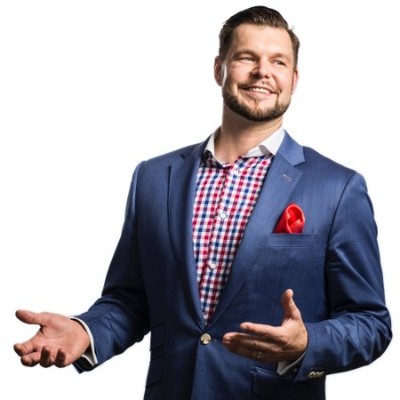
The Best Possible Team - Team Alignment Workshop
A team alignment workshop designed for remote and online groups. Facilitate a group through a collaborative process to develop a new, shared understanding of " what it means to be us ", and how to tell and promote it to others throughout the organization.
This workshop can easily be reproduced in a physical environment, which allows more participants (for the same number of facilitators).
This workshop includes 3 exercises 1) The positive shared journey as a team, 2) The best possible team and 3) Story Theater.
- Capitalize on the positive experiences that connect members to increase the quality of relationships between group members
- Develop a new, shared understanding of a team functioning at its best
- Build the team's identity
- Use storytelling techniques to enhance communication
- Zoom - to recreate a physical environment
- 2 facilitators (Facilitator A, Facilitator B)
- Number of participants: Ideally 10 people (2 groups of 5 participants)
- Target group: Teams / groups of people already working together for some time.
Team Canvas
- creating a team;
- clarifying goals and addressing overall team performance (e.g. when you feel stuck as a team, or when you need to get a lot of stuff done);
- growing and onboarding new team members;
- general alignment sessions (recommended every 2-3 months
Download the Team Canvas template and mobile-friendly How To at http://theteamcanvas.com

Crafting a Key Message Workshop
This short workshop introduces participants to a simple method for crafting the "key message" around which a presentation, elevator pitch, email or conversation (or any other individual piece of communication) will be designed.
This workshop can be delivered as a stand-alone session to build transferrable skills, or it can be one module in a series of short skills development workshops offered weekly/fortnightly over a period of time. It can be delivered as part of a one- to two-day presentation or communication skills programme.
This template assumes that it will be run as a stand-alone workshop and includes time for set-up and conclusions - these can be removed as needed. This template also assumes that participants know each other, so no time has been included for participant introductions - you may need to build this in if you have a mixed group.
By the end of this workshop, participants will have learned a 5-step process for creating a key message that they can use in their communication (presentations, conversations, emails, pitches etc.) to tailor their message to their audience and keep their communication clear and focused.
Participants:
Ideal for 8-12 participants in person, or up to 20 online (more than that and you need to factor in more time for discussions)
Templates: (both attached.)
Simple Key Message Planner template (recommended):
Key Message Planner with Example (for use when talking participants through the planner):
The Three-Hour Brand Sprint
https://library.gv.com/the-three-hour-brand-sprint-3ccabf4b768a
GROW Retrospective Template
With this retrospective format you can track the team's progress and continuous improvement of their way of working from iteration to iteration. It is recommended to use the same GROW retrospective format after each iteration (sprint) so that the progress is followed more easily and team has the sense of continuity.
Goal : Identify team's current level of satisfaction with how they collaborate and work together and define actions for their further growth (leveling up).
Materials : Menti or any other app that allows for anonymous voting
Time: 40 - 60 minutes
Group: up to 10
Difficulty: Low
Credits for this template to Growit, the Belgrade-based agile consultancy for sharing this template.
Growit – Committed. Bold. Truly Agile.
Hybrid Community Event
This 1-day community event is designed to enable participants in-person and online to reflect back on the past year and design next steps for the future. This design was created for a professional organization of coaches that meets yearly (for the first time, this was a hybrid gathering). The goals of this template include: - networking among members; - retrospective and learning from the past year; - co-creating ideas and projects for the future. The template showcases how to use SessionLab's breakout function to display parallel timelines for the different groups in hybrid events.
Self-Awareness Workshop to Develop Your Emotional Intelligence
This workshop introduces Daniel Goleman’s areas of development for emotional intelligence and invites the teams to explore their understanding and awareness of their own emotions.
Together we will work through activities and discuss our understandings and learnings of Emotional Intelligence. Everyone can learn how to recognize their emotions and identify areas of development. Each person will leave the workshop with an action plan to improve their emotional intelligence skills in order to increase team productivity, connection and trust.
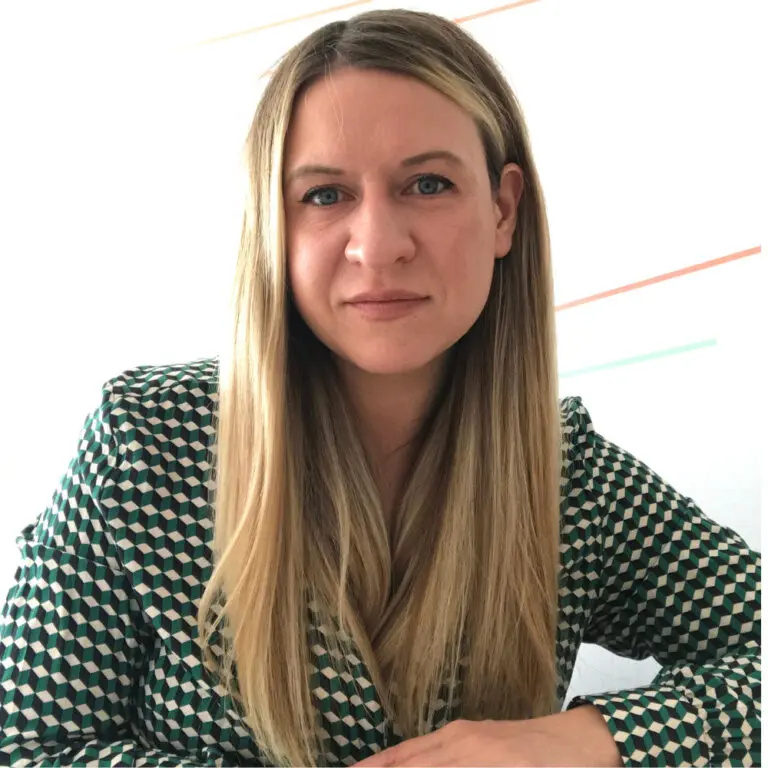
Open Space Technology Session
Open Space Technology is one of the greatest methodologies for tapping into a group's energy, creativity and passion.
It leads to unexpected outcomes and therefore requires a lot of trust in the group. Has been used in settings ranging from 12 to thousands of people (with a serious lot of logistics), on and off-line. Requires at least half a day, and can go on for days. Open Space is also a great way to end a longer event or festival (or to organize one). Created by Harrison Owen in the 1980s.
Design Thinking for Beginners
The term "Design Thinking" can often seem daunting to people who are new to the idea, we can introduce the subject by making it fun and digestible.
In this workshop, we will learn and understand the five stages of the Design Thinking process by relating each stage to an everyday project.
In this case, we’ll go through the process of designing a cake for our friend. By tackling a small task together, we can familiarise ourselves with Design Thinking, and use these stages to tackle bigger projects in future.
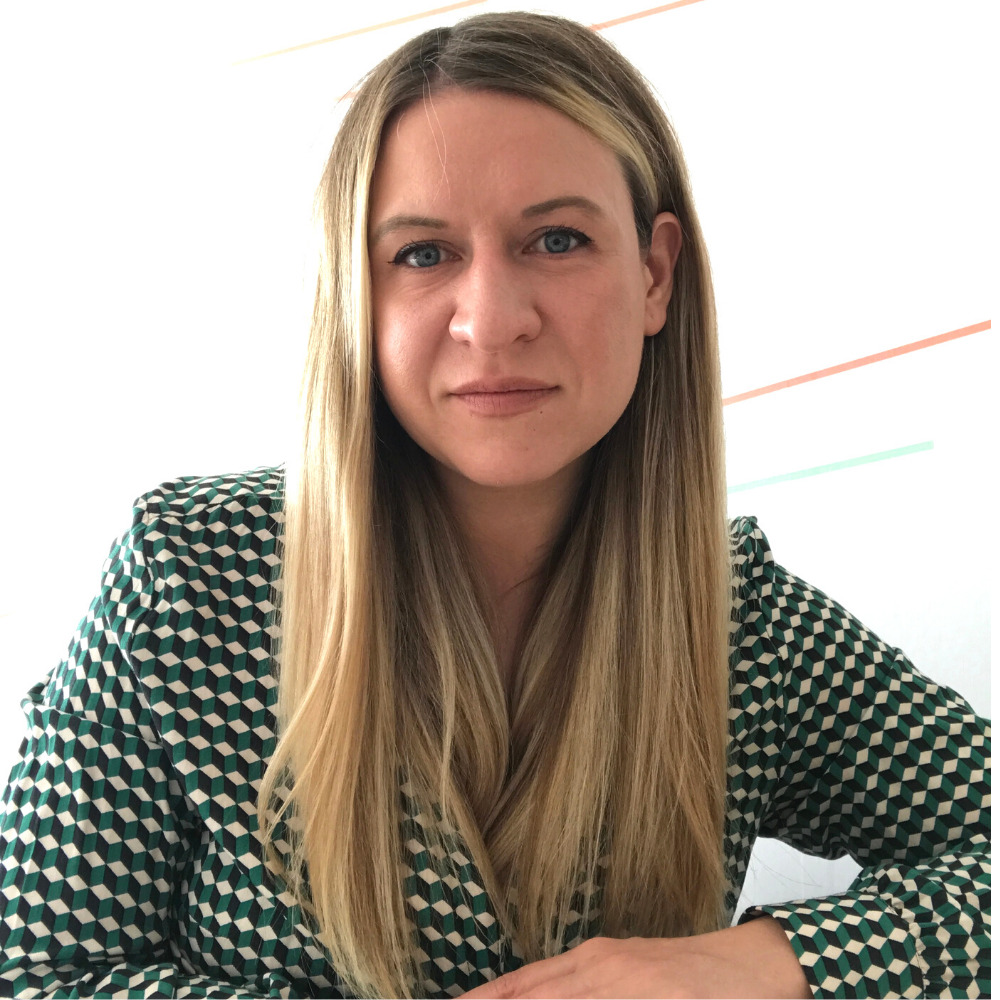
Remote problem solving workshop
Objectives:
- Identify what your current organizational challenges are.
- Generate ideas for effective, quick to implement solutions and choose which solutions to implement.
- Choose a video conferencing tool to host the meeting - Zoom, Google Hangouts, Adobe Connect or whatever tool your organization prefers is fine!
- Choose an online collaboration tool to work in - you might use an online whiteboard tool such as Mural or Miro, or collaboration tools such as Slack and Google Docs. We have instructions for both in this template :)
- Choose one person from the group to be the facilitator and lead the group through the process.
- Choose one person from the group to be the decision-maker, who whenever teams are deadlocked on a vote, can make the final call. Should be a senior team member or applicable team lead.
- Have a co-facilitator to moderate the text chat channel of your video conferencing tool and/or lead certain sections of the agenda. Facilitation is hard work - share the load where possible!
Feature Sprint for Startups
You'll align on what your MVP (minimum viable product) is and generate customer-centric features you can move towards developing too! This process can help quickly clarify and solve many of the problems young start-ups have, for example :
- Teams that have been “going in circles” when talking about next steps
- Have a lot of ideas but don't have a starting point
- Lack clarity about the specific value proposition for marketing, web, and social content
Use built-in dot voting tools or allocate dot shapes manually in your online whiteboard tool for the voting section. If using Google Docs or similar, have people comment to indicate a vote.
Want more context? Watch this video from Justin on how the feature sprint helped Vera, a plant care app.

Persona Empathy Workshop
Personas are one of the most popular tools in user research , and are a great way to create shared understanding about users. But they are useless unless people know what they are and how to utilize them .
Designed for research or user-focused teams who want to help others in their organization understand the value and importance of customer personas , this 1-hour 20 minute workshop agenda is highly focused step by step process that is simple and easy to run.
- You'll demonstrate the power of personas and how preconceptions about users and customers are often incorrect .
- Your team will gain some of the tools necessary to better empathize with users and employ personas across the organization
- You'll generate ideas on how to solve problems and meet the needs of your chosen customer persona
This workshop is intended for groups and organizations that are already using or start to use customer personas and who are trying to extend the understanding and use of personas across an organization. You may run this with participants in less user-focused parts of the organization, or to begin demonstrating the value of personas to your team in a concise, effective way.

The Scent of Shame
🌈 Smell Your Way Home: Experimental exploration to disarm shame and activate inner wisdom.
In this interactive and playful environment, participants have the opportunity to:
- Explore the roots of shame and how it affects your life
- Identify triggers that lead to feelings of shame and self-doubt
- Learn strategies for recognizing and challenging shame-based thoughts and behaviors
- Engage in gentle movement and breathing exercises to regulate your nervous system
- Connect with others who are on a similar journey of self-discovery and healing
- Leave with a renewed sense of self-acceptance, self-compassion, and confidence
Using a combination of group discussion, creative expression, and somatic techniques, participants learn how to build resilience and embrace vulnerability as a strength.
Whether they are struggling with shame related to past experiences, current challenges, or simply the pressures of daily life, this workshop will provide them with the tools and support they need to move forward with greater clarity, resilience, and self-awareness.
This template was the winner of the “Community Choice” award in the April 2023 innovative workshop design contest organized by SessionLab and the NeverDoneBefore community.

Enterprise Design Starter Kit
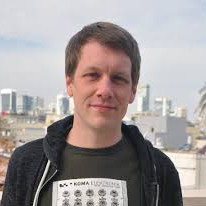
Emotional Culture Workshop
Get your Emotional Culture Deck at: https://www.ridersandelephants.com/the-emotional-culture-deck

Retrospective
The retrospective is a great way to debrief a team after a period of work has been completed .
This could be anything from a long-term project, to a short workshop. Therefore the activities in this agenda can be lengthened or adapted, depending upon your desired outcomes.
This session is designed to be run remotely , and it will give the participants time to reflect, assess the outcomes of the recent project and organise their next steps by prioritising the tasks which would be most beneficial to them.
WARP Remote Retrospective
A plan for a remote retrospective using the WARP (wishes, appreciation, risks, puzzles) format and Google Jamboard.
Meaningfully reflect on the end of a period of work with your virtual team
Create action points for the future based on the WARP framework - Wishes, Appreciations, Risks, and Puzzles
Detail steps to be taken, work to be completed, and ownership of future actions that emerge from the retrospective
When should this session be delivered?
The WARP remote retrospective session should be delivered at the end of a project, initiative, or period of work such as the end of a sprint. So long as you are clear with your team about the period of time/work you are focusing on, your retrospective can be both exhaustive and succinct.
Who can facilitate it?
While any facilitator or leader can lead the remote retrospective effectively using the instructions and notes in the template, being familiar with agile retrospective concepts such as the retrospective prime directive can help ensure the success of this workshop.
Acknowledgments
This remote retrospective plan has been inspired by the Spotify Retro Kit .
The 5 stages of retrospective are from the book Agile Retrospectives by Esther Derby and Diana Larsen.
Jamboard template for this retrospective here .

Large group workshop agenda - from World Bank Development Forum
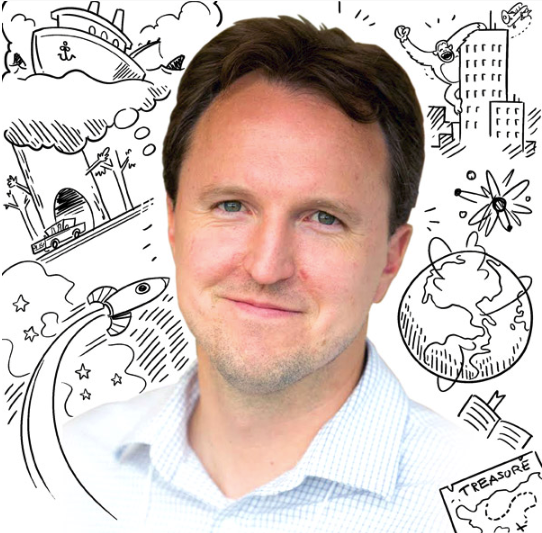
Team workshop with WonderCards

Options Map Workshop

Collaborative Rapid Prototyping
Source: Google Design Sprint Kit

The materiality analysis workshop - a powerful tool for sustainable development

Communication for Youth

Activating a Culture of Wellbeing in the Nonprofit Workplace

Conversation Cafe: A World Dialogue Relay
This template has been designed for hosts planning a World Dialogue Relay event for UN75 on 24 October 2020.
This Conversation Cafe agenda includes a series of step-by-step elements that will help you guide a group through a structured discussion. This template has been developed by the team at X360 for open use drawing on the UN75 Toolkit and the UNA-USA resources . It is available for use by Connected Conversations dialogue hosts and facilitators everywhere
The agenda elements are designed to be delivered over 2 hours , however, please feel free to adapt this based on the size of your group, and your own facilitation and hosting style. You can even adjust the Conversation Cafe format for your own events and needs!
Before your session
- Review the hosting and facilitation guide at https://connversations.x360.co/relay/
- Register your session on the IdeaSphere at https://ideasphere.x360.co/add-listing/
- Encourage participants to take the UN75 survey in advance, to get the conversation going in their minds and online: www.un.org/UN75
- Designate a note-taker to capture the key points from your dialogue
Capturing feedback
We will provide you with a link to an online feedback form in a format provided by #UN75 to capture your group's conversation. This form will include the following details:
- Main topics covered (from the UN themes + any others)
- Dialogue type (online or in-person)
- Country where the dialogue was hosted
- The top 1-3 ideas for each topic discussed and/or a summary in max 750 characters
- Nationality of participants
- Education level of most participants
- Occupation of most participants
You can choose to complete this feedback process during your session as a group, or summarise notes for submission after the session.
Tips for hosting the session
The facilitator plays a crucial role in these conversations. Some broad guiding principles include:
- Communicate clearly on why the dialogues are taking place, and where the discussion will go
- Respect and facilitate the sharing of different perspectives
- Constructively address conflicting positions and power imbalances
- Adapt to local needs
- Ensure some element of recording and feedback (an online feedback form will be provided)
Tips for running the session online
- Choose a video conferencing tool to host the your group conversation - Zoom, Google Hangouts, Adobe Connect or whatever tool your group prefers is most familiar with is your best bet.
- If facilitating with very large groups, use breakout rooms to help facilitate productive conversations in smaller groups before bringing them back into the main room.
You might want to posit your questions alongside visual resources and collect feedback and notes using an online whiteboard tool . This is great for creating a resource people can revisit after the session. But don't forget that you'll need to share a summary of the group discussion via the online feedback form provided.
When facilitating group discussion, we’d recommend that participants use non-verbal means to indicate they’d like to speak. You can use tools like Zoom’s nonverbal feedback tools, a reaction emoji, or just have people put their hands up. The facilitator can then invite that person to speak.
Use an online engagement tool such as Mentimeter or Poll Anywhere to get quick feedback at the start of each conversation point, or where it feels appropriate.
Don't hesitate to reach out to the X360 convening team if you need assistance or you have any questions. You are also invited to join the online collaboration space for the World Relay at https://ideaspace.x360.co .
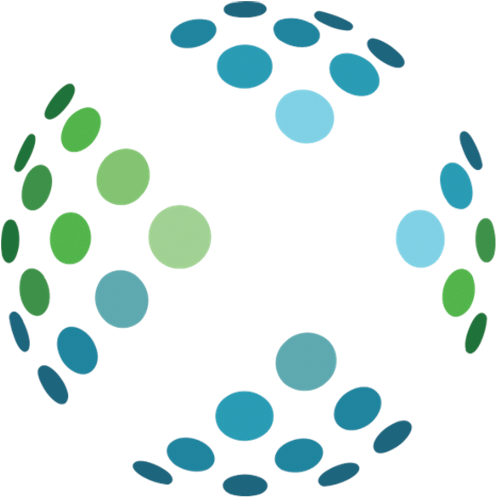
End-of-Year Virtual Team Event
Have fun , review the year, and give appreciation to each other with this 3-hour virtual holiday team event.
A detailed agenda with all the tips and tricks on how we ran online our holiday team building activity at SessionLab in 2020!
Train the trainer - 7 day event schedule

Want to get your own workshop template featured in the Template Library and help others engage their workshop participants?
Contact us at [email protected]

How it works
For Business
Join Mind Tools
Article • 9 min read
Planning a Workshop
Organizing and running a successful event.
By the Mind Tools Content Team
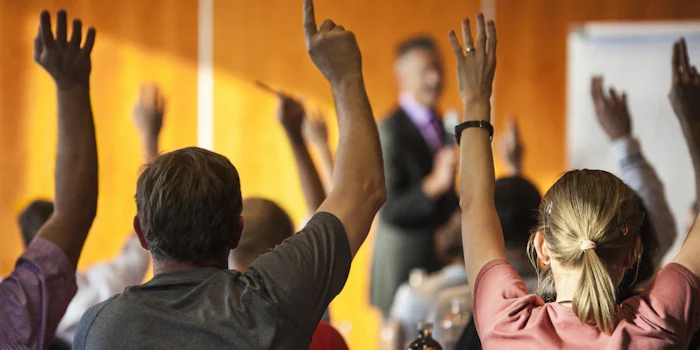
Anyone who has ever planned a workshop will tell you that it's a big job. And planning a good one? Well, that takes organization, focus, and a lot of creativity. So how do you prepare for a workshop that will be not only relevant and productive, but memorable?
Some people hate going to workshops. Done wrong, they can be a huge waste of time and money. However, if they're planned well, they can be incredibly valuable for everyone involved. Workshops are great for brainstorming, interactive learning, building relationships, and problem-solving. This is why advance planning is critical.
Before the Workshop
Follow these steps to make sure your workshop is a valuable experience for everyone:
1. Define the Goals
Every workshop must have a goal. Do you need to improve your company's hiring procedures? Do you want to teach managers how to be better organizers? Do you need to do some team building with a newly formed team?
Many workshops are a waste of time because there's no clear goal kept at the center of the discussion. Without this clear goal, there's really no point in getting people together.
2. Decide Who Will Attend
Knowing who will attend directly relates to your objective. For example, if your workshop's goal is to develop a detailed solution to a problem, then you probably want 10 or fewer key attendees. If your goal is centered on education, then you might be happy with a much larger group, which divides into smaller groups for discussion.
Make a list of who needs to be there. Try to be as specific as possible, but leave a few openings for last-minute additions.
3. Choose the Right Location
If you have 10 attendees, then the conference room down the hall will probably be just fine. But if you have 50 people, you may have to find an outside location that's large enough.
Think about the logistics and practical details of your workshop when you choose the location. Will everyone be able to see your visual aids? If you need a certain technology, like teleconferencing, will the location support it? Are there appropriate facilities for breakout sessions? Will everyone be able to reach the venue? Will you need to organize accommodation for people who are coming from a long way away? And what catering facilities does the venue provide?
4. Create an Agenda
Now that you know your primary objective and who will attend, you can start to develop an outline of how you'll achieve the workshop's goal.
- Main points – Create a list of main points to discuss, and then break down each larger point into details that you want to communicate to your audience.
- Visual aids – List the visual aids, if any, you'll use for each point. If you need technical support, this helps the people providing it to determine where they need to focus their efforts.
- Discussions and activities – Take time to list exactly which group discussions and activities you'll have at which point in the workshop. How much time will you allow for each exercise? Make sure your activities are appropriate for the size of the group, and ensure that your venue has the resources (for example, seminar rooms) needed to run sessions.
Remember, the more detailed your plan, the more you'll ensure that your workshop will run to schedule – and be successful.
5. Develop a Follow-up Plan
The only way to find out if your workshop was a success is to have an effective follow-up plan. Create a questionnaire to give to all participants at the end of the event, and give them plenty of opportunities to share their opinions on how well it went. Although this can be a bit scary, it's the only way to learn – and improve – for the next time.
It's also important to have a plan to communicate the decisions that were reached during the workshop. Will you send out a mass email to everyone with the details? Will you put it on your company's intranet? People need to know that their hard work actually resulted in a decision or action, so keep them informed about what's happening after the workshop has ended.
During the Workshop – Getting People Involved
Once you have a solid advance plan, figure out how to bring some excitement into your event. You know the topics that you want to cover, but how will you make the information fun and memorable for your team?
Getting everyone involved is key to a successful workshop. If you stand up and talk for three hours, you're just giving a lecture – not facilitating a workshop. Everyone needs to participate.
Creating group exercises is different for each workshop. Keep these tips in mind:
- Many people are nervous about speaking in public , or in an unfamiliar group. If you plan group exercises, keep the size of each group small, so people are more comfortable talking and interacting.
- Mix up different types of people in each group. For example, if several departments participate in your workshop, don't put members of the same department in their own group. By encouraging people to interact with other departments, they can learn to look at things from different perspectives.
- Determine how you'll record the ideas from each group. Will participants shout them out while you write them down? Or will they write down their own ideas and then give them to you? This is a small, but important, detail that's often overlooked.
- If you have five or fewer groups, spend time allowing the entire team to evaluate the ideas from each smaller group. This is a great way to narrow down your list of ideas, and let the good ones really shine.
Remember, spend as much time as you can creating fun and interesting group exercises. These will likely keep everyone interested and participating.
Overall Workshop Tips
Here are some more ideas for running a successful workshop:
- If you plan the meeting, you may want to facilitate it as well. Learn how to do this effectively in The Role of a Facilitator .
- Be sure to establish the objective of your meeting or session. Read our article, Running Effective Meetings , for more on this.
- Start the meeting with a few ice breakers to get everyone relaxed and comfortable.
- If your workshop's goal is to address a difficult or sensitive topic, it's especially important to get the group comfortable before starting. One way is to tell a story that's loosely related to the topic before you begin discussing the difficult issue.
- Sometimes, not everyone has to stay for the entire workshop. For instance, the CEO might be too busy to attend the whole session. Identify which sections your busiest participants need to attend, and suggest in advance when they might want to arrive and leave. They'll appreciate your consideration.
- Where possible, avoid holding your workshop after lunch, between 2:00 and 3:00 in the afternoon. For many people, this is their slowest, most unproductive time of day. Your group will probably be more energetic if you schedule the event in the morning or late afternoon. (If you have to run the workshop in the early afternoon, make sure there's plenty of strong coffee available!)
- If your workshop's ultimate goal is to make a decision about something, the more people who attend, the less likely it is that you'll reach a decision. Here, try to keep the number of people attending to a minimum (for example, by issuing minutes after the event to people who are just interested.) It's also important to become familiar with the different strategies for team decision making. See our article on Organizing Team Decision Making to learn more.
There's no doubt that planning a great workshop is a lot of work. But if you spend time thinking through the details, everyone will get full value from the event.
The workshop's goal should be at the center of all your planning. Creative exercises will get everyone relaxed and involved, and don't forget to follow up afterward: although it can be scary to hear what people really thought of all your hard work, it's the only way you'll improve your next event.
You've accessed 1 of your 2 free resources.
Get unlimited access
Discover more content
How to do an impact analysis.
Predicting Unexpected Consequences
What Is Discrimination?
Recognizing and Responding to Unfair Treatment
Add comment
Comments (0)
Be the first to comment!

Get 30% off your first year of Mind Tools
Great teams begin with empowered leaders. Our tools and resources offer the support to let you flourish into leadership. Join today!
Sign-up to our newsletter
Subscribing to the Mind Tools newsletter will keep you up-to-date with our latest updates and newest resources.
Subscribe now
Business Skills
Personal Development
Leadership and Management
Member Extras
Most Popular
Latest Updates

Creative Decision-Making

Making the Most of Your Induction
Mind Tools Store
About Mind Tools Content
Discover something new today
The talisman of leadership.
Authenticity
Managing Presentation Nerves
How to Calm Your Stage Fright
How Emotionally Intelligent Are You?
Boosting Your People Skills
Self-Assessment
What's Your Leadership Style?
Learn About the Strengths and Weaknesses of the Way You Like to Lead
Recommended for you
Why being a generous leader can make you a great leader.
Show People Why They Matter
Business Operations and Process Management
Strategy Tools
Customer Service
Business Ethics and Values
Handling Information and Data
Project Management
Knowledge Management
Self-Development and Goal Setting
Time Management
Presentation Skills
Learning Skills
Career Skills
Communication Skills
Negotiation, Persuasion and Influence
Working With Others
Difficult Conversations
Creativity Tools
Self-Management
Work-Life Balance
Stress Management and Wellbeing
Coaching and Mentoring
Change Management
Team Management
Managing Conflict
Delegation and Empowerment
Performance Management
Leadership Skills
Developing Your Team
Talent Management
Problem Solving
Decision Making
Member Podcast
Problem Solving Activities
All the Problem Solving Activities on this page help you and your group collaboratively tackle seemingly impossible issues.
If you are looking to build consensus around a difficult problem it is likely a tool or process on this page can help you.
[…] Problem Solving […]
Excelent summary thanks so much for this purposeful help
Session expired
Please log in again. The login page will open in a new tab. After logging in you can close it and return to this page.
Enter your email to receive your FREE tools & activities.
We will never share your email address with anyone.

IMAGES
VIDEO
COMMENTS
Problem-solving workshop format. The following sections describe each step of the process. Agree on the Problem(s) to Solve. American inventor Charles Kettering is credited with saying that "a problem well stated is a problem half solved." At this point, the teams have self-selected the problem they want to address.
Come up with ideas to solve the problem. 4. Evaluate the ideas to ensure they're robust. 5. Make a plan to test or implement the solution. Read on to find out how to do all that, and more. 1. Get the right people together. Invite all affected parties to a session.
The Problem-Solving Workshop is an effective way to identify and solve problems in the context of Product Management and User Experience. It allows for a collaborative approach to problem-solving, which can lead to more creative and effective solutions. It also allows for a structured approach to problem-solving, which can help ensure that the ...
Just a few examples of creative problems to solve using the creative problem solving process are: Shaping a strategy for your organization. Developing or improving a new product or service. Creating a new marketing campaign. Bringing diverse stakeholders together to collaborate on a joint plan.
A typical problem-solving workshop can take many forms but include the following steps: ️ Define the problem: Clearly define and understand the problem (s) to be addressed. ️ Brainstorming: Encourage open discussion and the sharing of ideas, allowing participants to think freely and creatively. ️ Analysis and evaluation: Analyse and ...
Step 1: Agree on the problem to solve. Clearly stating the problem is key to problem identification and correction. It enables more focused investigation, time-saving, and avoids 'ready, fire, aim' approach. On the other hand, a problem that is not well defined, may result in failure to reach the proper countermeasure.
Problem solving has 4 key elements. First is we need to do it now while the evidence is fresh. "Go and See" at the workplace or Gemba in Japanese. Will not solve problems in the office or behind the computer. Just like CSI ! Maximise the chance of seeing the problem and getting the best data /evidence you can.
A problem-solving workshop is a structured approach to address a particular challenge or issue that a team or organization is facing. The workshop is designed to bring together a diverse group of individuals with different perspectives, skills, and knowledge to collaborate on identifying and solving the problem at hand. The workshop typically involves a series […]
To make the workshop mean anything, you need someone with authority to make decisions and assign people work. It can be one or many people. It can be the facilitator. Having this person in the room is really important. In fact, if you don't have a decider in the room, your workshop will most likely be a waste of time.
Workshops are a great format for solving problems. With the right approach, you can focus a group and help them find the solutions to their own problems. But designing a process can be time-consuming and finding the right activities can be difficult. ... Each step of the problem-solving workshop benefits from an intelligent deployment of ...
Finding the best solution is the goal of all problem solving workshops and here is the place to ensure that your solution is well thought out, sufficiently robust and fit for purpose. 5. Decision making . Nearly there! Once your group has reached consensus and selected a solution that applies to the problem at hand you have some decisions to make.
Consider the size of the group, the space you have available, and the nature of the problem you're trying to solve. Ideally, you'll focus on two or three ideation techniques in one session. 7. Gather your ideas and outline next steps. Throughout the workshop, it's important to document all ideas that are put forward.
A3 is a versatile problem-solving method and continuous improvement tool. It's called A3 because it fits on a standard sheet of paper. ... For best results, the A3 should be filled out collaboratively in a workshop format. The amount of time required depends on the scope of the problem and stakeholders' schedules, but the process of filling ...
Problem-solving workshop format. The following sections describe each step of the process. Agree on the Problem(s) to Solve. American inventor Charles Kettering is credited with the statement that "a problem well stated is a problem half solved." At this point, the teams have self-selected the problem they want to address.
Provide them with the necessary materials to work the problem, ideally based on paper. For example, for a layout workshop, give them a large printout of the shop floor map, plenty of paper in different colors, scissors, tape, glue, and so on. Let them work on the problem without giving much instruction on the problem-solving method.
A workshop for a team to reflect on past conflicts, and use them to generate guidelines for effective conflict handling. The workshop uses the Thomas-Killman model of conflict responses to frame a reflective discussion. Use it to open up a discussion around conflict with a team. 280. Use Method.
1 Analyze a situation and its causes. The first step to resolution is identifying the actual root cause of the issue at hand. The key word here is "root.". It may take some time to investigate the situation and learn that the "obvious" source of the issue is actually not causing the problem.
A3 Strategy Form (from Getting the Right Things Done) A strategy A3 is a one-page storyboard on 11-inch by 17-inch paper that helps tell the strategy "story.". Logic flows from top left to bottom right, and each box leads to the next one. Download.
In this episode of the McKinsey Podcast, Simon London speaks with Charles Conn, CEO of venture-capital firm Oxford Sciences Innovation, and McKinsey senior partner Hugo Sarrazin about the complexities of different problem-solving strategies.. Podcast transcript. Simon London: Hello, and welcome to this episode of the McKinsey Podcast, with me, Simon London.
A problem-solving workshop designed from the ground up for remote teams and those working online. Facilitate a group through a collaborative problem-solving process remotely and generate quick, effective solutions! ... This one day workshop format is designed for teams of designers, architects and stakeholders, and can be used for exercise ...
However, if they're planned well, they can be incredibly valuable for everyone involved. Workshops are great for brainstorming, interactive learning, building relationships, and problem-solving. This is why advance planning is critical. Before the Workshop. Follow these steps to make sure your workshop is a valuable experience for everyone: 1.
All the Problem Solving Activities on this page help you and your group collaboratively tackle seemingly impossible issues. If you are looking to build consensus around a difficult problem it is likely a tool or process on this page can help you. Free Download. Download our 3 most popular tools. Sen d me the Top 3.
Clinic Format and Registration. This session will be open to a limited number of attendees. During this session, OAHP provides an update on the status of HOME-ARP allocation plans, distribution of funding by activity, and expenditures to date. Additionally, attendees will have a chance to ask OAHP questions about HOME-ARP reporting requirements.